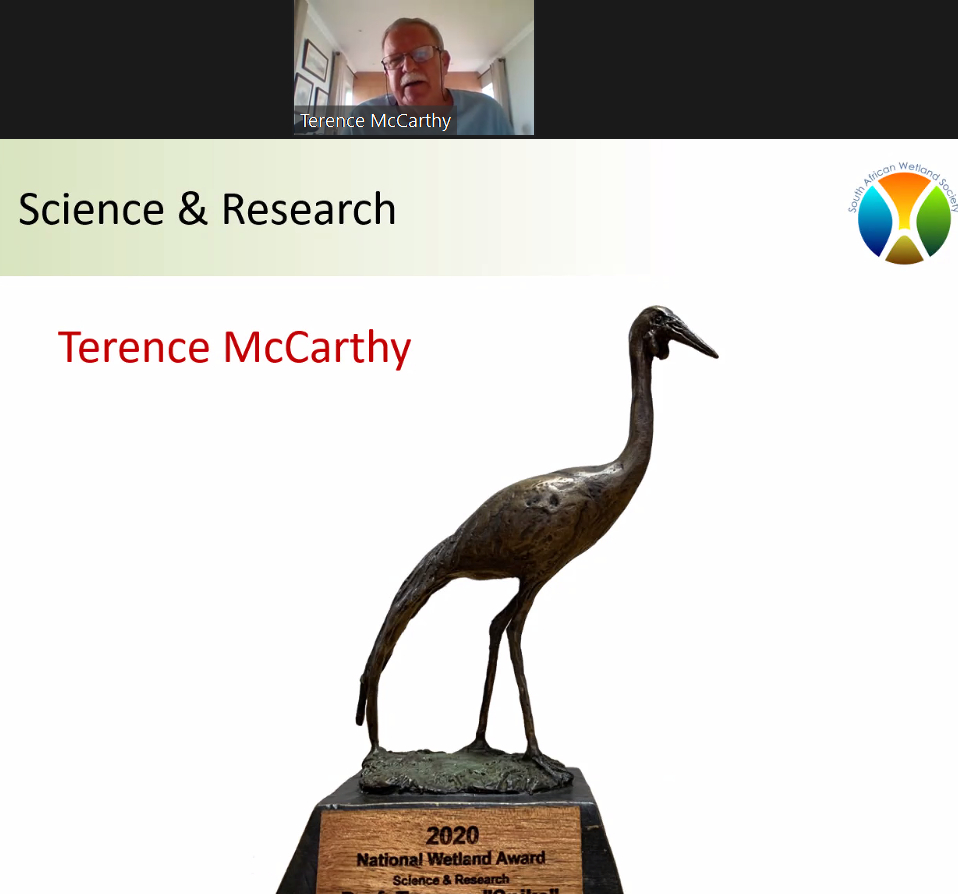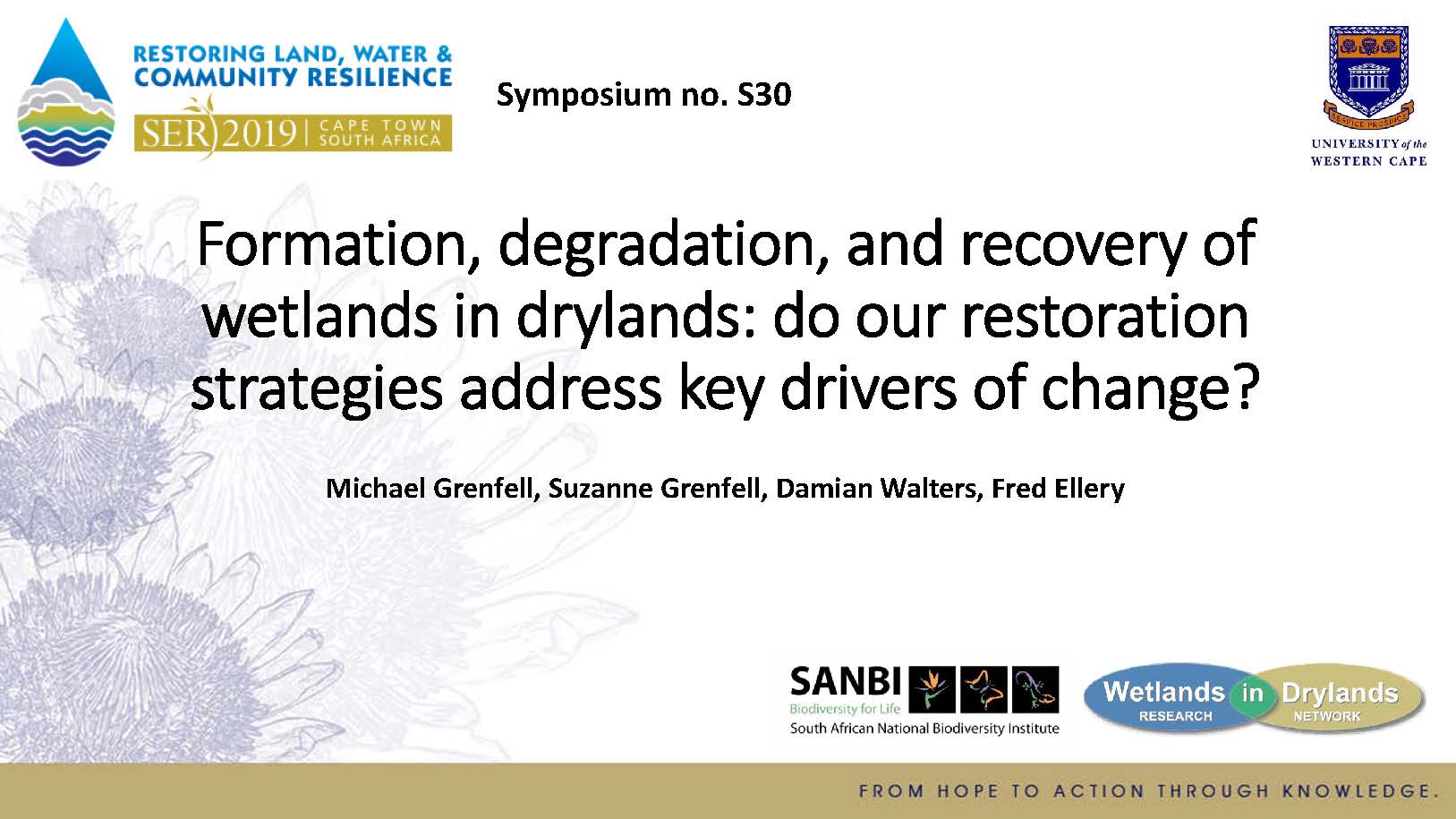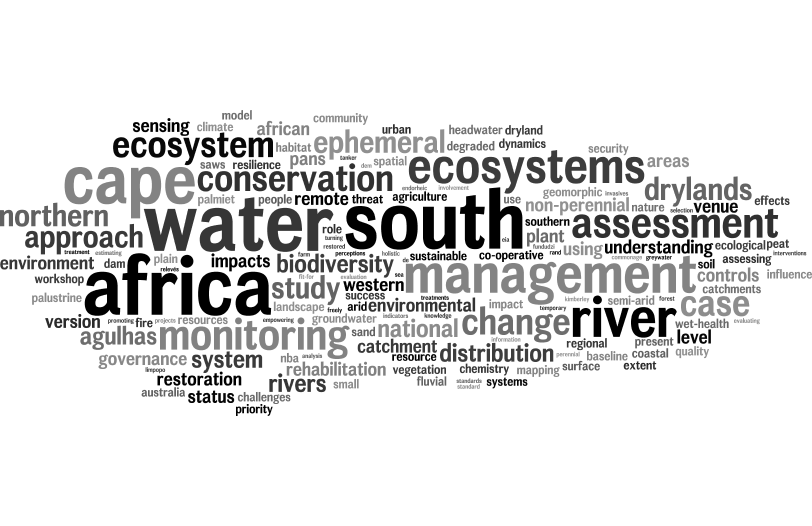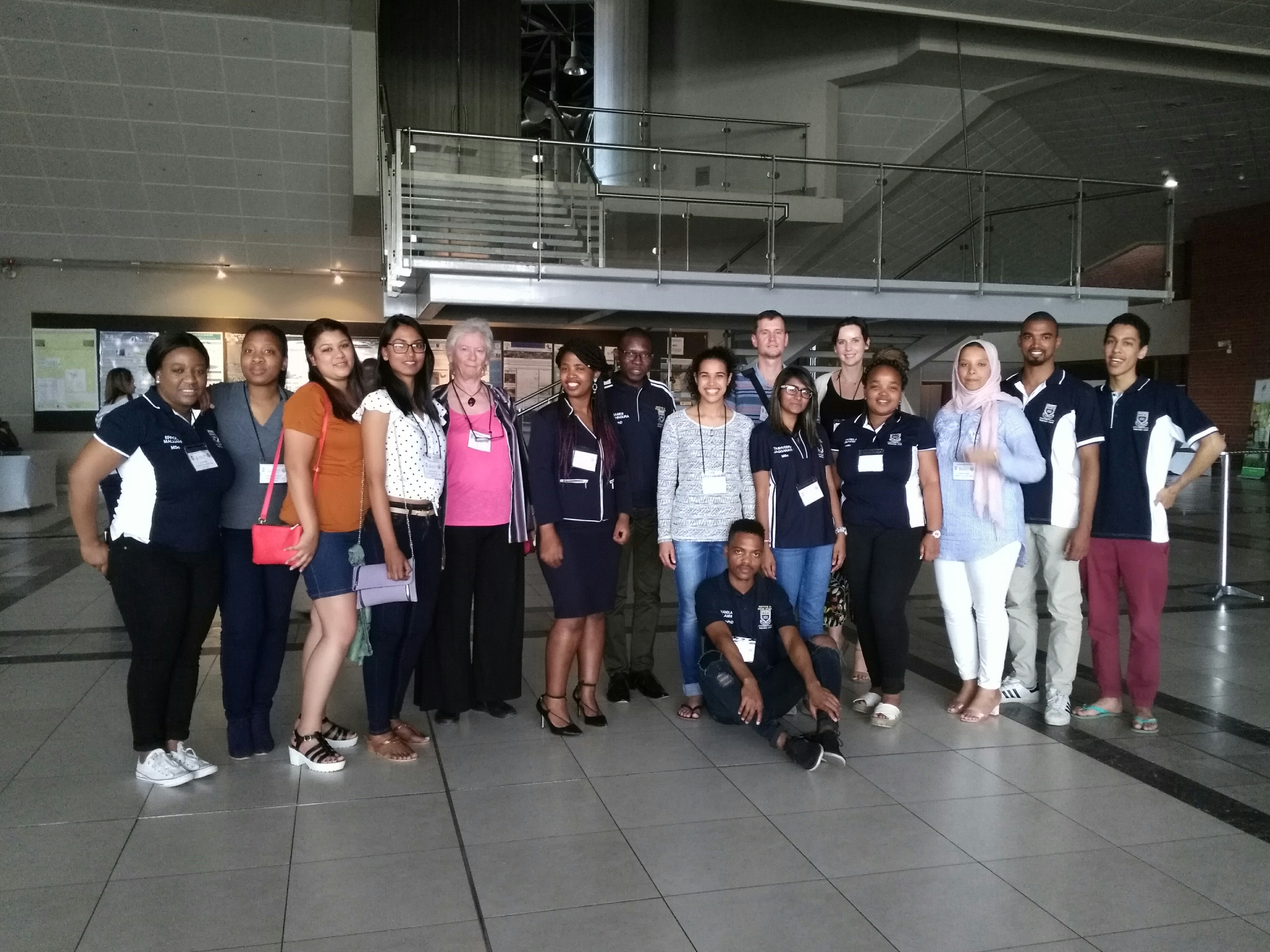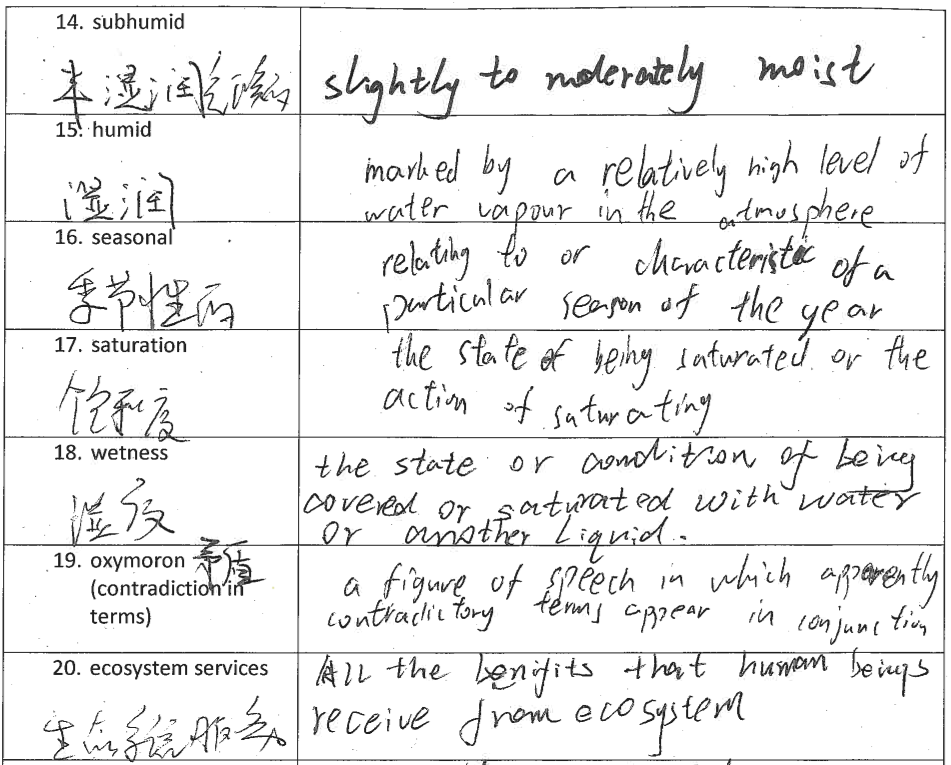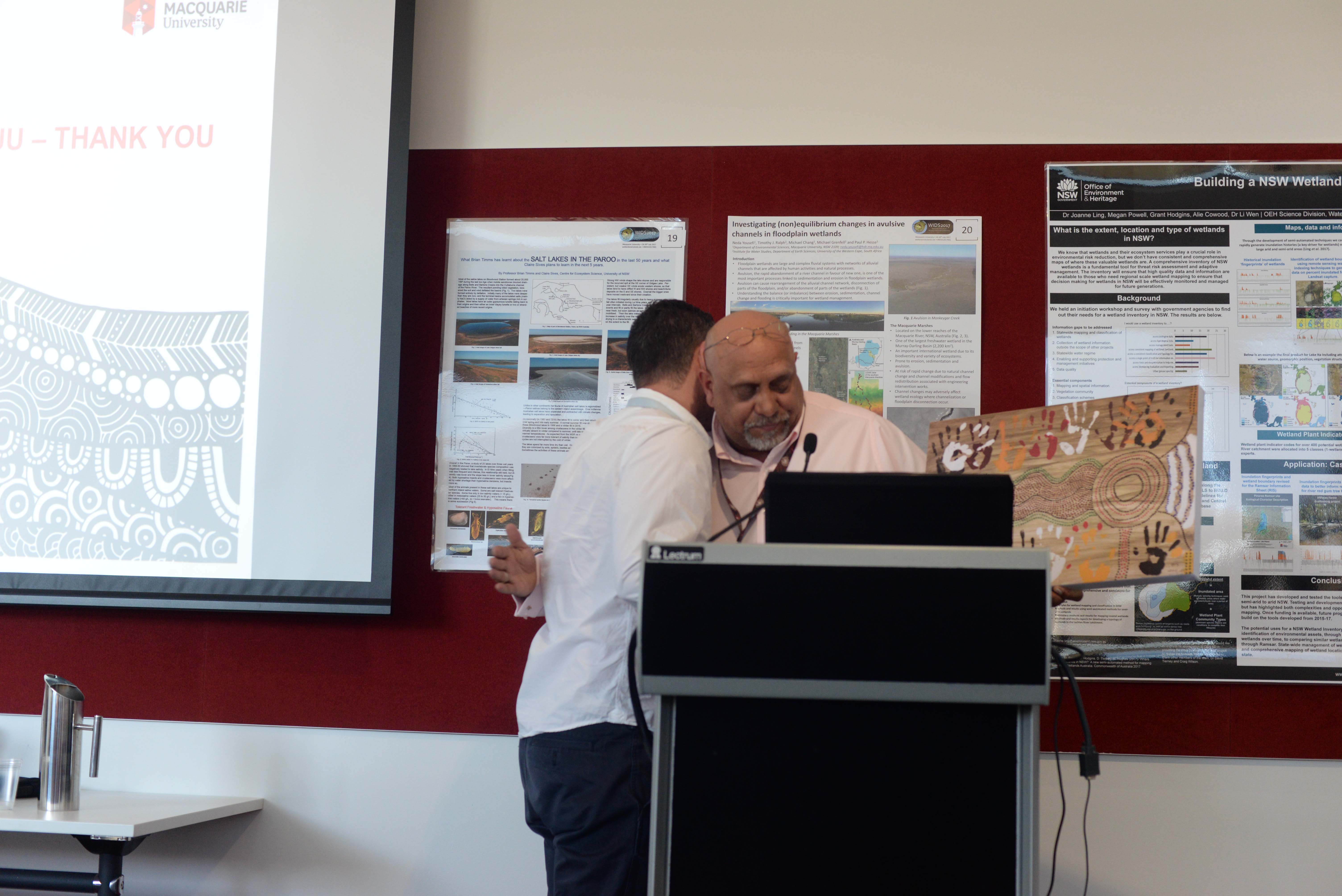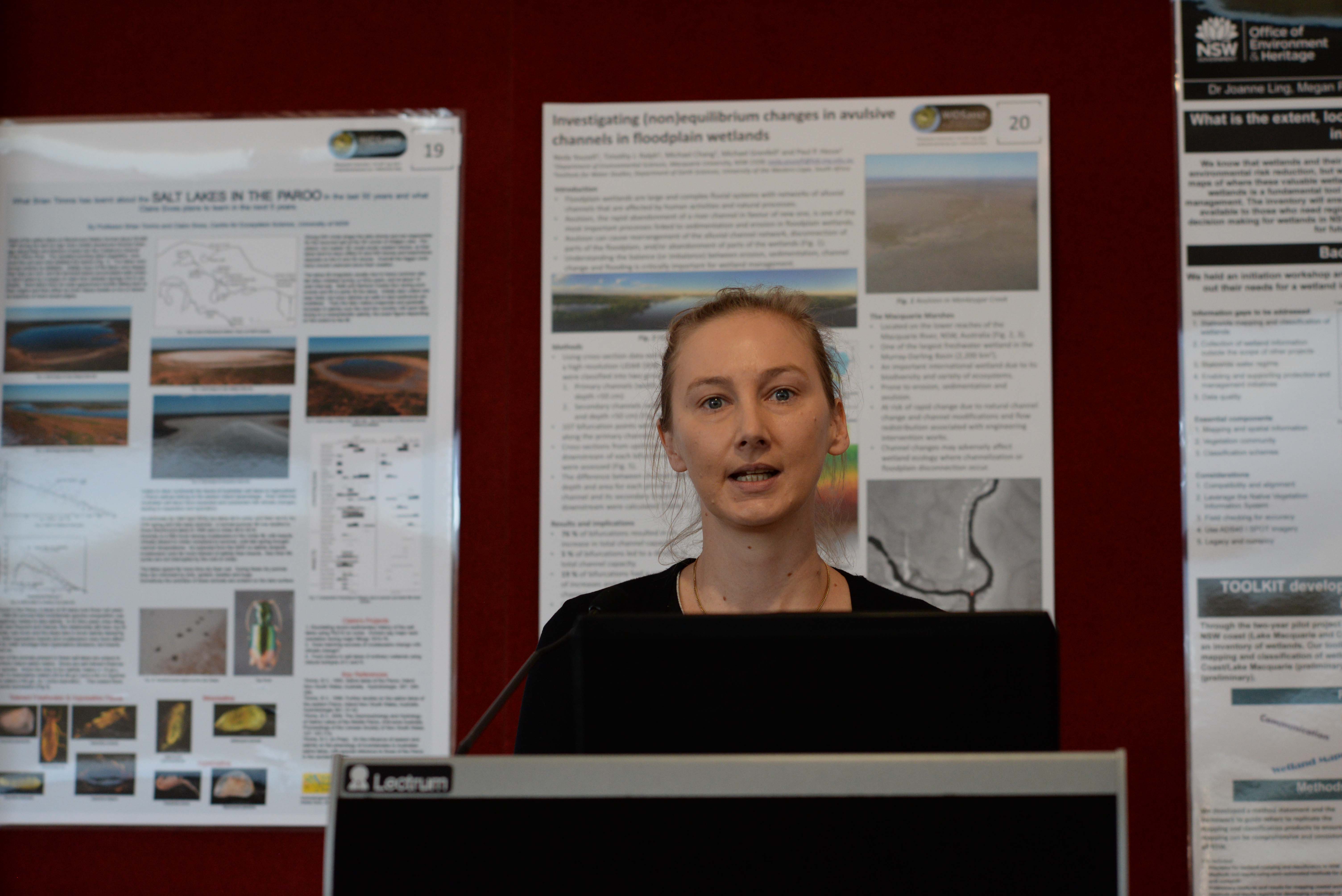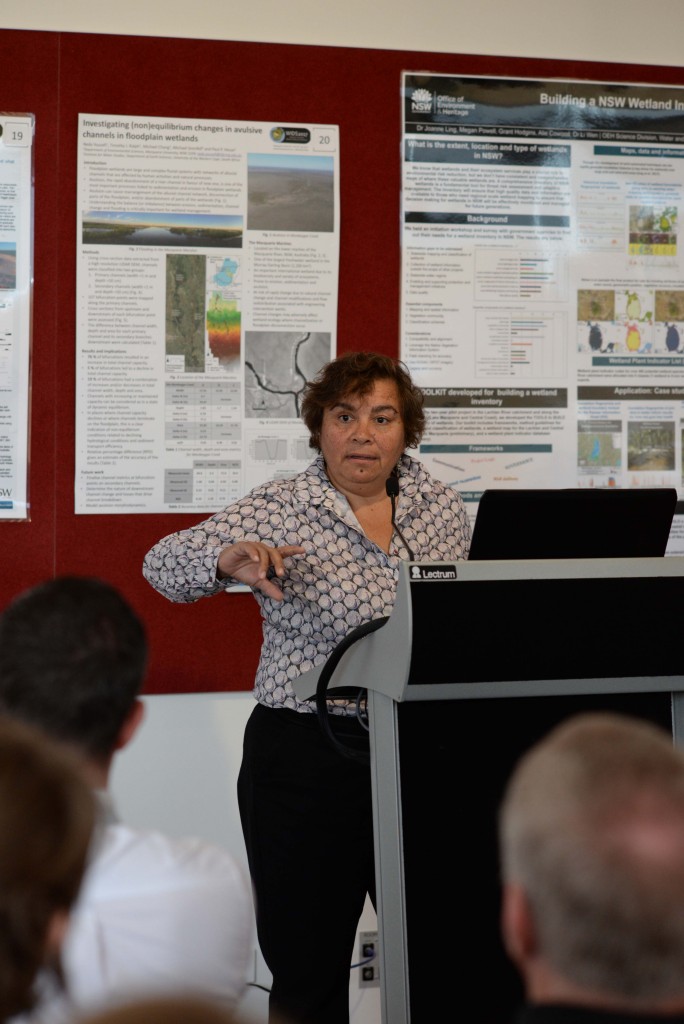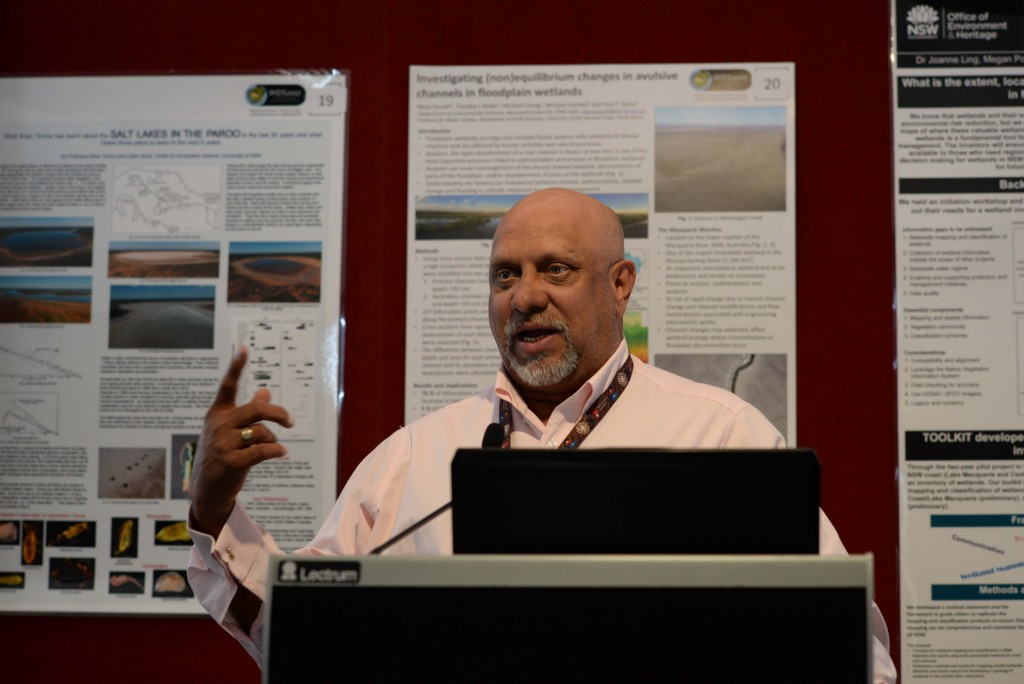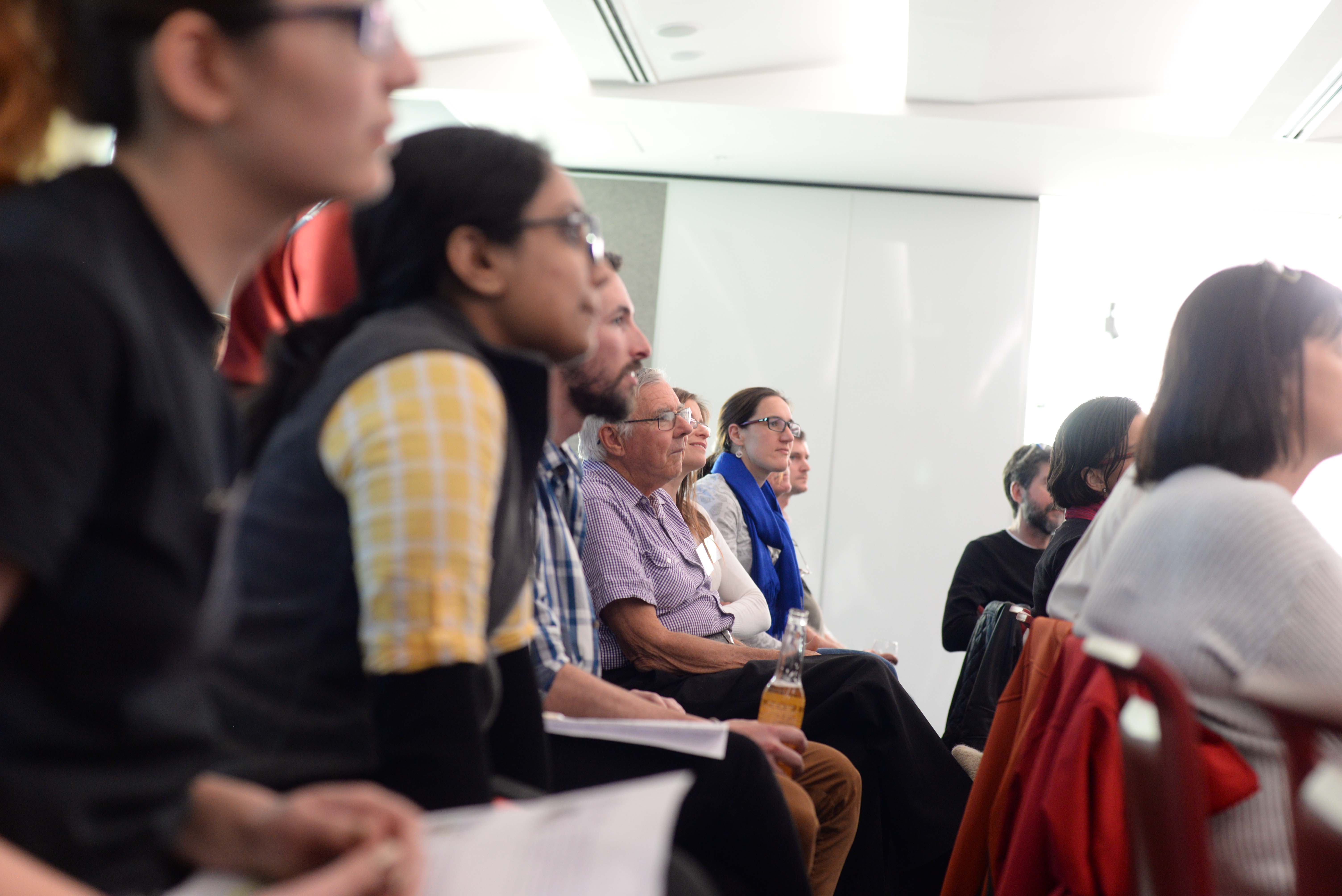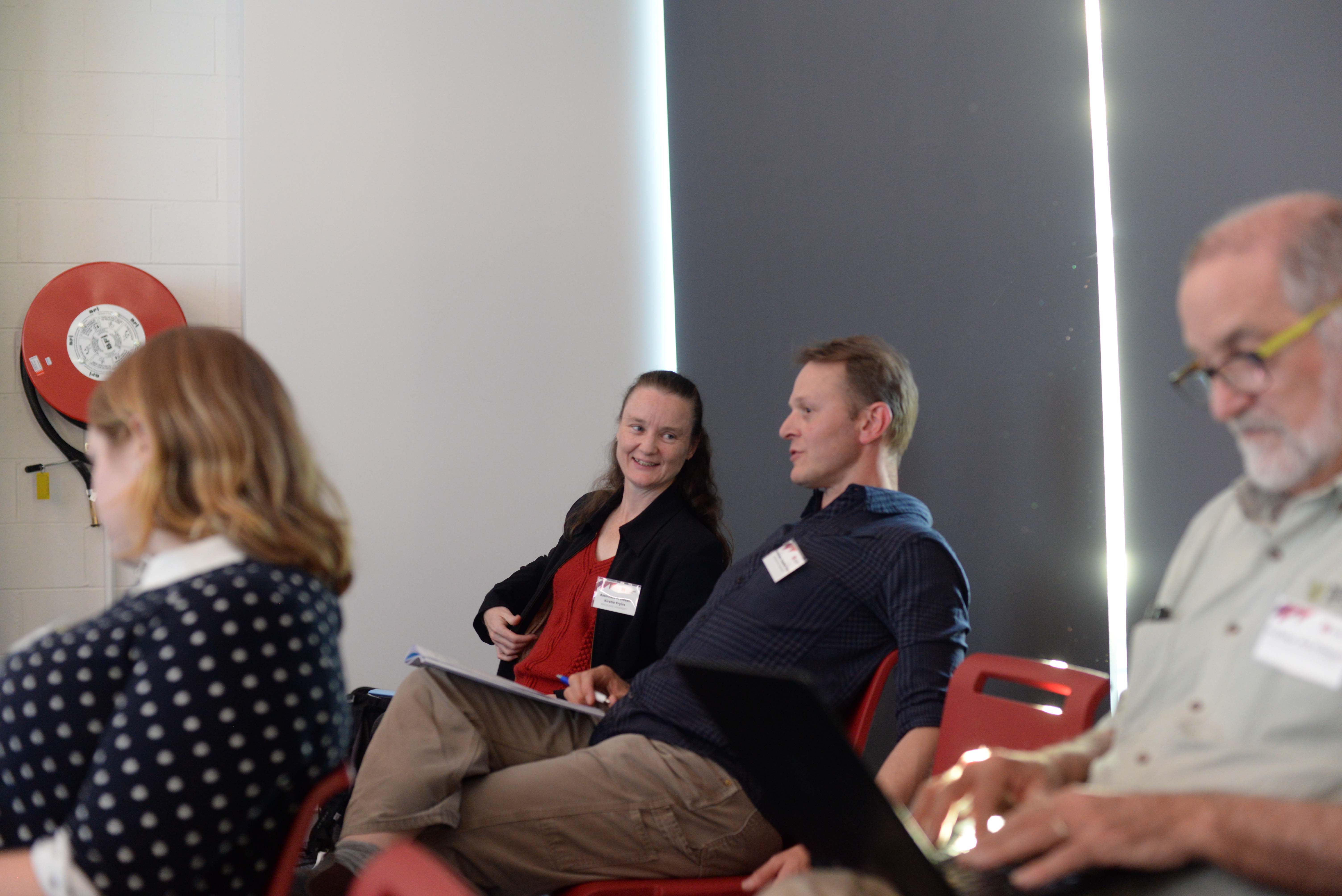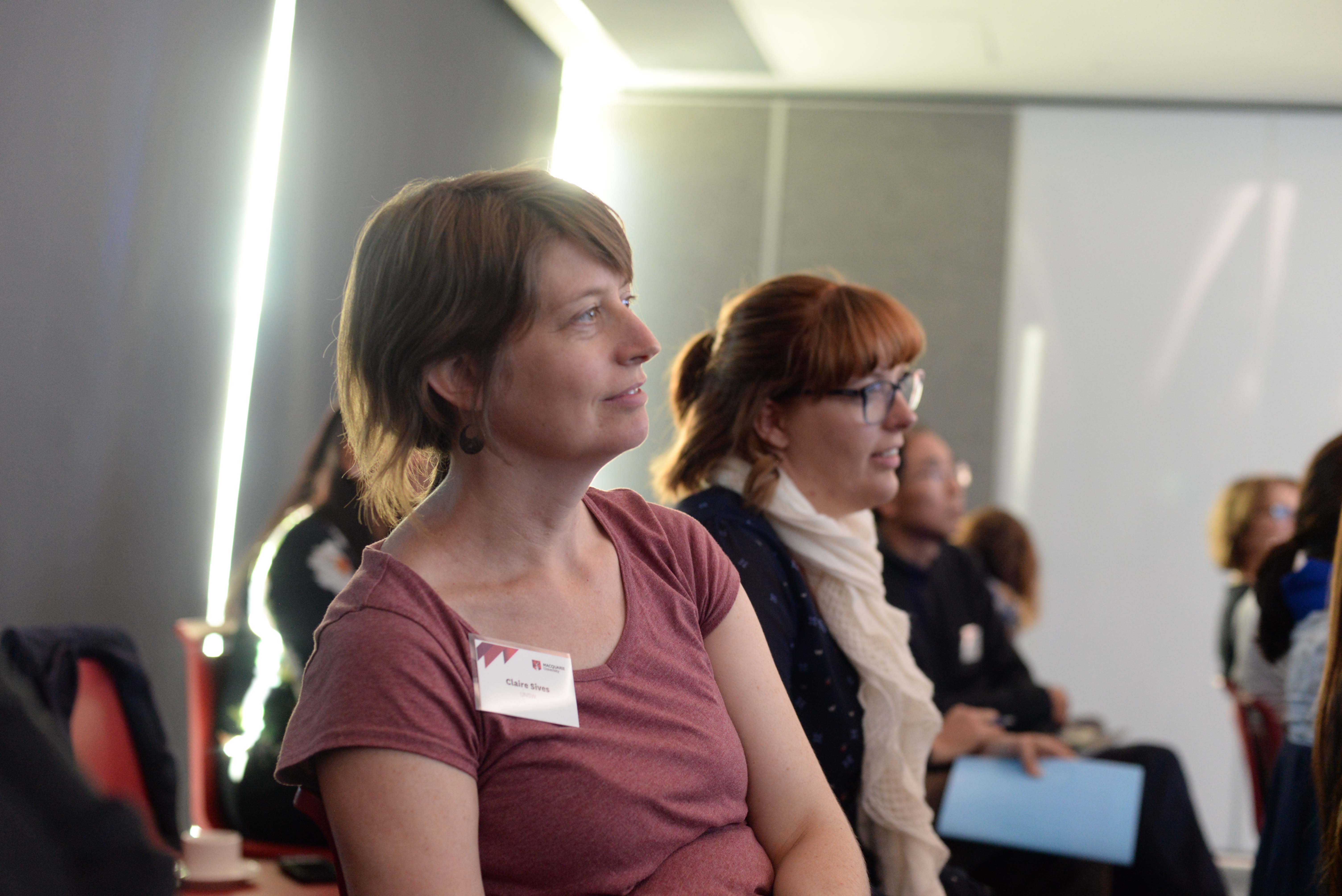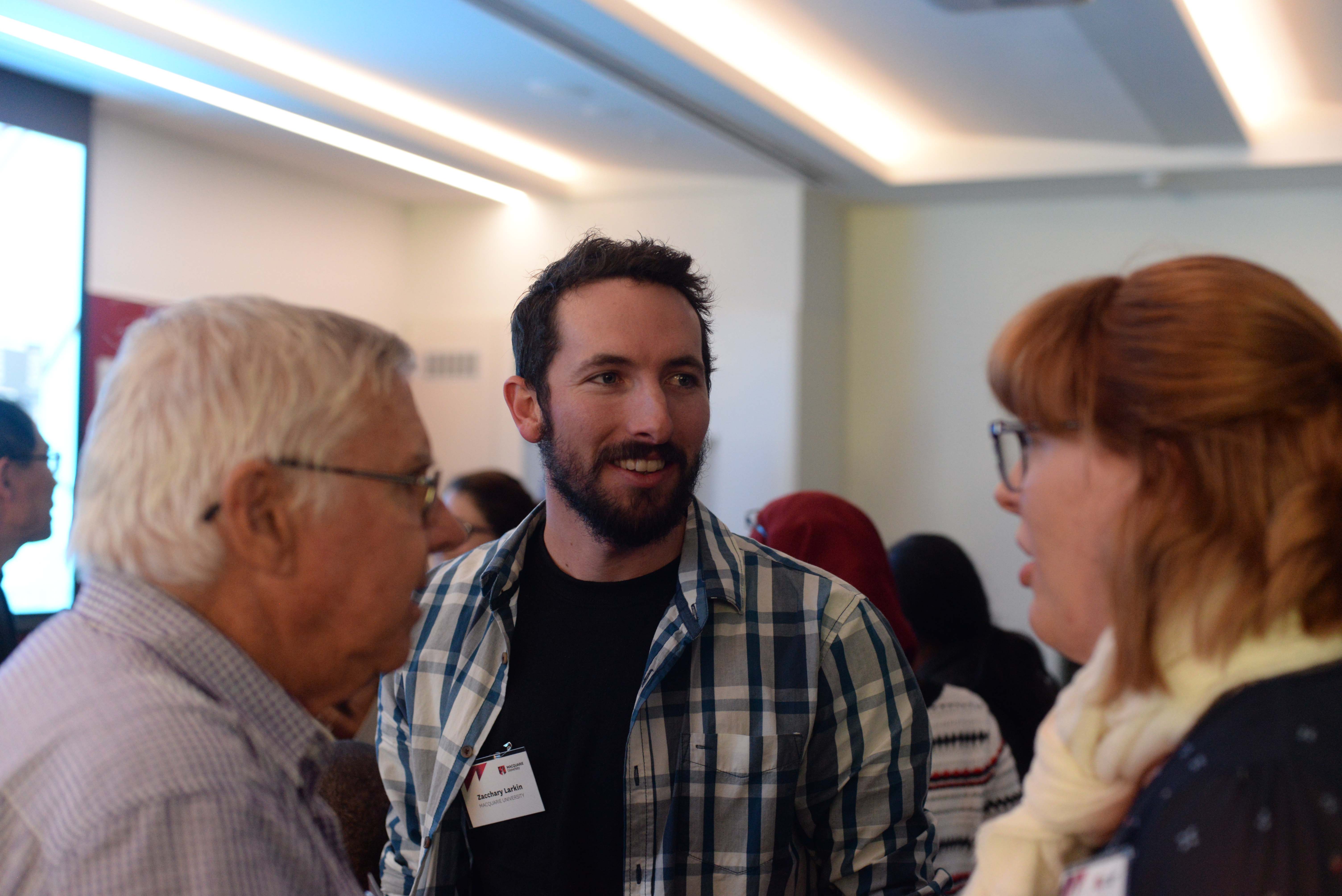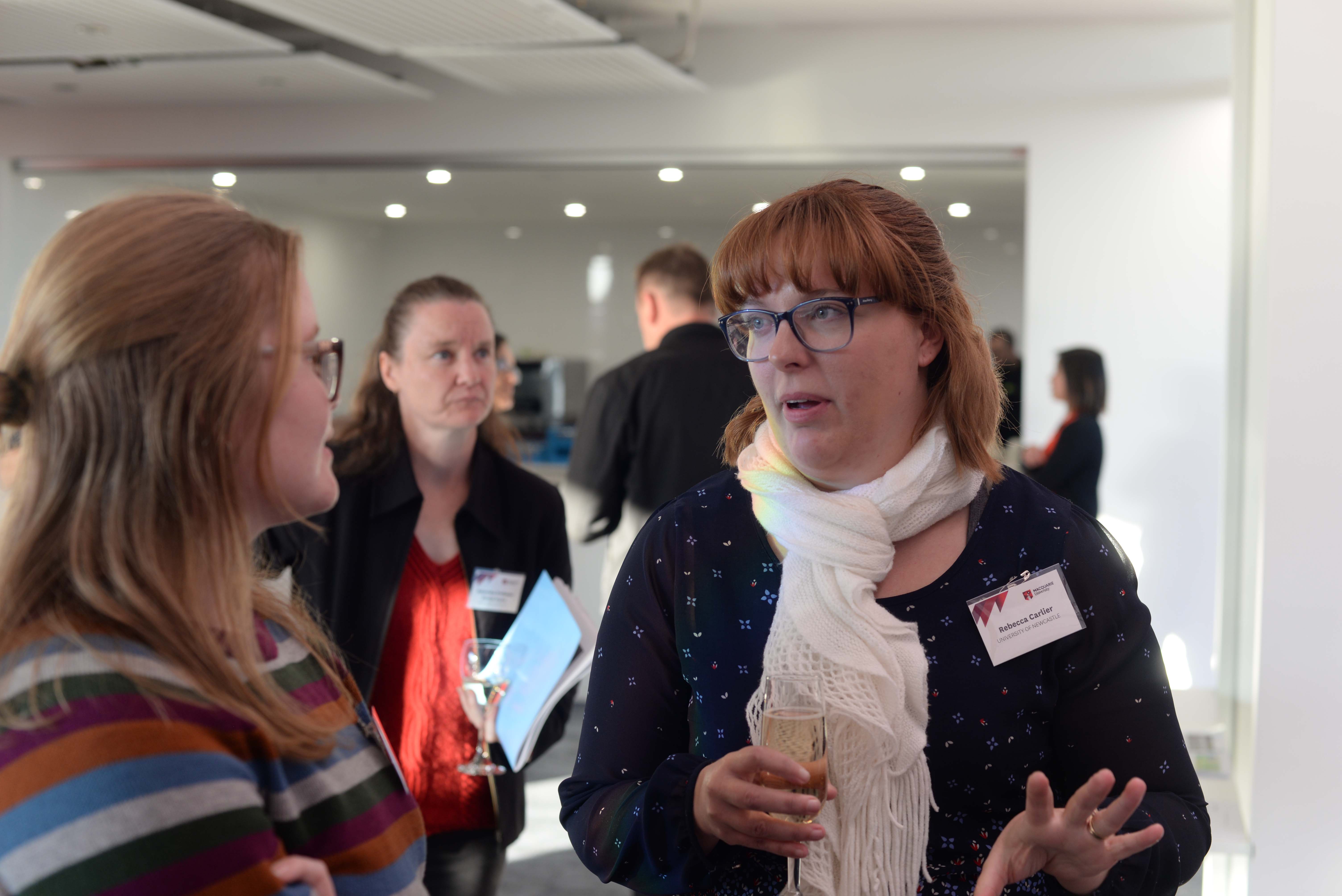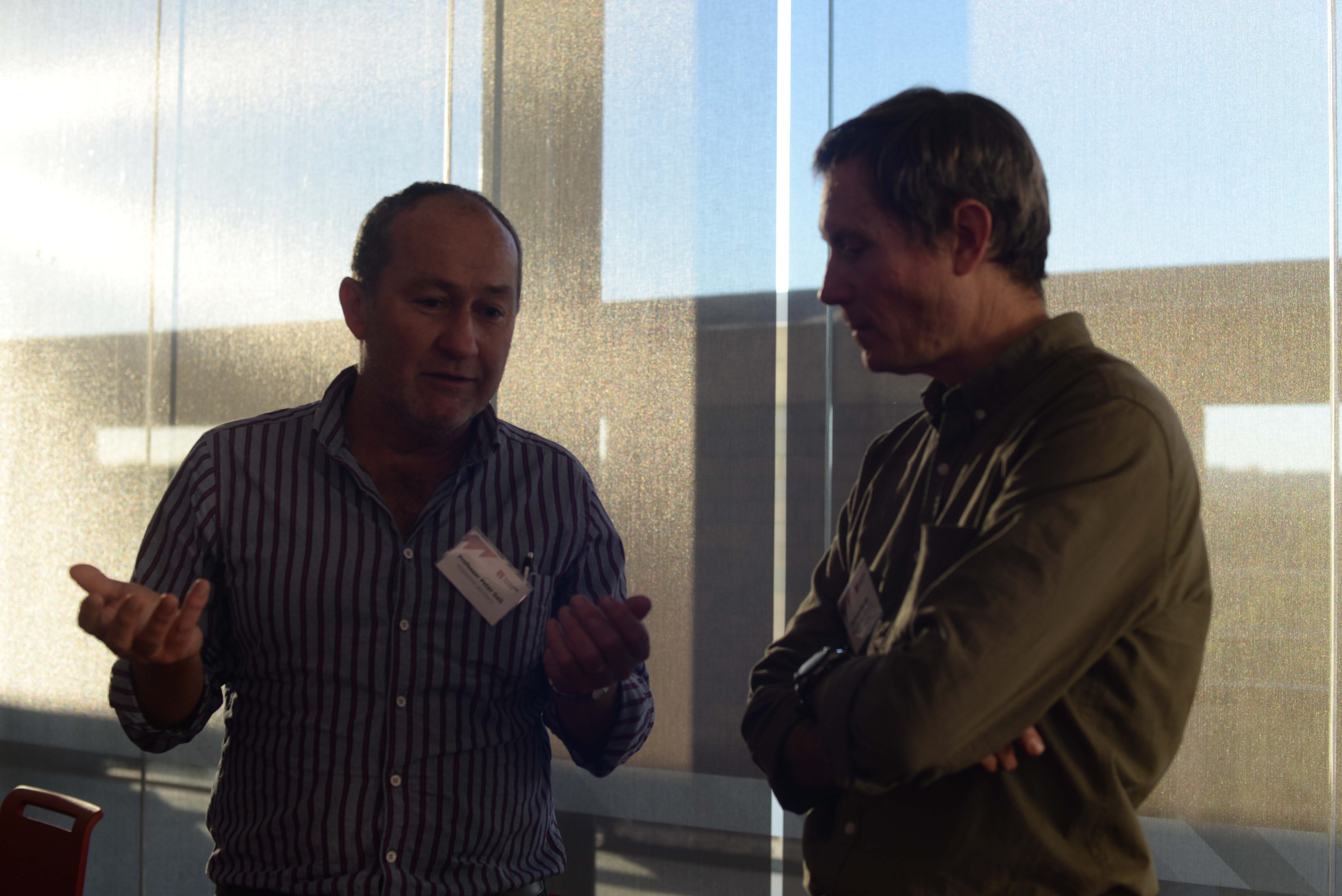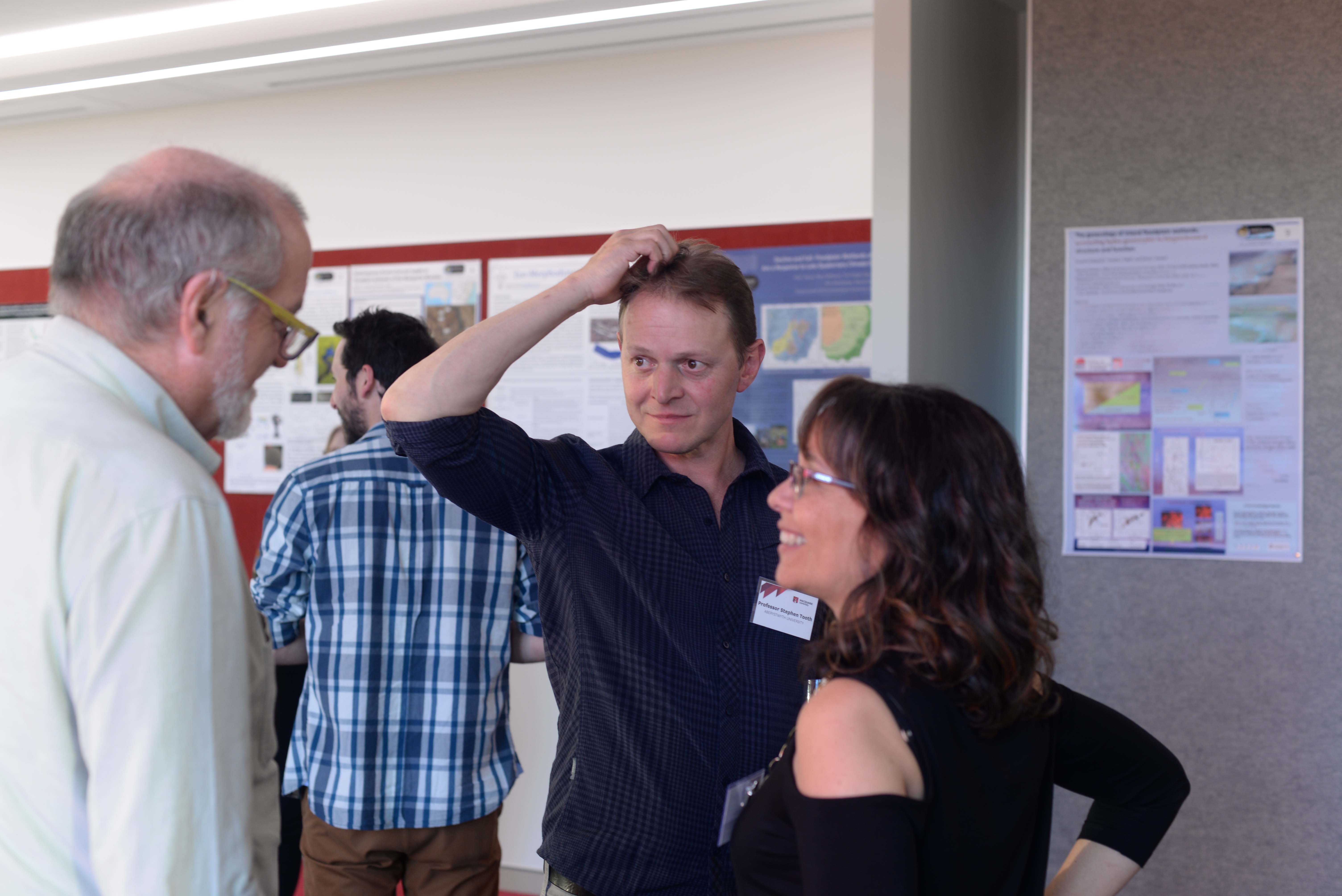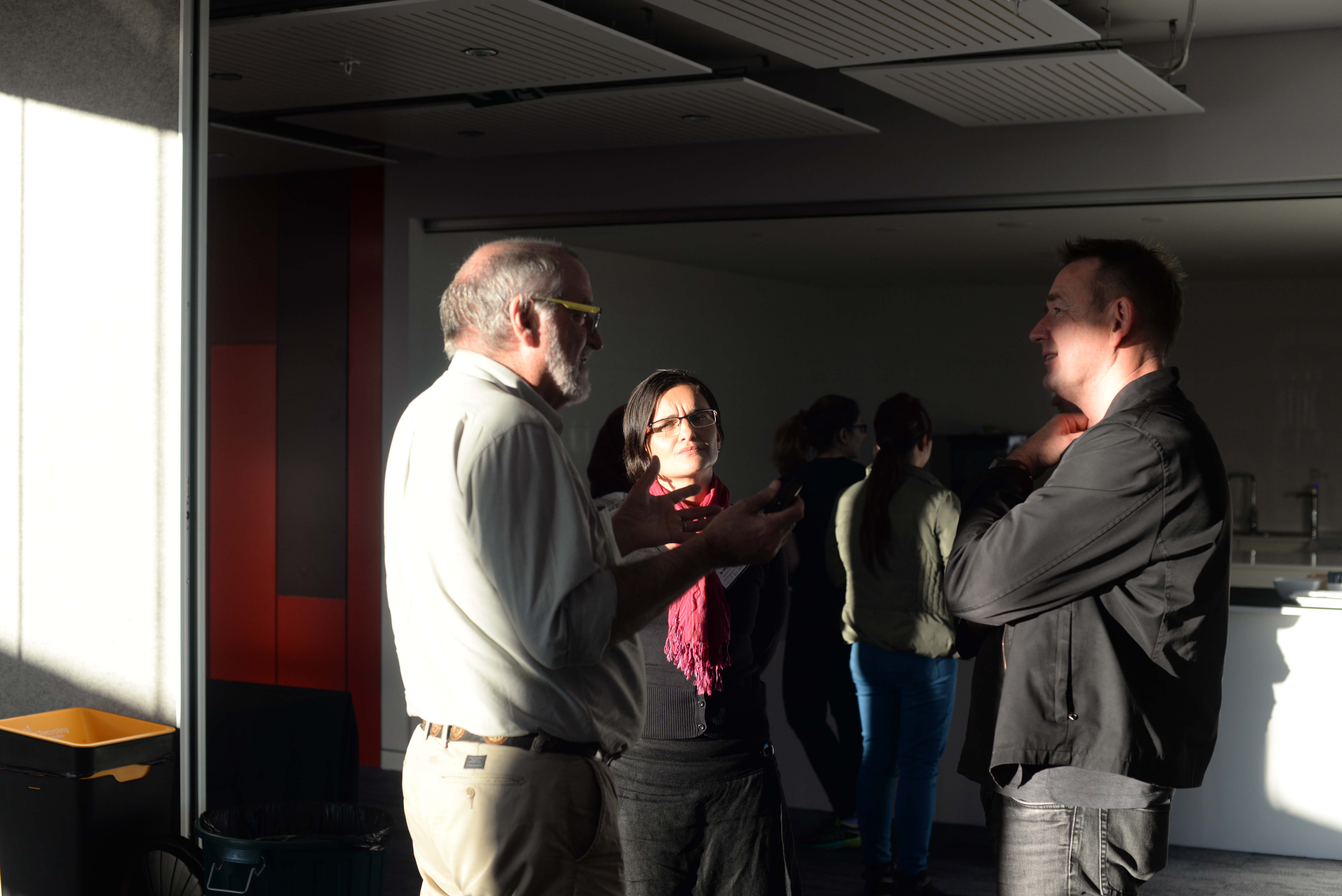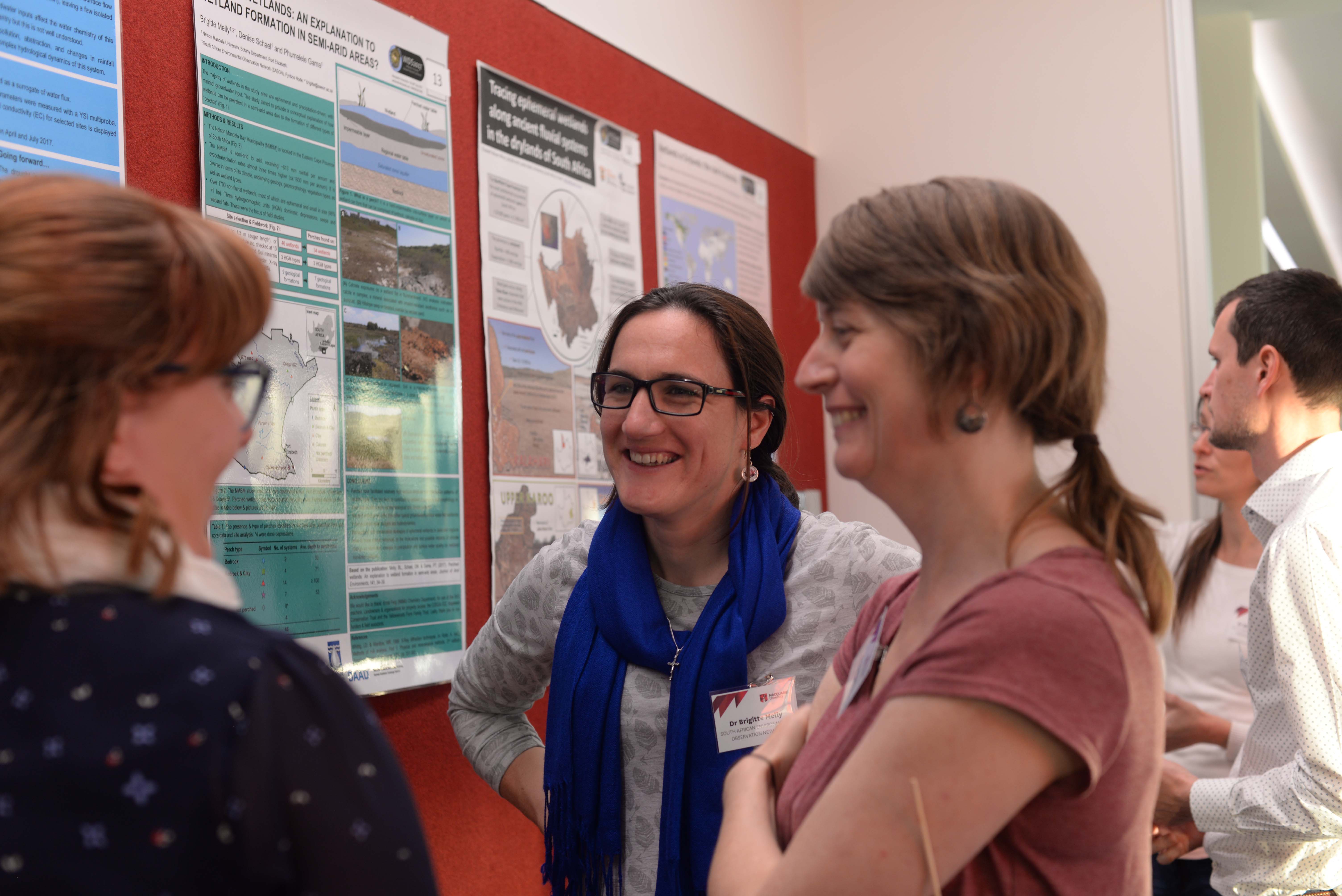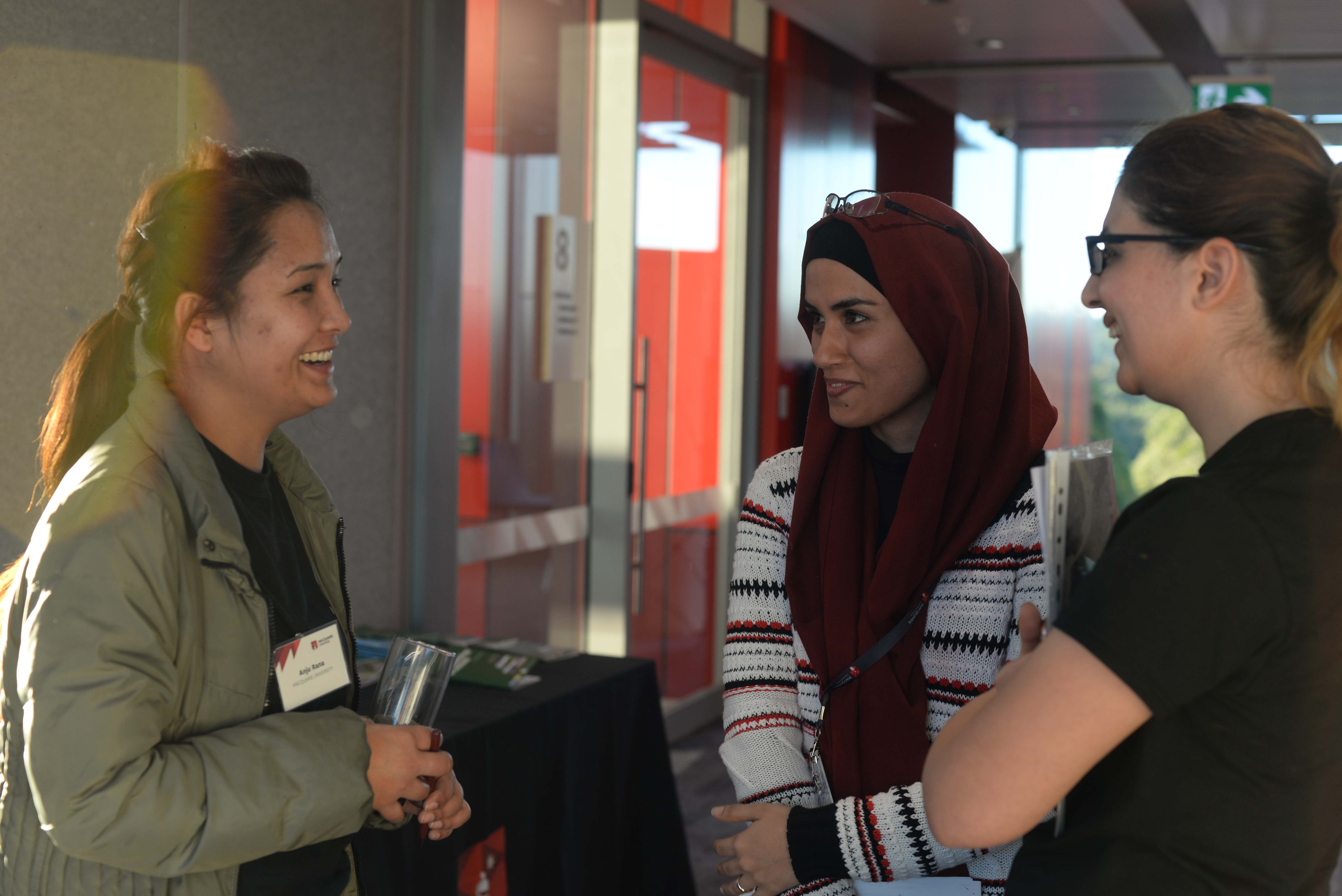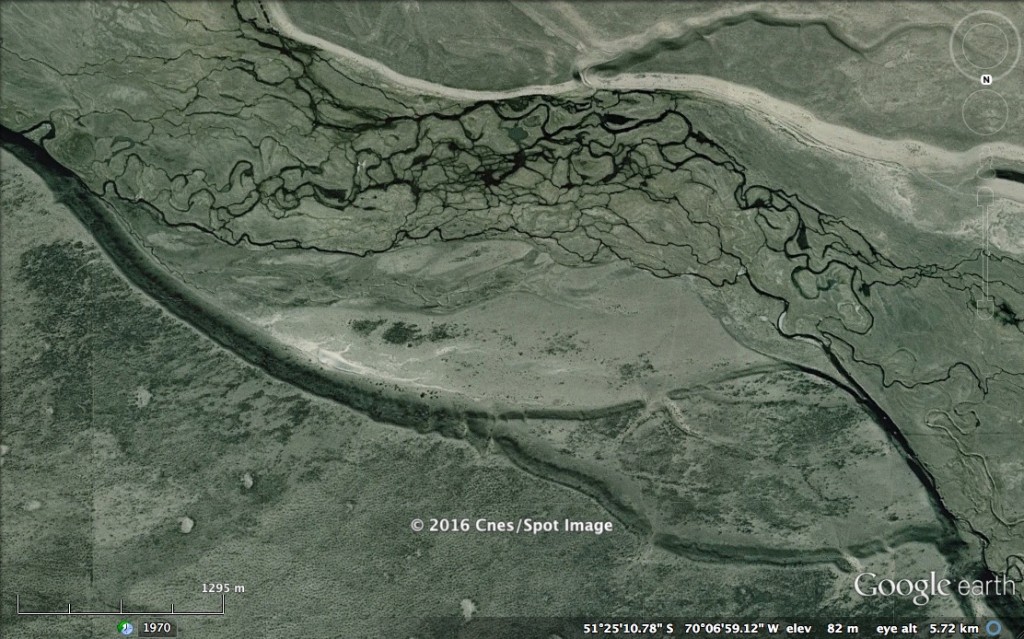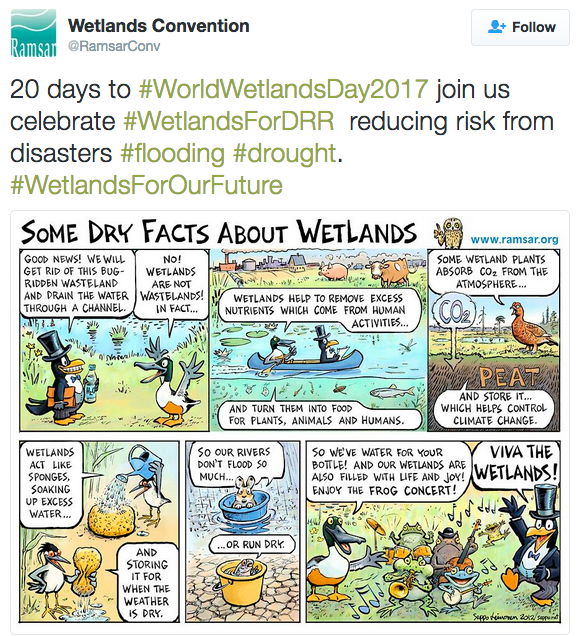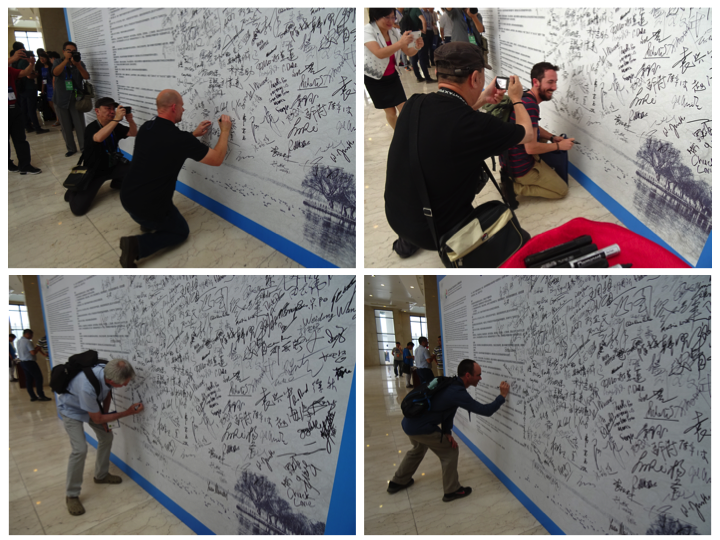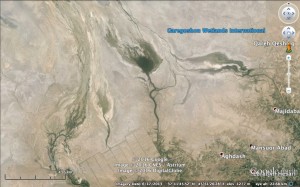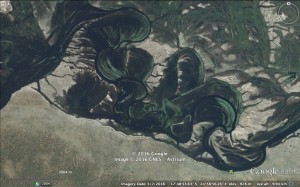Talks by Bradley Graves and Tim Ralph for the Society of Wetland Scientists (Oceania Chapter) Fire in Wetlands Forum, 8-9 September 2021
Brad and Tim participated in the SWS Fire in Wetlands Forum to highlight the importance of understanding fire regimes in catchments and, specifically, wetlands in drylands. The aim of the forum was to bring together scientists and managers from across Australia to share knowledge on the effects of fire and management in wetlands, cultural burning, implications of current research for improved mitigation, and to identify knowledge gaps for further research.
Brad spoke about ‘Fire in floodplain wetlands’, providing examples of macro-charcoal and sediment records from the Macquarie Marshes in semi-arid Australia, related to his recent paper Macro-charcoal accumulation in floodplain wetlands: Problems and prospects for reconstruction of fire regimes and environmental conditions.
Tim spoke about ‘A landscape approach to understanding wetlands and fire’, outlining a framework with examples from upland swamps, floodplain wetlands, and isolated lakes to demonstrate how the position of wetlands in a landscape and their geomorphology (both landforms and processes) are critical for understanding fire impacts and recovery trajectories.
A video of the talks can be accessed here (00:12:07 for Bradley Graves, and 00:25:47 for Tim Ralph):
—
Wetlands in a dry land: more-than-human histories of Australia’s Murray-Darling Basin – new book by Emily O’Gorman
Using the Murray-Darling Basin – a massive river system in eastern Australia that includes over 30,000 wetland areas – as a case study and drawing on archival research and original interviews, Dr Emily O’Gorman (Macquarie University, Sydney) examines how people and animals have shaped wetlands from the late nineteenth century to today. She illuminates deeper dynamics by relating how Aboriginal peoples acted then and now as custodians of the landscape, despite the policies of the Australian government; how the movements of water birds affected farmers; and how mosquitoes have defied efforts to fully understand, let alone control, them. Situating the region’s history within global environmental humanities conversations, O’Gorman argues that we need to understand wetlands as socioecological landscapes in order to create new kinds of relationships with and futures for these places.
The book, published in July 2021, is available to purchase here and/or to download with institutional access here.
—
Towards the Sustainable Use of African Wetlands (Frontiers e-Book)
A collection of papers published under the Frontiers Research Topic on African Wetlands is now available as an e-book here.
—
Talk by Stephen Tooth for the CIDRA Research Event, 6 May 2021
This talk outlines the preliminary findings from ongoing work in the floodplain wetlands of the Chobe National Park, Botswana. The work was funded by the Centre for International Development Research at Aberystwyth (CIDRA) and the talk was prepared as part of internal Research Event for CIDRA fund awardees (strictly three slides, three minutes only). But it seems a shame to not share the findings from this amazing part of the world a little more widely.
—
RGS talk by Michael Grenfell on ‘biogeomorphology of wetlands in the drylands of southern Africa’, 21 April 2021
The Royal Geographical Society (with IBG) West of England and South Wales cluster hosted a talk on biogeomorphology in wetlands in drylands. The event was chaired by Professor Phil Thoms, University of Gloucestershire. A video recording of the talk is available here:
—
World Wetlands Day, 2 February 2021
Every February, World Wetlands Day (WWD) is held to raise awareness about the vital role of wetlands for people and the planet (https://www.worldwetlandsday.org/). WWD 2021 has added significance, for the day marks the 50th anniversary of the adoption of the Convention on Wetlands on 2nd February 1971 in Ramsar, Iran. To recognise this significant achievement and to try and direct attention to the world’s wetlands in drylands in particular, Stephen Tooth, Peyton Lisenby and Tim Ralph have published an article in The Conversation.
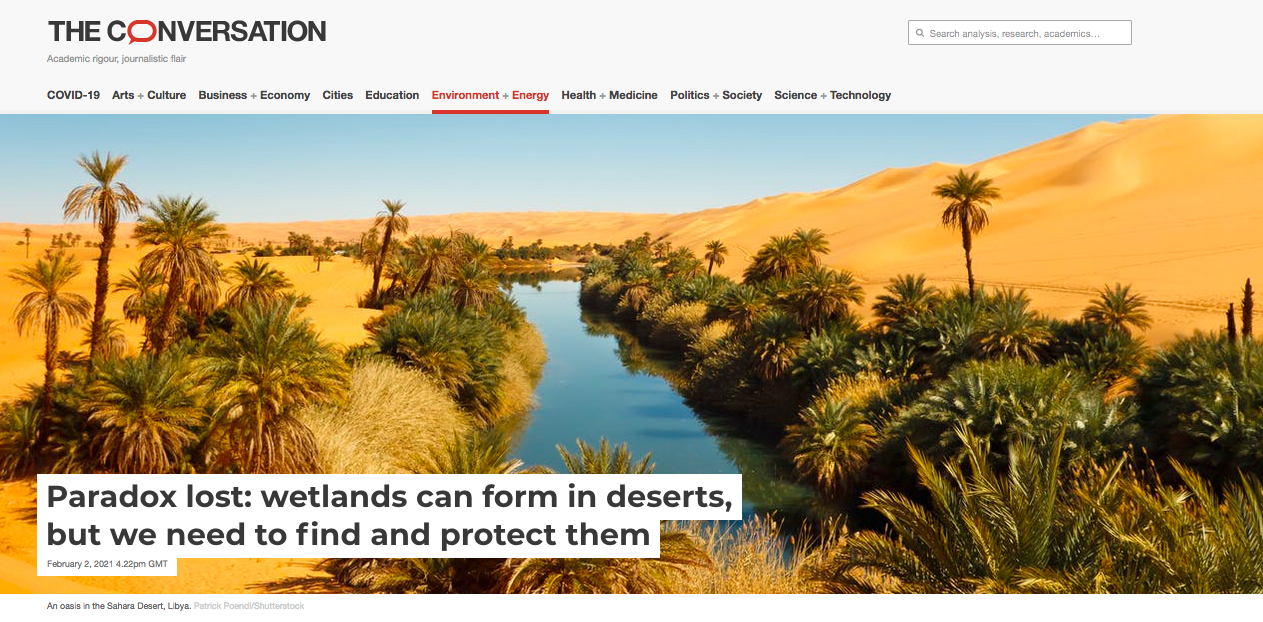 The article can be accessed at:
The article can be accessed at:
A longer statement that embellishes many of the points in this short article with links to additional resources can be found on the Downloads page:
Downloads | The Wetlands in Drylands (WiDs) Research Network
In this semicentenary year for Ramsar, can we think of other ways to try and raise the profile of wetlands in drylands science and management?
—
WiDs legend ‘Spike’ McCarthy wins 2020 South African National Wetland Award, 28 October 2020
Professor Terence Sinclair (Spike) McCarthy was honoured at the South African Wetland Society virtual annual awards ceremony with an award for long-term leadership and lasting impact in the science and management of wetlands in drylands. The following is an abridged version of the award citation:
“Terence has had a longstanding interest in a systems-level understanding of wetland origin, structure and function. He is best known for his authorship of the book: “The story of earth & life: a southern African perspective on a 4.6-billion-year journey”, which documented the history of the planet as recorded in the South African rock record. Wetlands form an important component of the modern landscape discussed towards the end of the book.
Terence is the singular pioneer of the science of ‘wetlands in drylands’, and at analysing why they exist and how they are structured and function in environments that are somewhat hostile to them. He is perhaps best known within this field for his work on the Okavango Delta in Botswana, which was supported through his leadership in establishing the Wits University Okavango Research Group. It was within this, and allied research groups led by Fred Ellery (Wits/UND/UKZN/Rhodes) and Stephen Tooth (Aberystwyth), both erstwhile post-doc students of Terence, that a southern African philosophical canon of wetlands in drylands geomorphology and biogeochemistry emerged through the 1990s and 2000s. This work inspired a generation of wetland scientists now formally engaged within the Wetlands in Drylands Research Network.
The impact of Terrence’s work is sustained within the students that he has inspired over many years, and the many fieldtrips he led across southern Africa. Despite his enormous scientific achievements, we are told that the memories Terrence relates best to are those that include moments around a fire in the bush when, with peers, a group would contemplate and theorise about an interesting scientific problem. These are the moments he loved best and will long be remembered for.”
I am sure that all of us who are engaged with the activities of this research network would wish to add our own congratulations to Spike for this worthy recognition.
Spike’s recollections regarding how his wetlands in drylands research originated is outlined on the ‘WiDS Reflections’ page.
—
Wetlands in Drylands Symposium at the 8th World Conference on Ecological Restoration, Restoring Land, Water and Community Resilience, Cape Town, South Africa, 24-28 September 2019
Michael Grenfell hosted a symposium at SER2019 with the theme “Formation, degradation, and recovery of wetlands in drylands: do our restoration strategies address key drivers of change?” The symposium questioned the extent to which restoration strategies developed within cool-humid regions may be applied to WiDs, and provided a synthesis of WiDs restoration research centred on understanding i) processes and rates of wetland origin and dynamics over timescales commensurate with WiDs ecosystem development, ii) fundamental catchment-scale controls on wetland resilience and natural recovery potential, and iii) underlying causes of wetland degradation – which are in many cases located at a spatial and temporal scale that goes beyond the site of degradation itself. The symposium provided a forum for discussion on the extent to which present restoration strategies account for the distinctive features of WiDs in addressing key drivers of ecosystem formation, degradation and recovery. Presentation topics are provided below:
- Michael Grenfell: Disciplinary perspectives on timescales of ecosystem formation, degradation, and recovery in wetlands in drylands: What is the natural reference state?
- Suzanne Grenfell: What existing wetland classification systems do not tell us: Implications for restoring wetlands in drylands and a proposal for a genetic geomorphic classification system.
- Damian Walters: Identifying ecological threshold breaches in wetlands: Development of a framework to improve wetland prioritisation and restoration in South Africa.
- Fred Ellery: Rethinking wetland restoration by considering natural dynamics: Evidence from the Krom River unchannelled valley-bottom wetland, Eastern Cape.
We hope that audio recordings of the presentations will be made available through the conference website in due course: https://ser2019.org/
—
Some rays of hope?
Given the various news items below that have recounted how the very concept of periodically-dry wetlands causes confusion for many people, it is reassuring to learn that even some children’s books are trying to spread the message. See the pages below, which come from a 2005 publication by Carolyn Scrace ‘What on Earth? Life in the Wetlands’ (Book House, Paperback ISBN 1-905087-44-6). It’s great to see acknowledgement of the fact that wetlands can be small, hot, located in the middle of deserts, and not always wet. Africa’s wetlands also get a special mention, although the global ‘mapping’ of wetlands looks more than a little sketchy!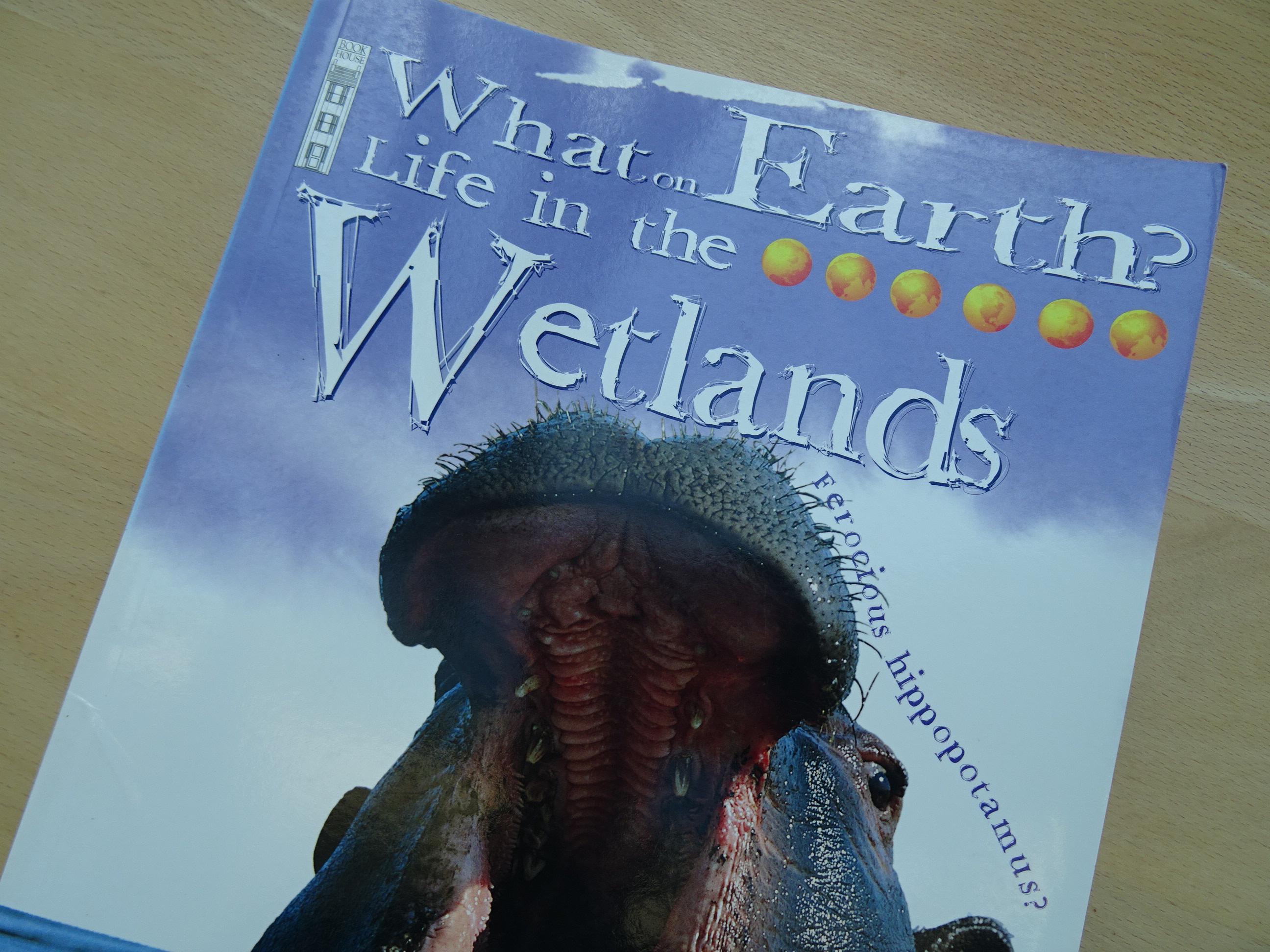
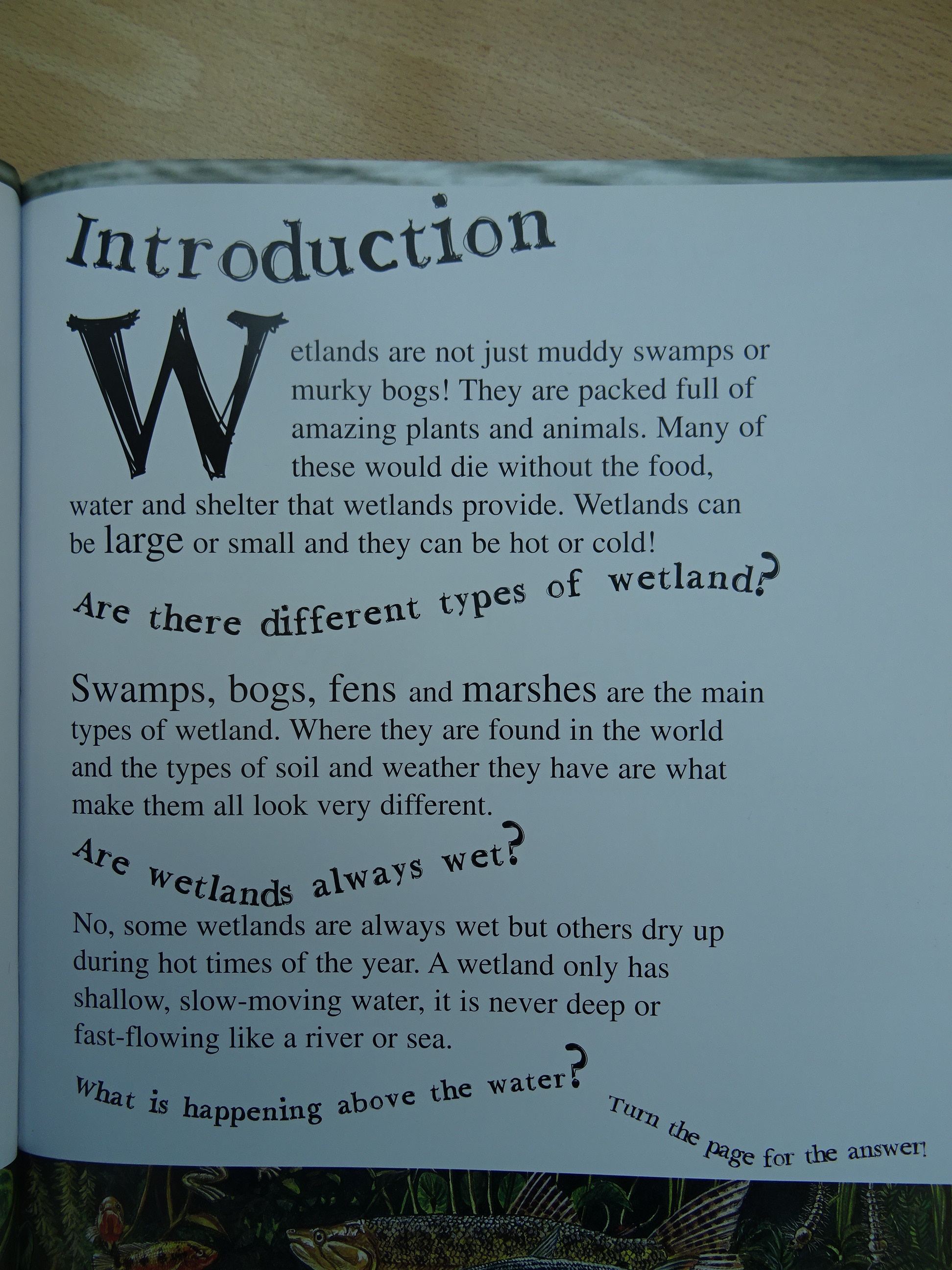

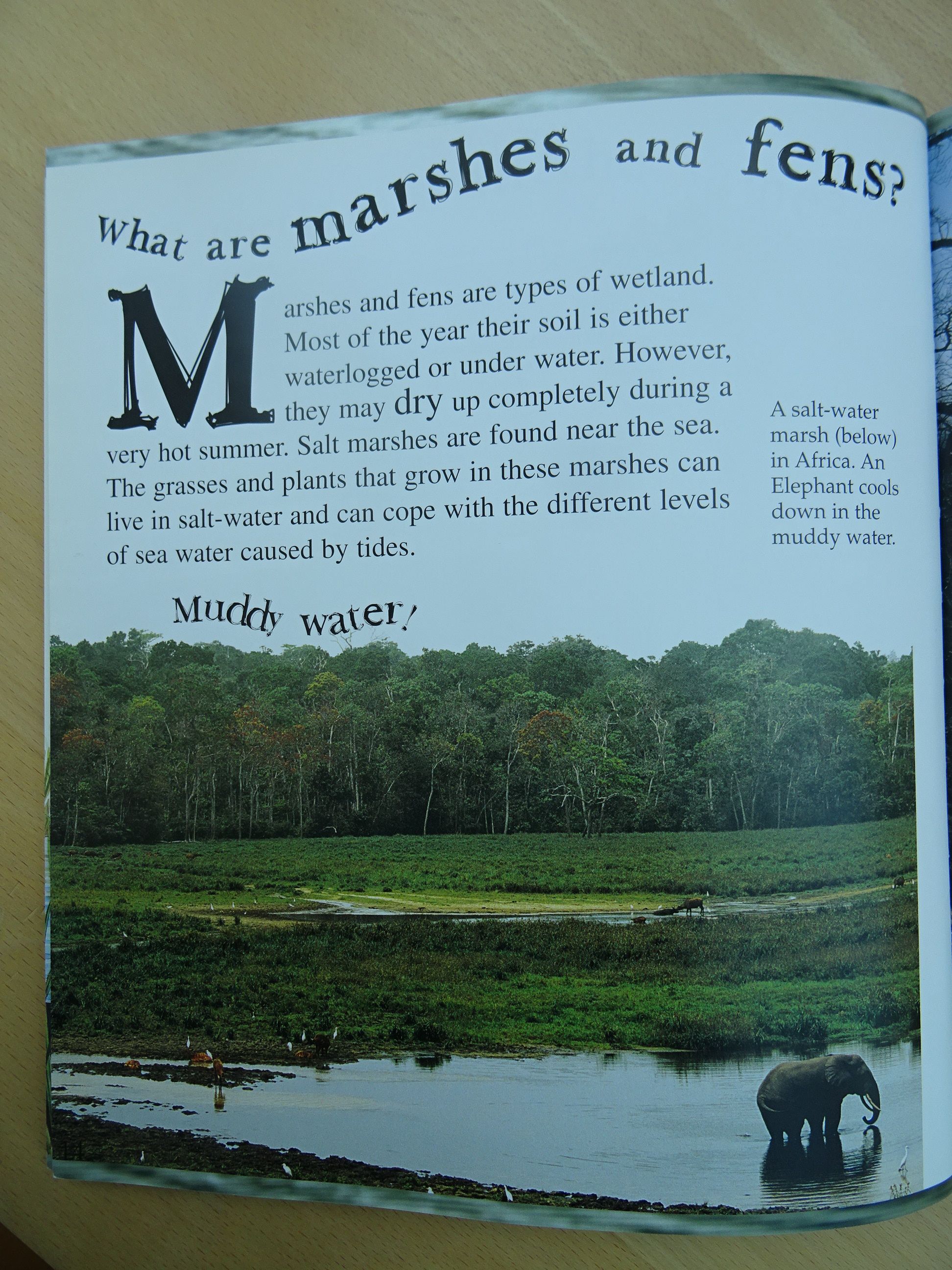
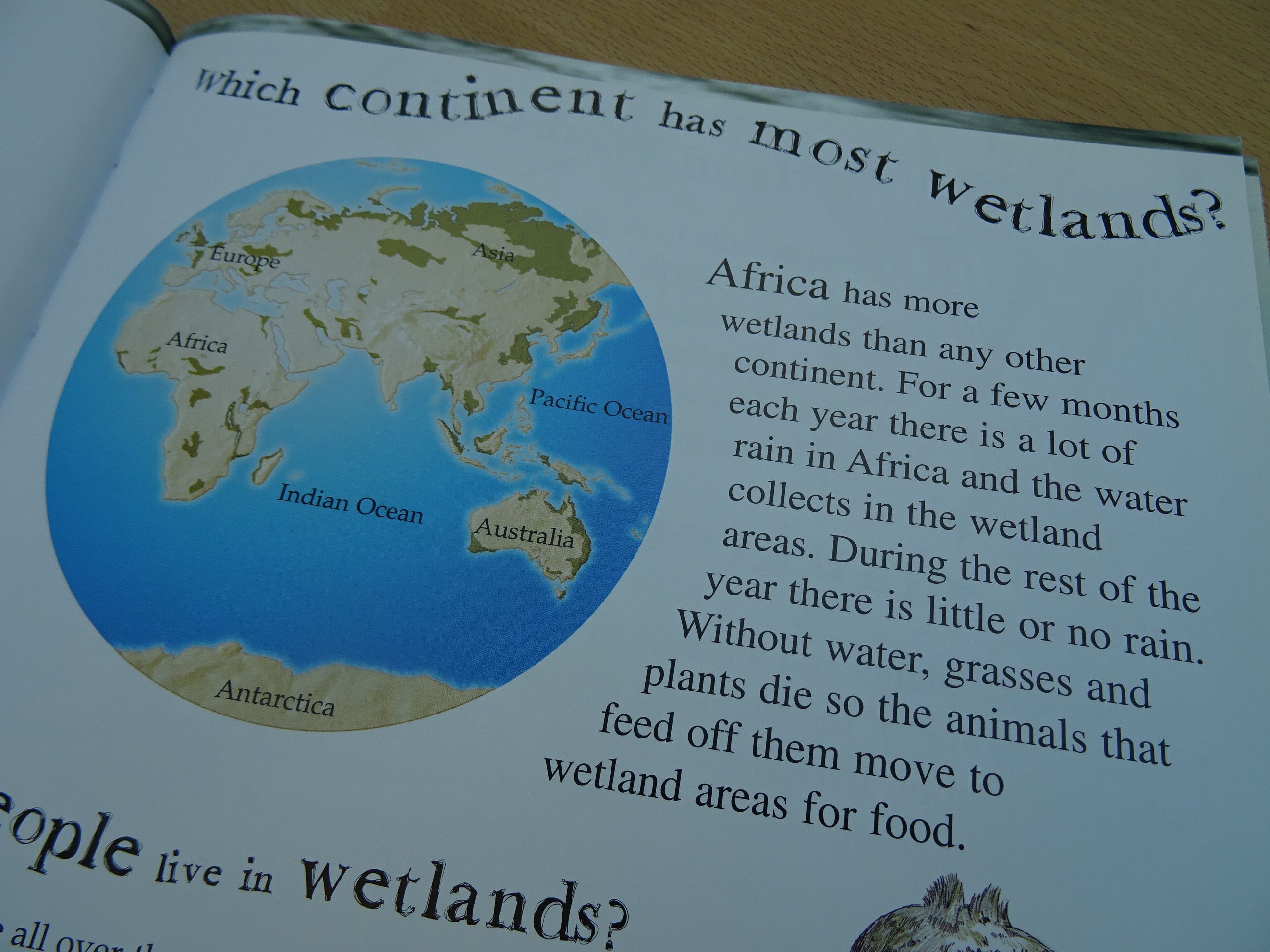
—
UK-Jordan Researcher Links Workshop
Stephen Tooth and Hywel Griffiths (both from Aberystwyth University) recently attended a UK-Jordan workshop on catchment management and water security in Al Kerak, Jordan (23-25th April 2019). The workshop was organised by Jonathon Bridge (Sheffield Hallam University, UK) and Sultan Tarawneh (Mu’tah University) and supported by a grant from the British Council as part of the Newton Fund Researcher Links Programme. The idea for the workshop originated from a long-standing collaboration between UK partners and Mu’tah University that has addressed catchment modelling and management in central Jordan.
Stephen Tooth’s report on the workshops is at:
https://stephentooth.wordpress.com/2019/05/06/the-lowest-point-on-earth/
As one of the invited ‘expert mentors’, Stephen’s contribution was a ½ hour talk that provided a global perspective on rivers and wetlands in drylands. The talk highlighted, inter alia, the diversity of dryland river process and form, the role of wetlands in ecosystem service provision, and approaches to management of wetlands in drylands. Similar to the Patagonian workshop (see below), from the perspective of the WiDS Research Network one of the most interesting outcomes again was the apparent limited awareness of the different variety of wetlands in Jordan. Jordan has two Ramsar wetlands (Azraq Oasis, Fifa Nature Reserve) plus numerous other smaller wetlands, but Stephen’s report recounts how a discussion with at least one Jordanian workshop participant revealed that one of these is not even regarded as a wetland. Again, the absence of permanent water seems to disbar many ephemeral, seasonal or temporary wetlands from being admitted as a member of the wetlands club. As a research network, what do we need to do to challenge these preconceptions?
—
Wetlands in drylands at the Geographical Association Annual Conference and Exhibition
In April 2019, Stephen Tooth gave an invited lecture entitled ‘Wetlands in drylands: landscapes and ecosystems of global importance’ at the Geographical Association Annual Conference and Exhibition, hosted by The University of Manchester, UK. The Geographical Association bills itself as ‘the leading subject association for all teachers of geography’ and is attended by a large number of geography teacher trainees and more seasoned educators from all over the UK and farther afield.
The lecture started with a brief history of the growing recognition – albeit belated – of the beneficial functions and resource potential of wetlands that has arisen over the last few decades, including the signing of the Ramsar Convention and the work of the Millennium Ecosystem Assessment in promoting the ecosystem service concept. The lecture then proceeded to explain the apparent paradox of wetlands in drylands, to highlight how they may differ from wetlands in more humid regions, and to illustrate how science can provide the vital underpinning for wetland management. Of course, scientific progress and management efforts are occurring against a backdrop of continuing loss of wetlands worldwide, including in many drylands (e.g. see the recent ‘Global Wetland Outlook’ report by the Ramsar Convention). All these topics have relevance for many themes that commonly form part of UK school curricula including rivers and floods, hot desert environments, ecosystems and societal resilience.
Some of the content of the lecture is supported by an article written by Stephen and Tim Ralph and published in the April 2019 edition of ‘Geography Review’ (v.32, pp. 26-30).
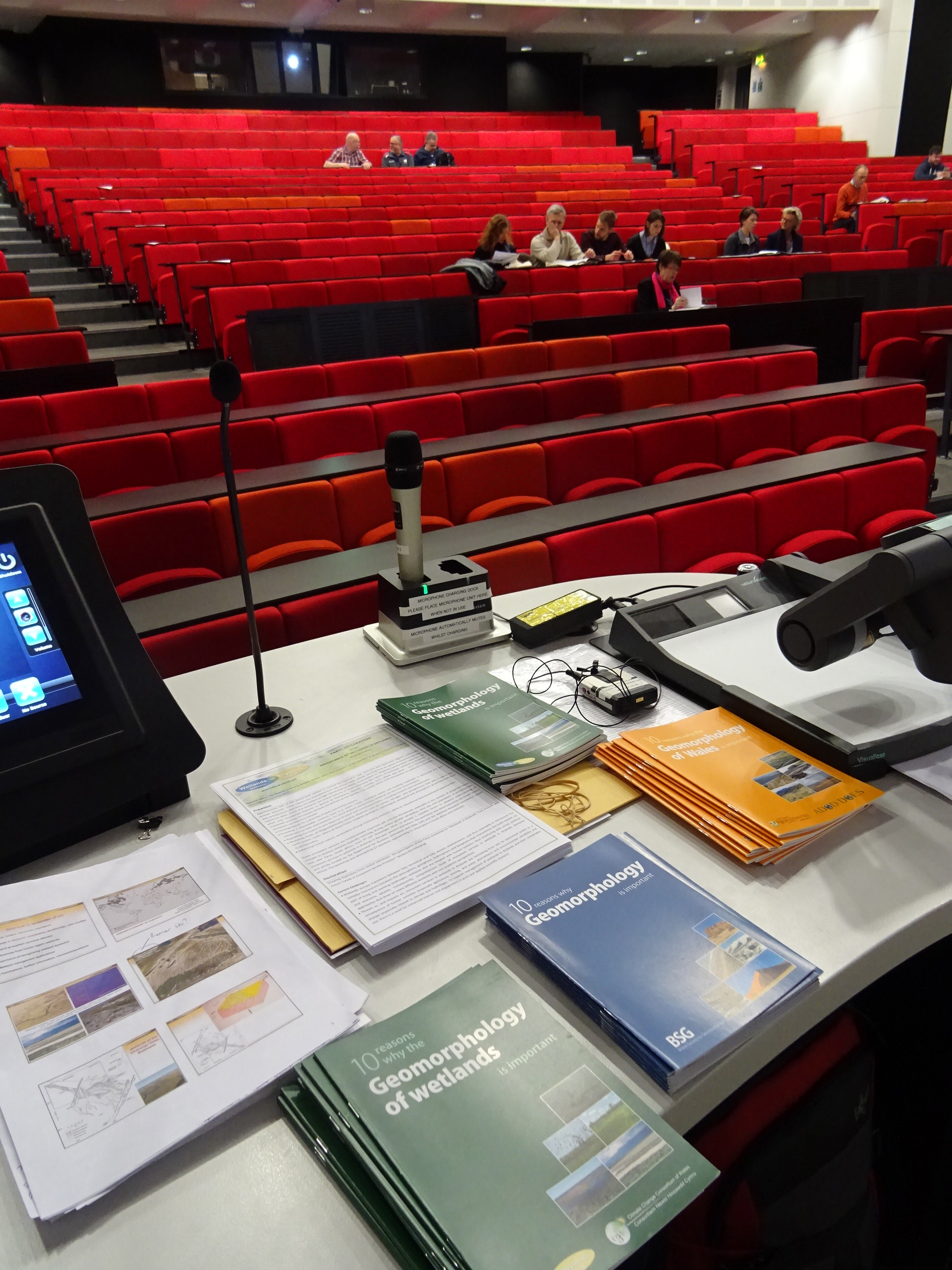
The work of the Wetlands in Drylands Research Network was also highlighted in the talk, with attendees rapidly snapping up the 20 available copies of the ‘10 Reasons why the Geomorphology of Wetlands is Important’ booklet, along with other give aways, including the Parys Declaration. And a re-reading of the Parys Declaration (see ‘Downloads’ tab) should remind us that one of the points in the ‘Moving Ahead’ section was ‘engaging in education and outreach initiatives’. Having a presence at events like the Geographical Association Annual Conference and spreading the message about the importance of the world’s wetlands in drylands to a new audience makes a contribution to that ambition.
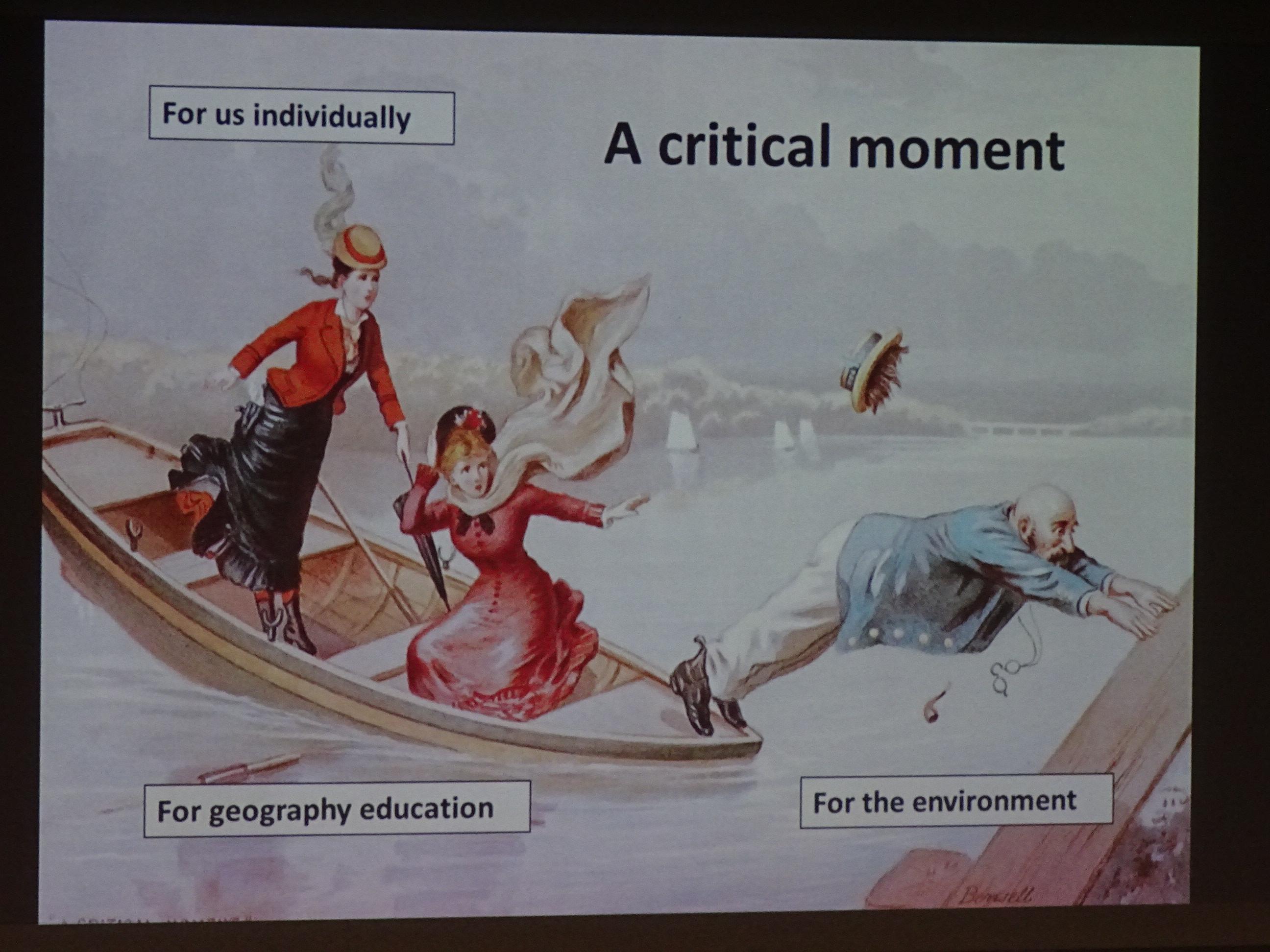
—
Wet Places in a Dry Land: Expanding Research into Patagonia’s Desert Rivers and Wetlands
Knowledge of the geomorphology, ecology and ecosystem services of rivers and wetlands in some of the world’s drylands is still very poorly represented in the scientific literature, at least in English language publications. The desert rivers and wetlands in the Argentinian part of Patagonia (a poorly defined region in Argentina and Chile that covers much of the southern part of the South American continent) are no exception, with detailed scientific studies relatively sparse given the vast expanse of the region.
Over the coming years, hopefully this situation can be rectified. On the back of previous work in Argentina (see https://stephentooth.wordpress.com/2014/01/06/a-potted-summary/) and other lines of research, Stephen Tooth and Hywel Griffiths from Aberystwyth University (AU) worked with Gabriel Kaless from La Universidad National de La Patagonia San Juan Bosco (UNPSJB) to secure funding for a project through the British Council Higher Education Links Grants scheme. Entitled ‘Wet Places in a Dry Land: Securing Ecosystem Services from Patagonia’s Desert Rivers and Wetlands’, the project funding enabled Hywel and Stephen to visit Patagonia in March 2019 to help run a series of workshops for various interest groups, including academics and researchers, university students, policy makers, engineers, local communities.
An AU Press Release from prior to the trip is at:
https://www.aber.ac.uk/en/news/archive/2019/02/title-221251-en.html
Stephen Tooth’s report on the workshops is at:
https://stephentooth.wordpress.com/2019/03/24/wet-places-in-a-normally-dry-land/
Among various outcomes from the meeting, from the perspective of the WiDS Research Network one of the most interesting was the apparent limited awareness of the different variety of wetlands in the Patagonian drylands, which include hillside seeps and springs, unchannelled valley flats, oxbows and abandoned channel reaches along meandering river floodplains, and weathering depressions on low relief basaltic terrain. To some extent, this apparent limited awareness may have reflected the difficulty in translating ‘wetland’ into Spanish; for many people, our use of ‘humedal’ conjured up images of the permanently saturated features in the better watered parts of the country such as the Esteros del Iberá in the northeast (see https://en.wikipedia.org/wiki/Iber%C3%A1_Wetlands) and so seemingly precluded the inclusion of features that periodically dry up.
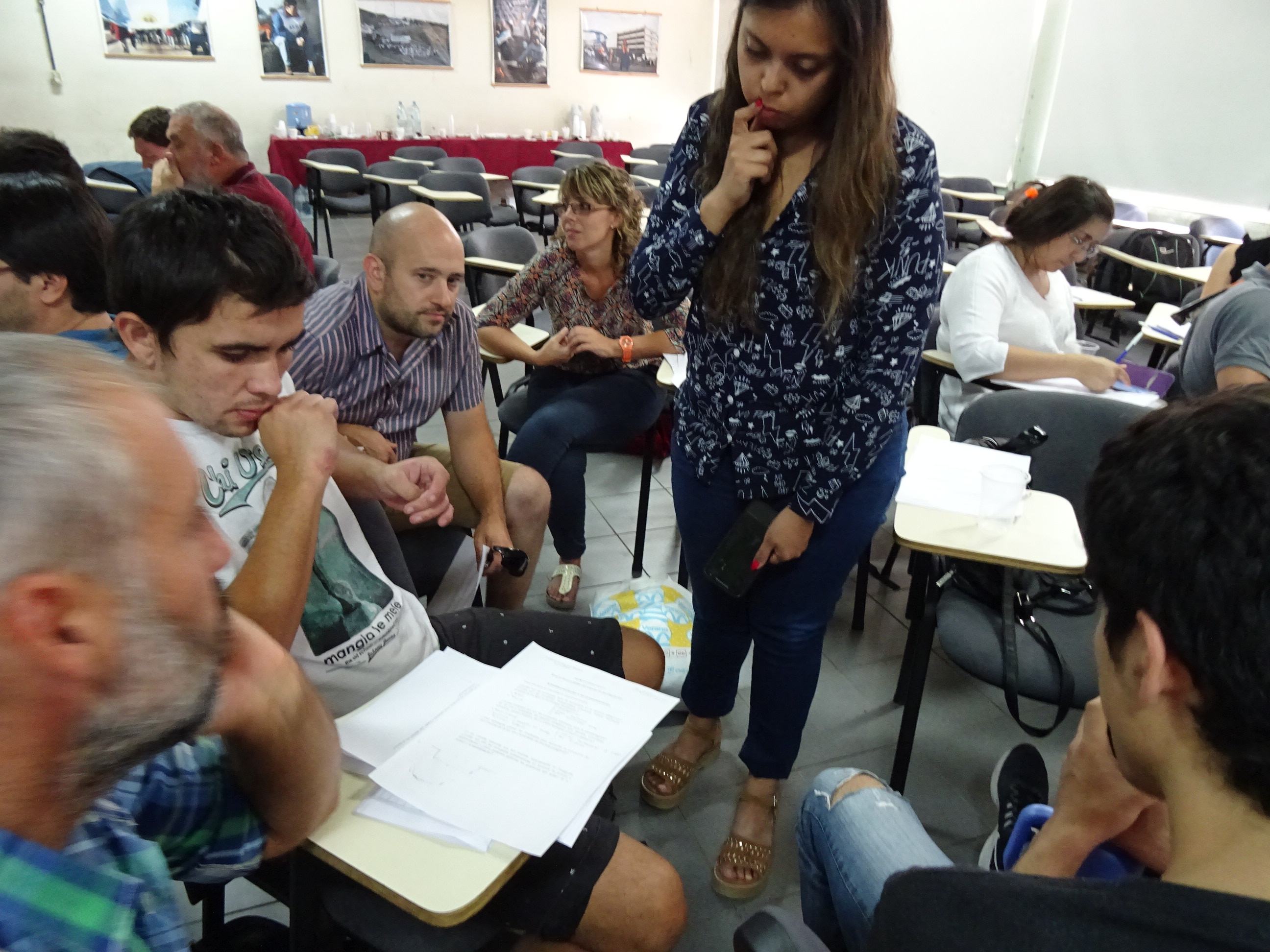
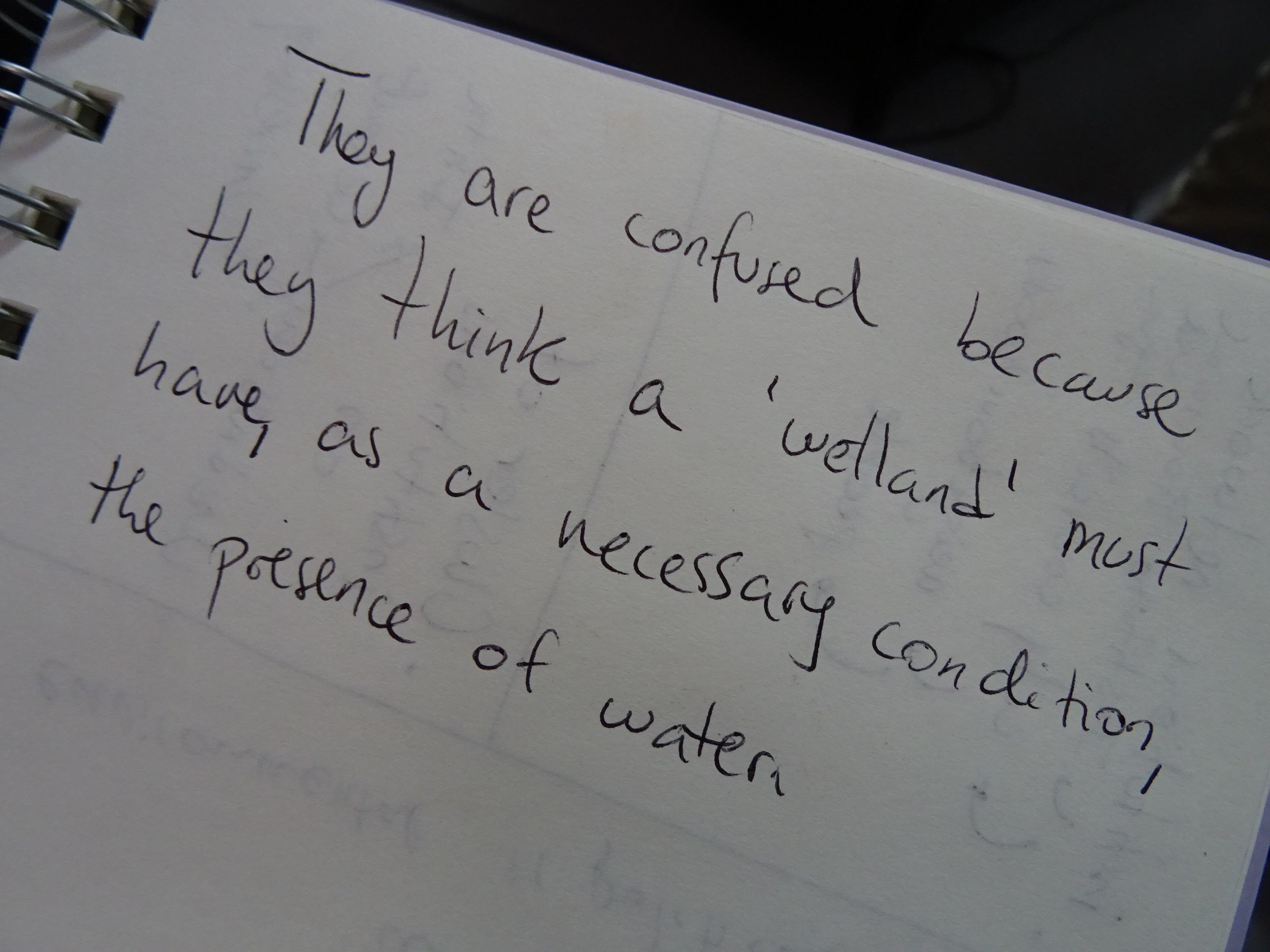
Wetlands in the Patagonian drylands – many of which dry up on seasonal or longer timescales – tend to be known by more specific, local or regional names such as ‘mallines’ or ‘bajos sin salida’ (perhaps these are features that can help populate the ‘What’s in Name?’). The density of the latter features on basaltic terrain in some parts of Argentinian Patagonia was a revelation to the UK participants, and one that is worthy of additional investigation.
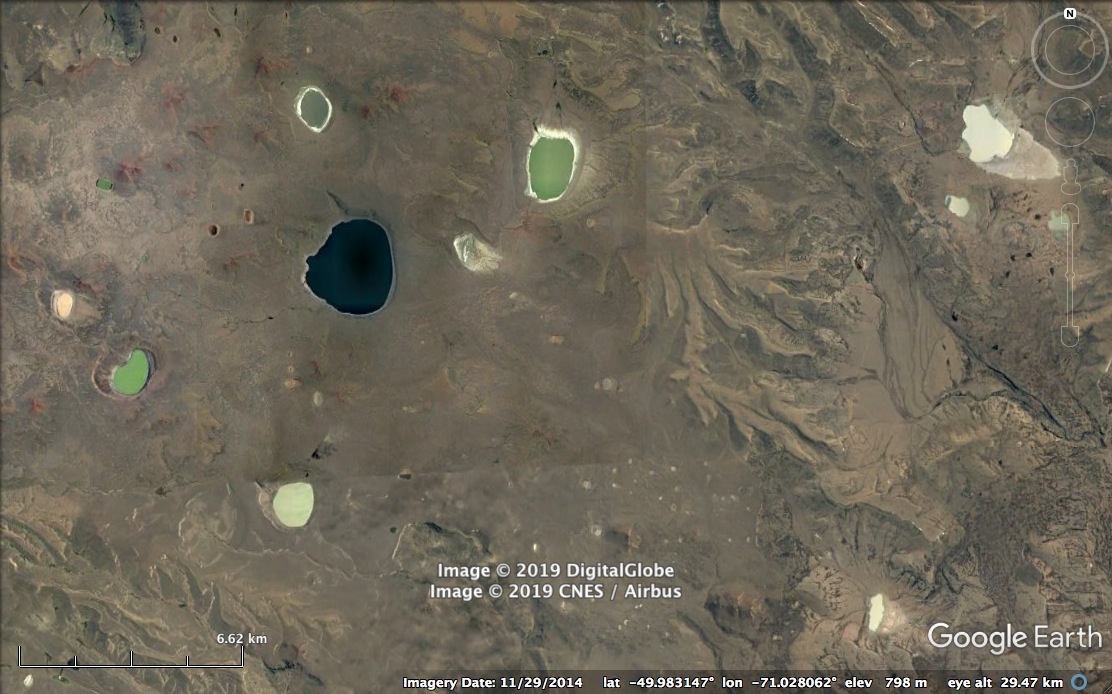
These types of knowledge exchange illustrate perfectly the value of holding such workshops. Well designed workshop activities that help to stimulate discussion among diverse participants can help highlight the barriers to improved comprehension of natural phenomena among non-specialists, while also bringing to the attention of the wider scientific community some key features of relatively poorly documented landscapes.
—
Rutherford Fund Strategic Partner Grants update
Following the visits of three Rutherford Fellows (Drs Peyton Lisenby, Bennie van der Waal and Paul Harvey) to Aberystwyth University (AU) at various points during May to September 2018, two additional fellows from Namibia (Drs Frans Persendt and Eliakim Humanyela) visited AU between November 2018 and end March 2019.
The Rutherford Fellowship Scheme is administered by Universities UK International (UUKi), with the idea being that fellows will visit the UK to undertake research and facilitate the development of collaborative links between UK universities and strategic overseas partners. The first three fellows worked most closely with Stephen Tooth and overseas colleagues on the wetlands in drylands theme. Frans and Eliakim worked with a wider range of colleagues at AU (principally Chris Thomas, Andy Hardy, Donall Cross, Stephen Tooth, Andrew Thomas) to develop collaborative research ideas that will support a strategic partnership between AU and the University of Namibia (UNam). Particular attention focused on the links between malarial risk and hydrological and geomorphological processes in the wetlands in drylands in northern Namibia, including the seasonally-flooded depressions locally known as ‘oishana’ (singular ‘oshana’). Use of remote sensing technologies (e.g. satellie imagery, drones) to identify and map the hydrological dynamics of these features, many of which form malarial mosquito breeding habitats, will be an important part of malarial control programmes in Namibia and other neighbouring countries, as well as many countries farther afield.
AU Press Releases on the two phases of the Rutherford Fellows programme are at:
https://www.aber.ac.uk/en/news/archive/2018/08/title-215844-en.html
https://www.aber.ac.uk/en/news/archive/2019/03/title-222146-en.html
—
South African National Wetlands Indaba, Kimberley, 8-11 October
The South African National Wetlands Indaba is an annual gathering of scientists, practitioners, consultants, government personnel, and members of NGO’s, who share an interest in wetlands. The 2019 meeting was held in Kimberley from 8-11 October, was attended by more than 250 people representing more than 20 organisations, and showcased 100 original research presentations. The theme for the meeting was ‘Drylands and wetlands: Connecting and managing heterogeneity across landscapes’, reflecting a growing interest in wetlands in drylands research, and the inspiration of the local landscape of the Northern Cape Province of South Africa. Session topics included ‘wetlands in drylands’ (two sessions), ‘co-operative governance and multi-sector involvement’ (one session), ‘rivers, wetlands and agriculture’ (two sessions), ‘birds, biodiversity and wetlands’ (one session), ‘wetlands, people and community’ (two sessions), ‘wetland monitoring and management’ (three sessions), ‘urban wetlands’ (one session), and ‘wetland rehabilitation’ (one session). The Wordle below captures common threads in the scientific programme presentation titles (excluding the words ‘wetland’ and ‘wetlands’, which are obviously prominently represented).
Presentation abstracts and slide or poster pdf’s will be made available in due course on the conference website (http://www.nationalwetlandsindaba2018.com/index.php).
It was particularly encouraging to see the involvement of large groups of student researchers, who we hope will ‘carry the flag’ for wetlands in drylands research in future.
Prof Jenny Day (5 from left), Dr Michael Grenfell (back row left), Dr Suzanne Grenfell (back row right), and Mr Mandla Dlamini (front seated), with a group of 12 students from the University of the Western Cape, all of whom presented research at the conference.
—
Aberystwyth University Environmental Science Summer School
In late July 2018, Stephen Tooth coordinated a session on wetlands in drylands to around 20 students from Hohai University, China, as part of Aberystwyth University’s Environmental Science Summer School. With Rutherford Fellow Bennie van der Waal in attendance to facilitate the session, the idea was to ascertain students’ prior understanding of wetlands and drylands, and to illustrate the distribution, importance and key characteristics of wetlands in drylands. Group activities involved the students learning about wetlands in their own country, including through consulting the list of Ramsar wetlands in China (49 sites in total) and assessing how many other protected areas in China (e.g. national parks, geoparks) feature wetlands and wetlands in drylands (quite a few, including Alxa Desert UNESCO Global Geopark).
Prior to the session, the students had been provided with a list of 66 key technical terms by their course tutors and tasked with translating them into Chinese. Many had done this, and had also provided definitions of the terms in English. Seemingly, this had been done with online dictionaries, resulting in some interesting outcomes. Some terms were defined well (e.g. hydrological budget = ‘an accounting of the inflow to, and outflow from, and storage in, a hydrologic unit, such as a drainage basin, aquifer, soil zone, lake, reservoir, or irrigation project’) but others were not so well defined, with context required for the correct definition (e.g. (channel) headcut = ‘cut the hair’, channel failure = ‘network fault’). The session provided an opportunity to provide that context, particularly by introducing students to the wonders of avulsion dynamics and avulsion chronologies, and why this matters for sustainable wetland management.
Student engagement in the session was good overall, but did seem to conform to the almost universal rule of lecture room instruction: levels of engagement decline in inverse proportion to distance seated from the front. But as Bennie said afterwards, while no-one would have got everything from the session, everyone would have got at least something. That’s the untested assumption anyway.
—
Rutherford Fund Strategic Partner Grants
From end May to end July 2018, Dr Peyton Lisenby visited Aberystwyth University (AU) as the first of three Rutherford Fellows that will be working with Stephen Tooth and overseas colleagues on the wetlands in drylands theme. The Rutherford Fellowship Scheme is administered by Universities UK International (UUKi), with the idea being that fellows will visit the UK to undertake research and facilitate the development of collaborative links between UK universities and strategic overseas partners.
Peyton is affiliated with Macquarie University (MQU) in Sydney, Australia and has been working primarily with Stephen and Tim Ralph (MQU). Following a brainstorming session that took place shortly after Peyton’s arrival, research primarily focused on the possibilities for the more explicit embedding of key geomorphological concepts (e.g. channel adjustment, sediment connectivity, landform sensitivity) into floodplain wetland characterisations, particularly wetland classifications. A draft of a paper is nearing completion and soon will be submitted to an international journal.

Dr Benjamin (Bennie) van der Waal arrived in Aberystwyth in mid July and will stay until late August. Bennie is from Rhodes University (RU) in Grahamstown, South Africa and will work primarily with Stephen and Fred Ellery (RU) on concepts related to sediment delivery and connectivity in incised and non-incised South African floodplain wetlands.
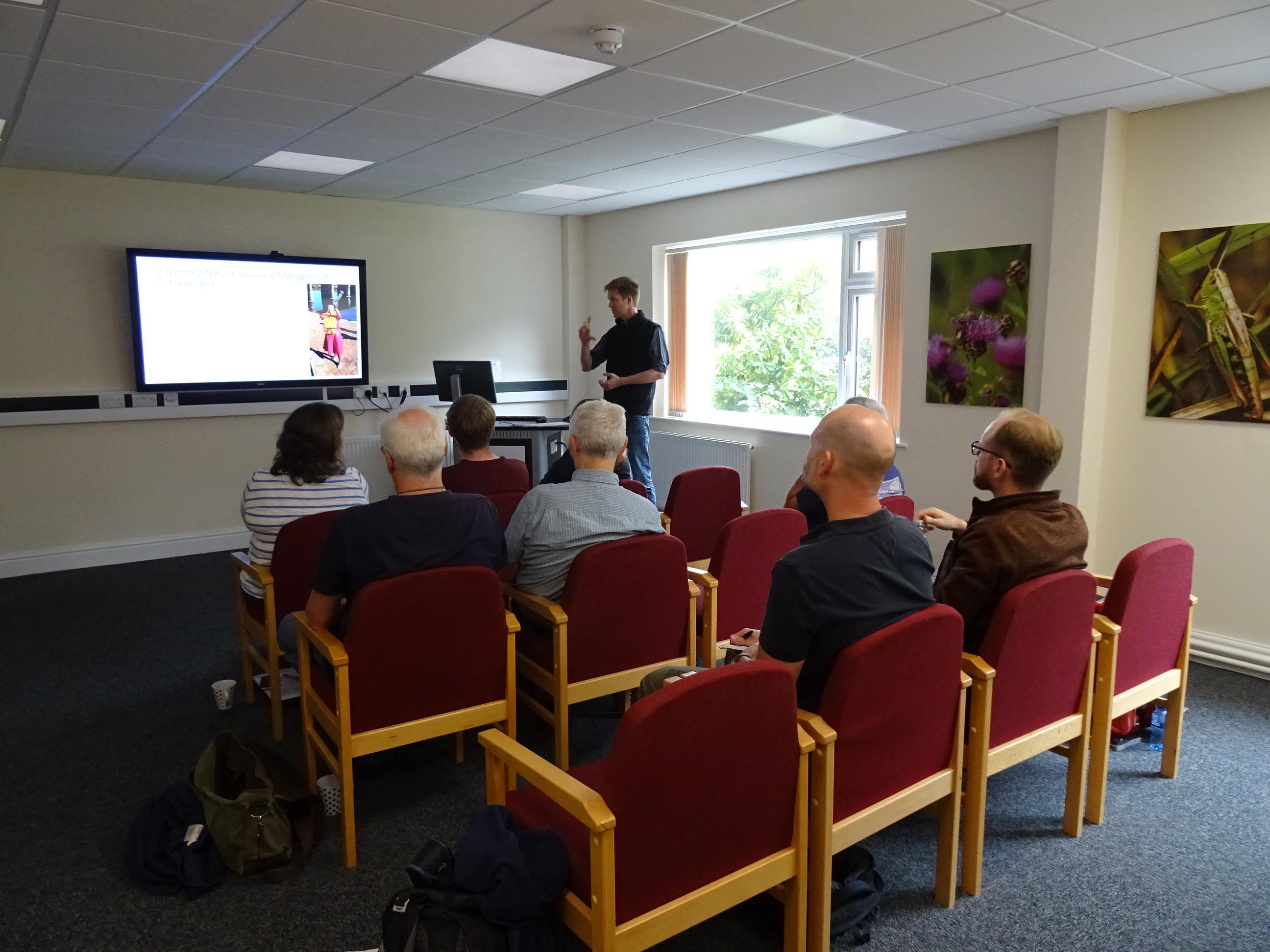
During the overlap created by Peyton and Bennie’s visit, various training opportunities have arisen. These have included attending a workshop at AU’s Pwllpeiran Upland Research Platform, mid Wales, where the future land use options for the area’s blanket bogs, heaths and forests were discussed, as well as the possibilities for strengthening public engagement with research and embedding science into land use management practices and policies. Peyton’s experience with restoration projects in flood-impacted Australian rivers and Bennie’s involvement with wetland prioritisation efforts in rural South African communities provided interesting perspectives to compare and contrast with the situation faced in rural upland Wales.
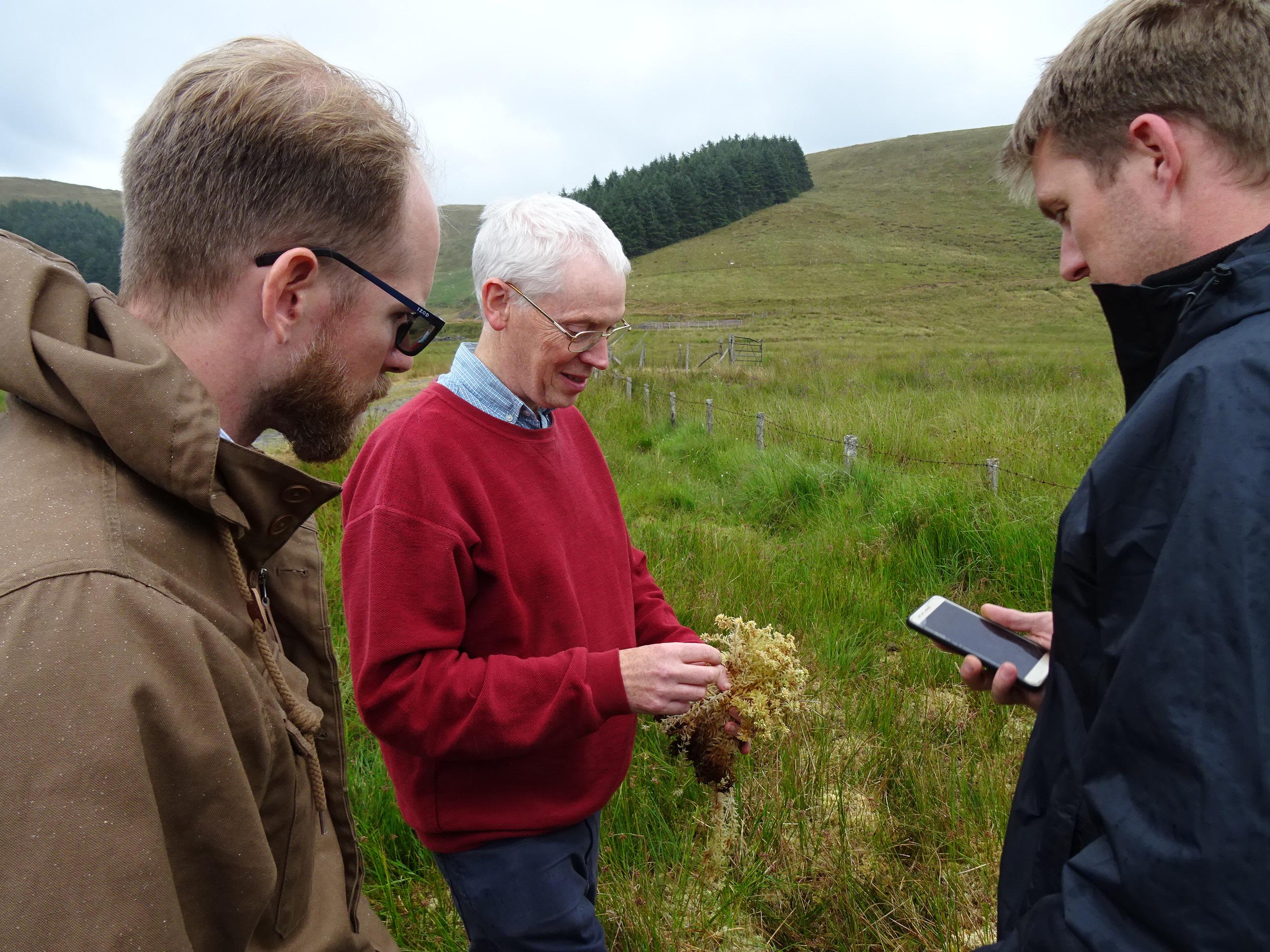

A day trip through the upland scenery of mid Wales also provided ample scope for discussion about the threats to rivers, wetlands and associated upland carbon stores under scenarios of land use and climate change, the latter theme being particularly a propos given the current UK drought conditions. This trip also provided additional opportunities to discuss strategies for the communication of research – especially in geomorphology and Quaternary science – for public engagement, management practice, and policymaking.
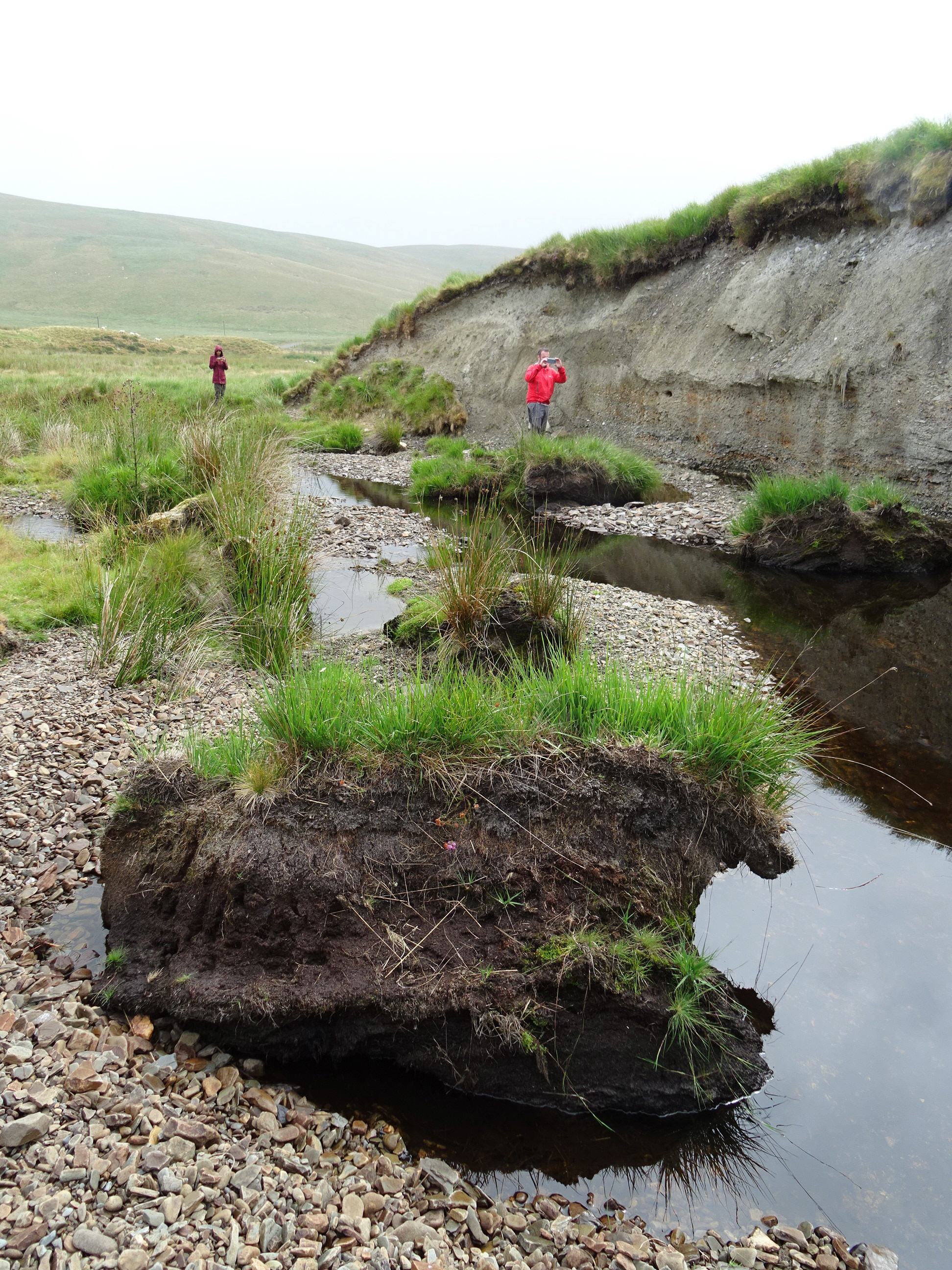
Both Peyton and Bennie will be presenting posters on their research at the British Society for Geomorphology’s Annual Meeting in Aberystwyth in Sept 2018. Bennie’s visit may provide a short overlap with that of the third Rutherford Fellow, namely Paul Harvey from MQU who will be working primarily on a project overseen by Tim Ralph (MQU) that is looking at rapid assessment of wetland geomorphological condition. Individually and in combination, the work undertaken by these Rutherford Fellows will contribute significantly to the activities of the WiDs Research Network, particularly by initiating new lines of enquiry.
—
How is gully erosion linked to wetland development?
Simon Pulley, Fred Ellery and colleagues have just had a paper published in the international journal Land Degradation & Development (2018, v.29, pp.1756-1767, DOI: 10.1002/ldr.2972). The paper is entitled ‘Gully erosion as a mechanism for wetland formation: an examination of two contrasting landscapes’ and is significant because it makes a case for natural cycles of gully incision and infilling as a key control on wetland dynamics and long-term valley development in headwater valleys in South Africa.
Tooth et al.’s (2002, 2004) model of floodplain wetland formation and long-term, progressive valley development by lateral meander migration along mixed bedrock-alluvial rivers has been found to be a plausible explanation for a number of moderate to large (up to ~50 km2) floodplain wetlands in northeastern South Africa (see some of the references tagged to the map in the WiDs Spatial tab), but the paper by Pulley and others modifies that model for low-order catchments in the more southerly location of the Eastern Cape Province, many of which do not possess through-going meandering channels. One of their primary arguments is that wetlands naturally become prone to deep gully incision down to bedrock owing to a combination of aggradation, tributary fan development, local slope increases, and flow confinement along the trunk stream. Over time, repeated cycles of gully incision at different points across the valley fill lead to planing of the underlying bedrock, and thus to progressive valley deepening, widening, and longitudinal slope reduction. In turn, this creates the space and conditions conducive for wetland development in the next cycle of infilling.
Importantly, as also shown by work elsewhere in South Africa, many former phases of gully incision and infilling occurred earlier in the Holocene, significantly prior to incursion by settlers of European descent with their more intensive farming practices. In these cases, therefore, wetland and gully dynamics are natural processes that are controlled largely by intrinsic factors, a conclusion that has implications for land management interventions that attempt to control gully erosion by structural means.
—
South African National Wetlands Indaba 2018
8–11 October 2018
Mittah Seperepere Convention Centre, Kimberley, Northern Cape
The theme of this year’s Indaba is “Drylands and Wetlands: connecting and managing heterogeneity across landscapes”.
Sub-themes include ‘Wetlands in drylands’, ‘Wetlands, people and community engagement’, ‘Birds, biodiversity and wetlands’, ‘Rivers, wetlands and agriculture’, ‘Co-operative governance and multi-sector involvement’, ‘Wetland rehabilitation’, ‘Urban wetlands’, and ‘Wetland monitoring and management’.
For more information, and to submit an abstract, visit the Indaba website: http://www.nationalwetlandsindaba2018.com
—
Wetlands in drylands: science, research and collaboration
In late October 2017, during their annual MSc student fieldtrip to Spain (see stephentooth.wordpress.com/2014/10/27/the-rain-in-spain/), Andrew Thomas and Stephen Tooth presented at the Instituto Pirenaico de Ecología (IPE), located near Zaragoza, northeast Spain. IPE is a research centre belonging to the Natural Resources section of the Spanish National Research Council (Consejo Superior de Investigaciones Científicas), and this year is celebrating its 75th anniversary. Over the years, IPE has produced high-quality research on many aspects of the Spanish environment (e.g. ecology, geomorphology, Quaternary history) and has been instrumental in translating much of this research into environmental policy and practice.
Tooth opened and closed the presentation with a contribution entitled ‘Wetlands in drylands: science, research and collaboration’, which provided some of the rationale for studying wetlands in drylands, outlined the development of the WiDs Research Network, and invited opportunities for collaboration (for instance, how about a Spanish translation of the ’10 Reasons why the Geomorphology of Wetlands is Important’ brochure?). The research element of the presentation was provided by Thomas, who examined whether some wetlands in drylands could be hidden hotspots of carbon (C) sequestration and storage. In line with a recent Nature Geoscience article claiming that closed (endorheic) desert basins may represent a substantial, global inorganic C sink (Li and others, 2017, v.10, doi: 10.1038/ngeo2972), preliminary data from the Kalahari and Spain seem to show that under certain environmental conditions, ephemeral pans and playas can act as C sinks, with net C uptake occurring in the saline sediments.
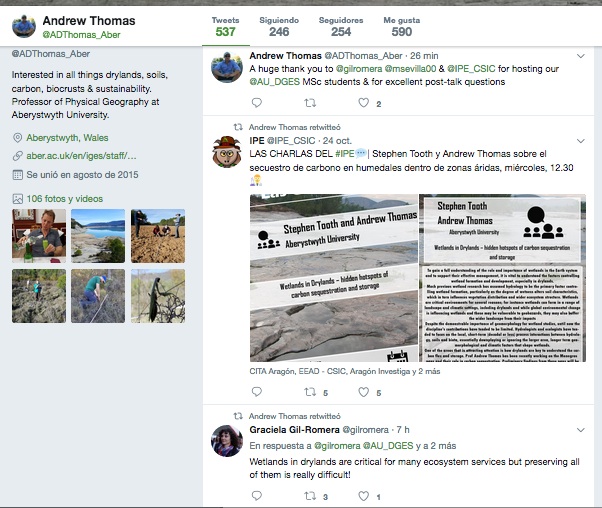 There was significant interest in the talk from the IPE staff present, as evidenced by a large number of perceptive comments and questions. Many of these revolved around the identification, sampling and quantification of the geochemical and microbial controls on the drawdown, transformation, storage, and release of organic and inorganic C. Clearly, this is a topic ripe for further research and will form part of a forthcoming European Commission/Welsh Government-funded project by Thomas and others entitled ‘Microbial photosynthesis and carbon stores in dryland pan sediments (MicroCarb)’.
There was significant interest in the talk from the IPE staff present, as evidenced by a large number of perceptive comments and questions. Many of these revolved around the identification, sampling and quantification of the geochemical and microbial controls on the drawdown, transformation, storage, and release of organic and inorganic C. Clearly, this is a topic ripe for further research and will form part of a forthcoming European Commission/Welsh Government-funded project by Thomas and others entitled ‘Microbial photosynthesis and carbon stores in dryland pan sediments (MicroCarb)’.
[Footnote: IPE’s own blog of the talk (in Spanish) is at: https://divulgaipe.com/2017/10/27/tooth-thomas-secuestro-carbono-humedales-zonas-aridas/]
—
Resilience and nonresilience of wetlands in drylands
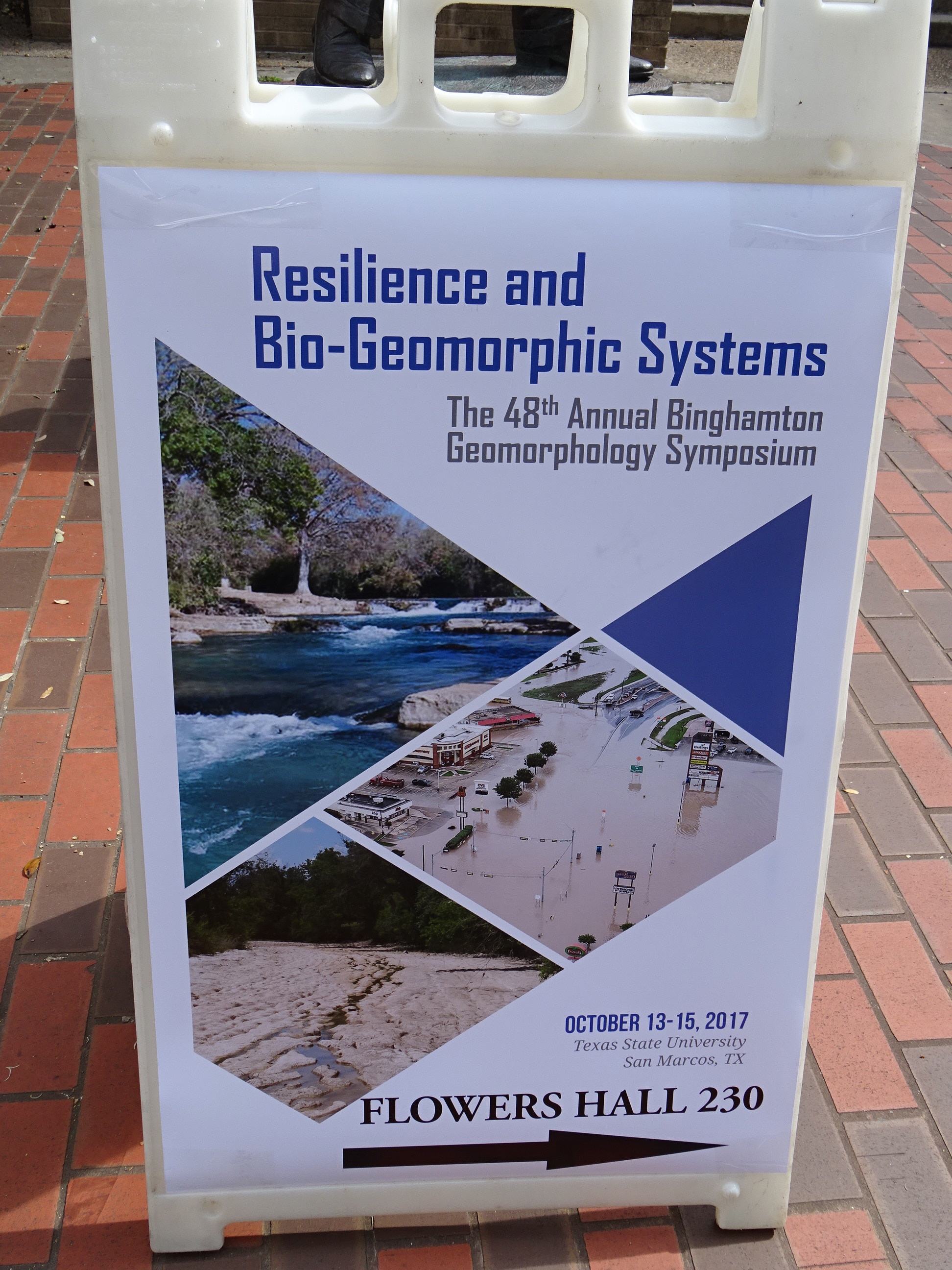 In mid October 2017, Stephen Tooth attended the 48th Annual Binghamton Geomorphology Symposium at Texas State University, San Marcos, USA. The symposium started at Binghamton in New York in 1970 and has been held annually ever since, expanding beyond its northeast USA origins to other parts of the USA and, on occasion, even being held farther afield (e.g. Canada, Italy). Sawyer and others (2014) have traced the development of the symposium series (see Geomorphology, v.223, doi: 10.1016/j.geomorph.2014.06.022), showing how many of the symposium themes and publications have helped to shape the direction and focus of subsequent geomorphological research. The 2017 theme was entitled ‘Resilience and Bio-Geomorphic Systems’, the justification being that resilience thinking is a rapidly-emerging concept that is being used increasingly to frame how we approach the study and management of biophysical systems but that geomorphological inputs so far have been limited.
In mid October 2017, Stephen Tooth attended the 48th Annual Binghamton Geomorphology Symposium at Texas State University, San Marcos, USA. The symposium started at Binghamton in New York in 1970 and has been held annually ever since, expanding beyond its northeast USA origins to other parts of the USA and, on occasion, even being held farther afield (e.g. Canada, Italy). Sawyer and others (2014) have traced the development of the symposium series (see Geomorphology, v.223, doi: 10.1016/j.geomorph.2014.06.022), showing how many of the symposium themes and publications have helped to shape the direction and focus of subsequent geomorphological research. The 2017 theme was entitled ‘Resilience and Bio-Geomorphic Systems’, the justification being that resilience thinking is a rapidly-emerging concept that is being used increasingly to frame how we approach the study and management of biophysical systems but that geomorphological inputs so far have been limited.
The symposium comprised a one-day fieldtrip around the catchment of the San Marcos River to examine resilience against the backdrop of catastrophic flood disturbance, riparian restoration efforts, and environmental education initiatives (see images), and two days of oral presentations, posters, and discussions.
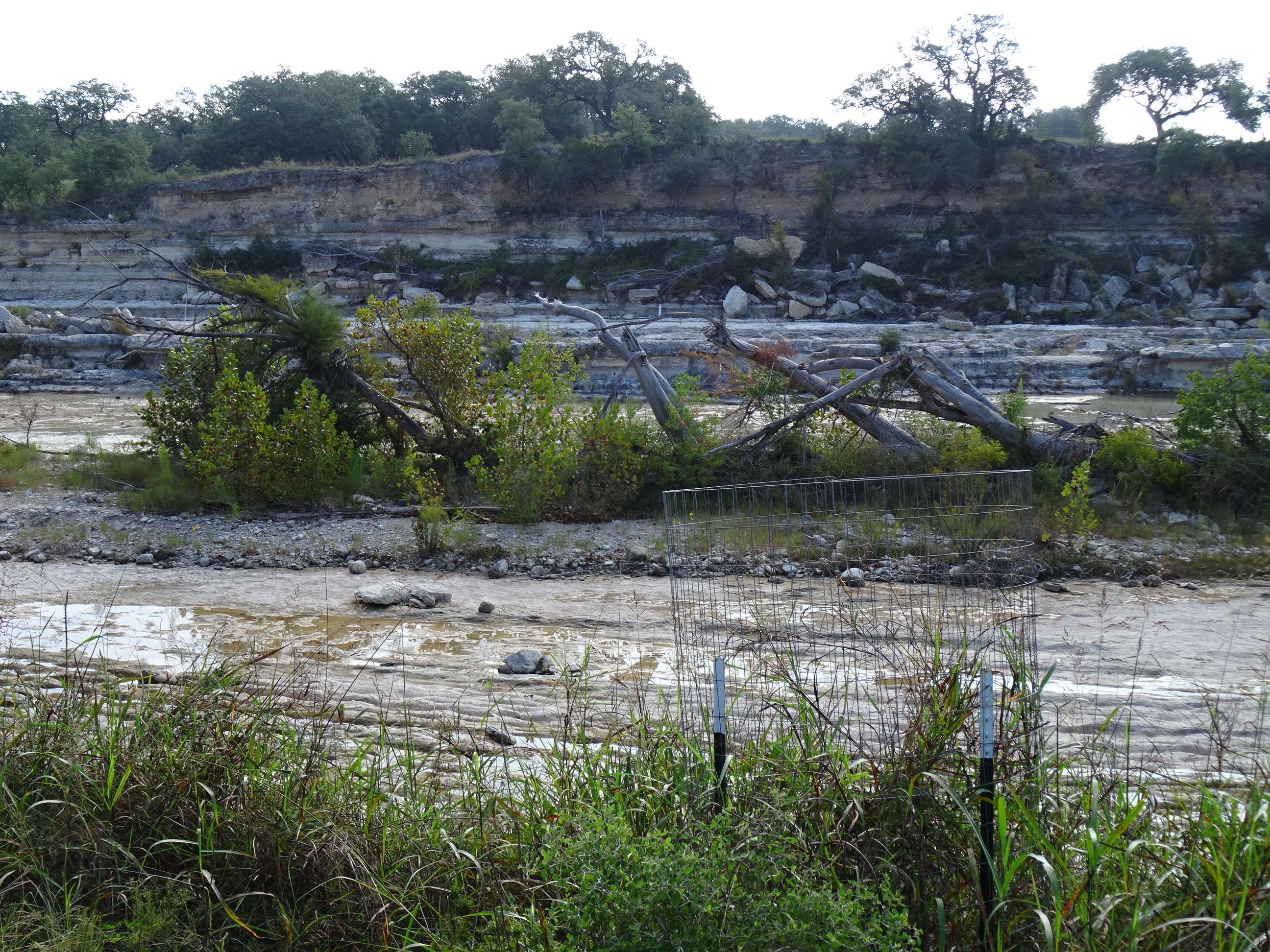
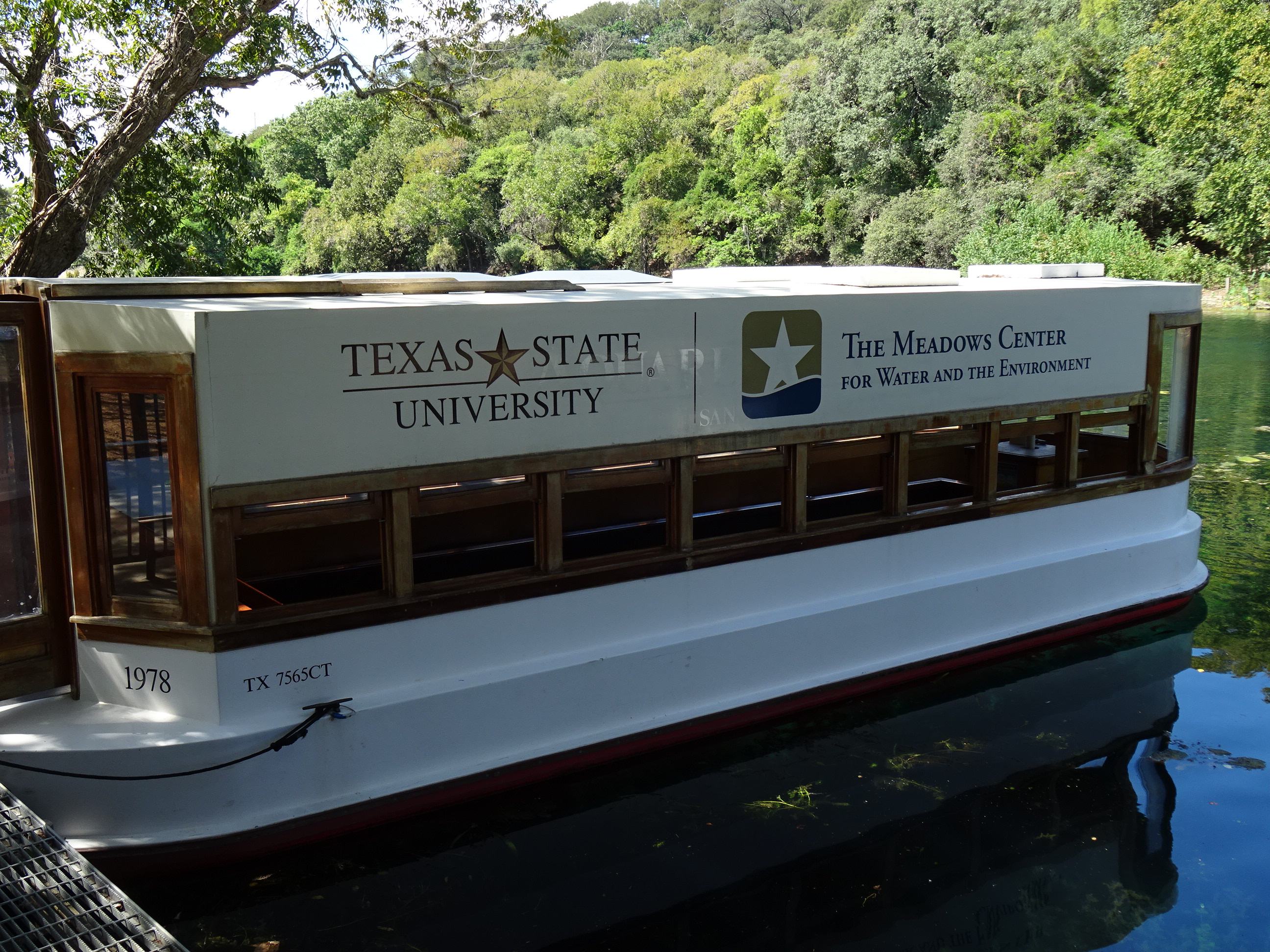
Wetlands are archetypal bio-geomorphic systems, and Tooth’s invited talk focused on the resilience concept in the context of wetlands in drylands. Starting with the contention that most examinations of wetland resilience have focused on wetlands in coastal and/or more humid regions, the talk summarized more than two decades of research into the geomorphology of South African wetlands, and examined whether these wetlands have shown resilience or nonresilience to drivers including landscape denudation, regional climatic changes, shorter term weather extremes, and human activities. Over the late Quaternary, South African wetlands have exhibited both resilience and nonresilience to these sorts of drivers: some have shown remarkably little change in geomorphological processes and form over many thousands of years (i.e. resilience), but others have undergone profound changes in channel-floodplain structure that are effectively nonreversible on the timescale of centuries of even thousands of years (i.e. nonresilience). The take home message was that geomorphologists can help apply the resilience concept in wetland management, but greater consideration needs to be given to how geomorphological resilience interfaces with other resilience dimensions, especially ecological resilience and socioeconomic resilience, the latter commonly being defined in terms of ecosystem service delivery.
Given the more common focus on the resilience of coastal, fluvial and hillslope systems, Tooth’s talk helped to raise the profile of research into wetlands in drylands and the associated activities of the WiDs Research Network. A full set of articles from the symposium will be published in a special issue of Geomorphology (anticipated late 2017 or early 2018), with many already available from the ‘Articles in press’ section of the journal’s website.
—
WIDS2017 fieldtrip
An outline of the themes arising from the post-meeting fieldtrip to the Macquarie Marshes is now available at:
https://stephentooth.wordpress.com/2017/08/03/453/
—
WIDS2017 Day 3
Day 3 of WIDS2017 featured a morning session devoted to Indigenous knowledge and management of wetlands in drylands.
Dr Emily O’Gorman chaired a session wherein Uncle Phil Duncan shared some of his extensive experience working in natural resource management, and set an agenda for strong and productive partnerships with Indigenous people and their communities.
Uncle Phil Duncan presents an original artwork to Dr Tim Ralph as a gift in recognition for organising the WIDS2017 conference.
Danielle Flakelar outlined ways in which Wayilwan people are using the ’empowerment model’ to assert their voices in decision-making concerning water planning and management, and shared personal reflections on working across cultures.
Dr Emilie Ens described her ‘two-way’ approach to cross-cultural wetland science in Arnhem Land in northern Australia, and shared some of the social, cultural and environmental successes that have stemmed from this work.
In closing the conference, Professor Stephen Tooth and Dr Tim Ralph reflected on the ideas, opportunities and challenges emerging from the presentations and workshops. The need to facilitate knowledge transfer between science and management, as well as broader environmental education, came through in the proceedings, along with the need to address important knowledge gaps in areas such as biogeochemistry and carbon storage. Finally, research on wetlands in drylands was placed in a global context in terms of its potential to contribute meaningfully to meeting global challenges, such as climate change, food and agriculture, water and human health.
—
WIDS2017 Day 2
Day 2 was focused on ecology, resilience and sensitivity. Engaging keynotes by Dr Denise Schael, Dr Phumulele Gama and Max Finlayson stimulated productive discussions on vulnerability and dynamic landscapes.
Dr Peter Berney and Tim Hosking shared their experiences in land and water management. They emphasised the importance of building and maintaining strong relationships between scientists, managers and other stakeholders to meet challenges facing wetlands in drylands.
Great session on science in #wetlandsindrylands management and delivery of Environmental Water @OEHmedia #WIDS2017MQ @EnvScMQ
— Kirstie Fryirs (@Kirstie_F) July 25, 2017
Following the keynotes and workshops, discussions continued in a more social setting at the bar. Day 3 will explore Indigenous knowledge and management, and look towards the future for research on – and management of – wetlands in drylands. 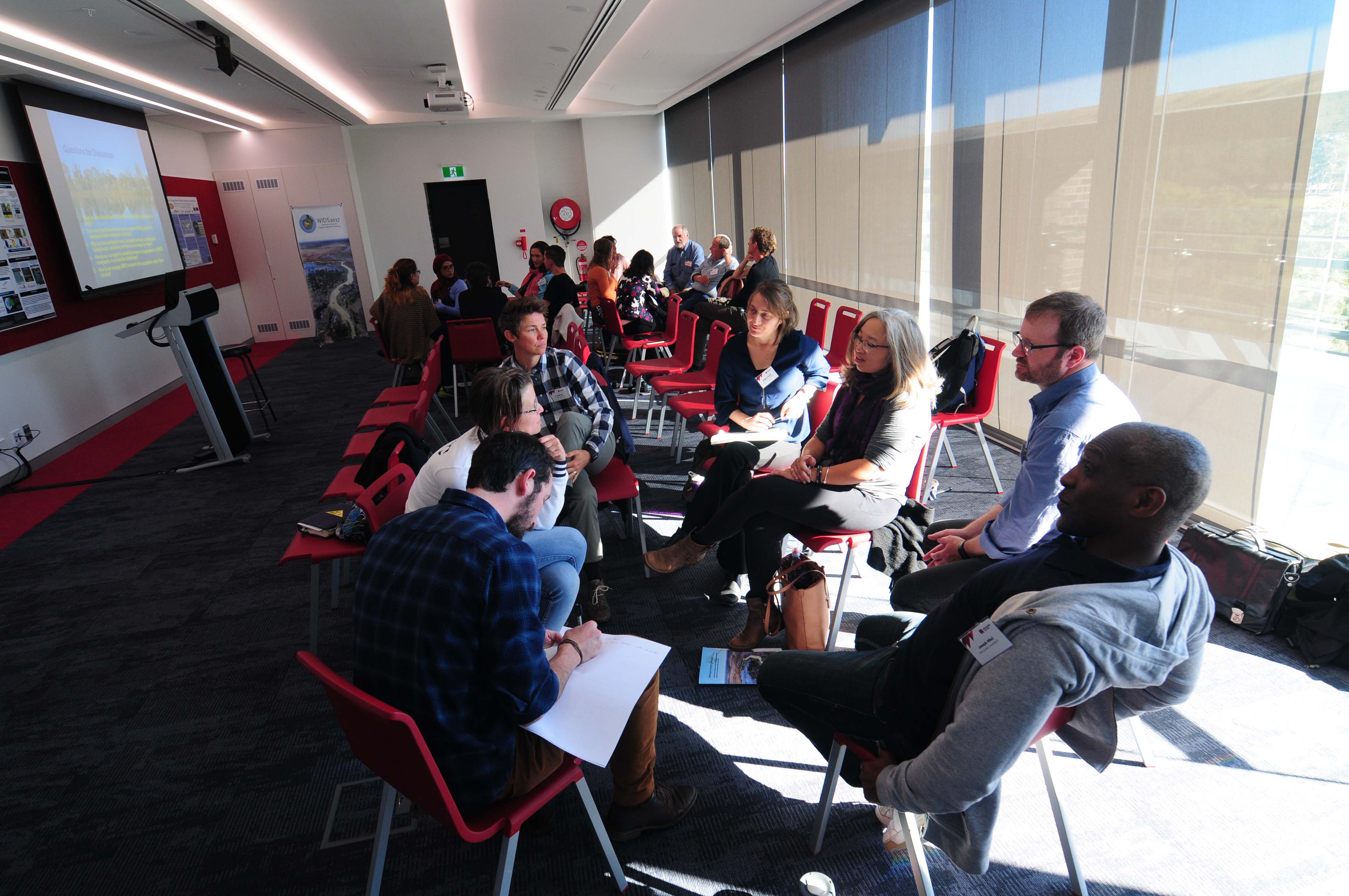
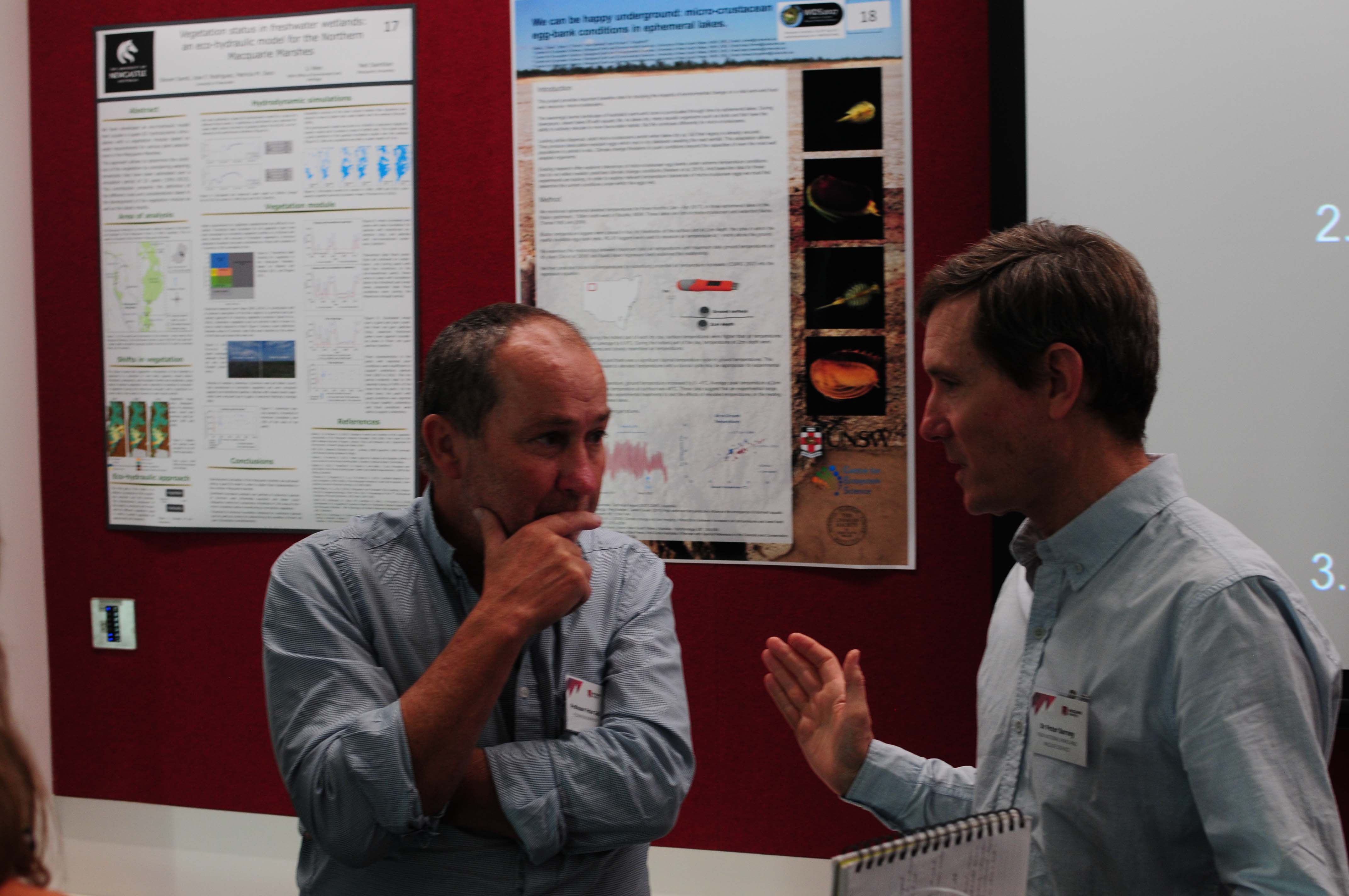
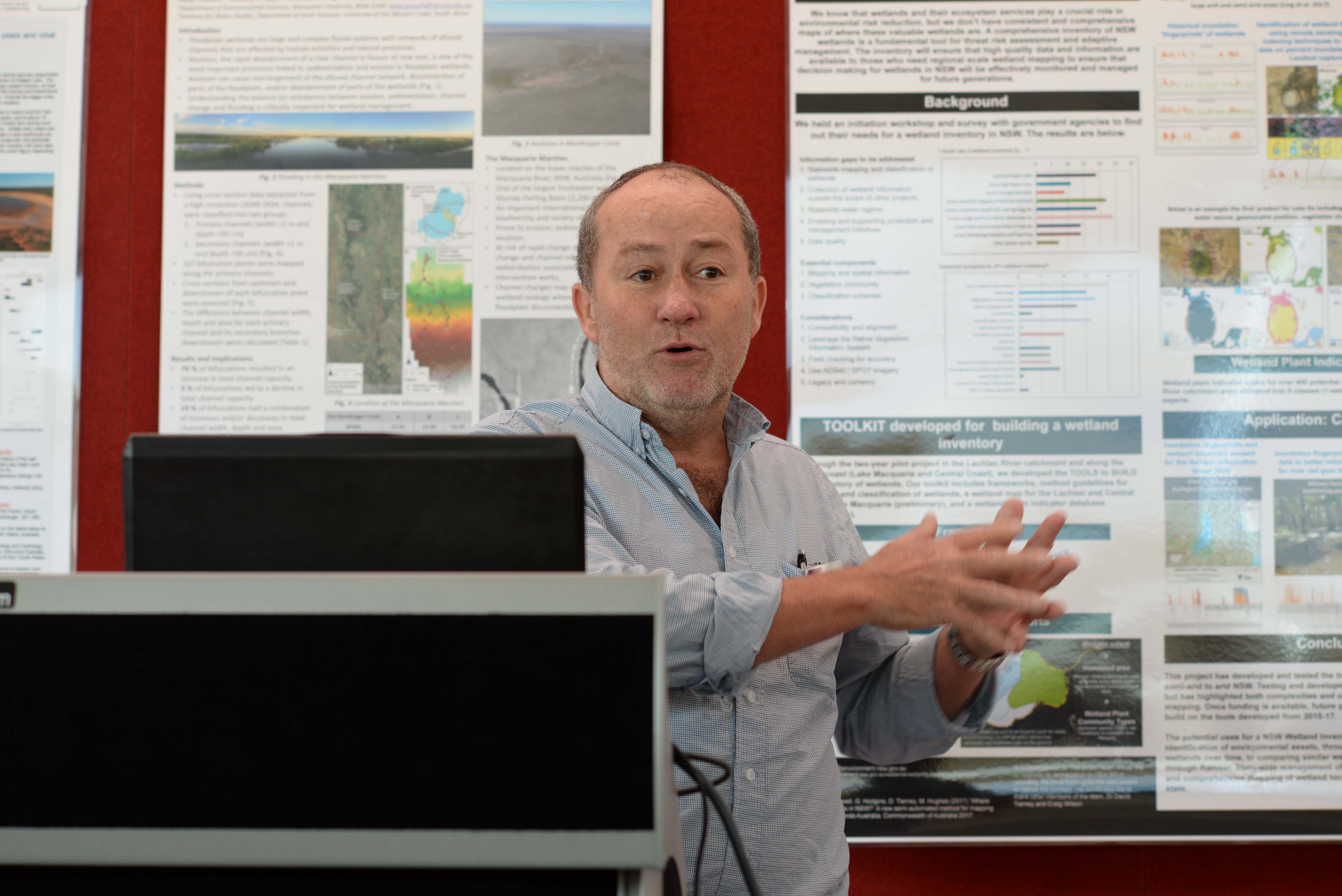
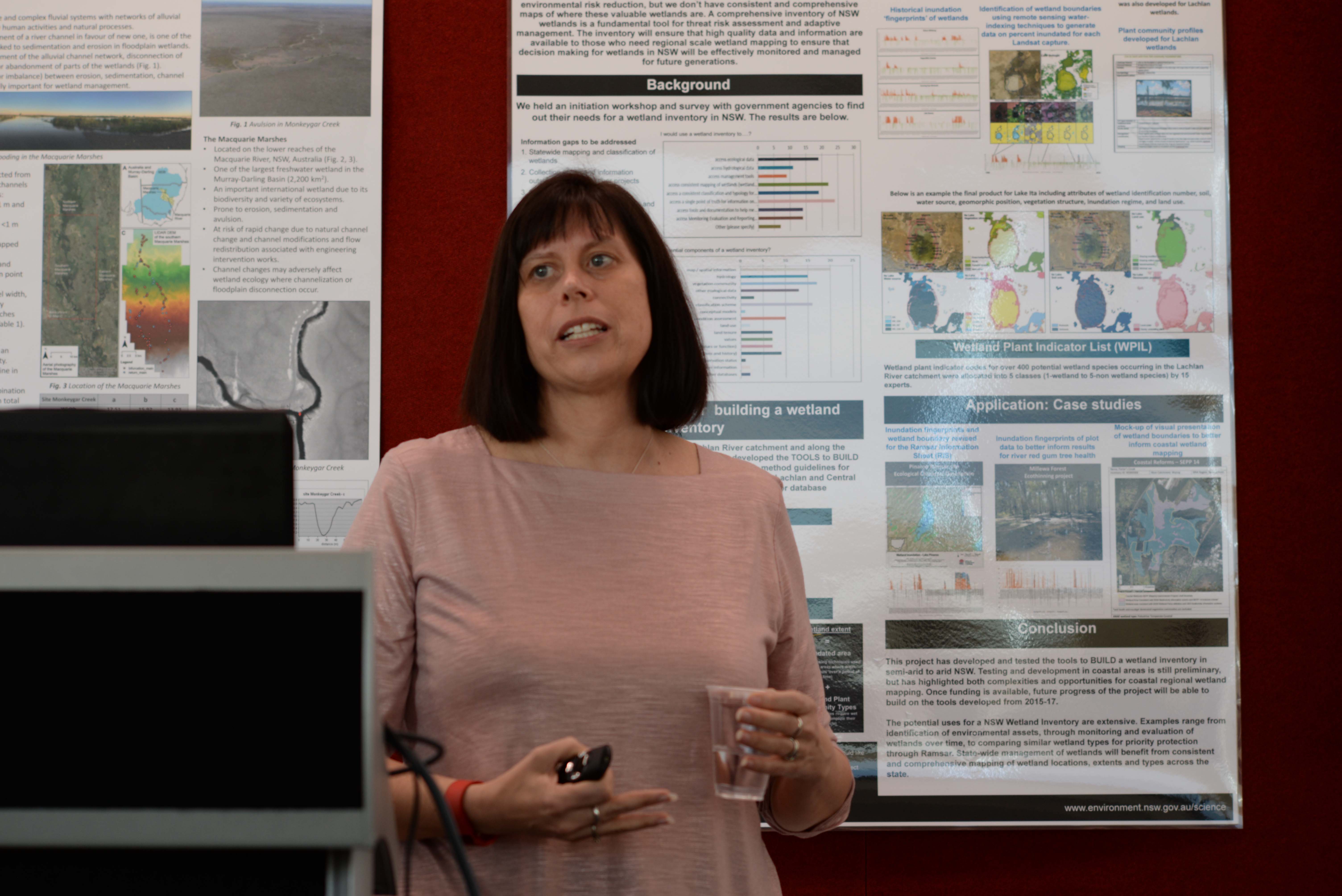
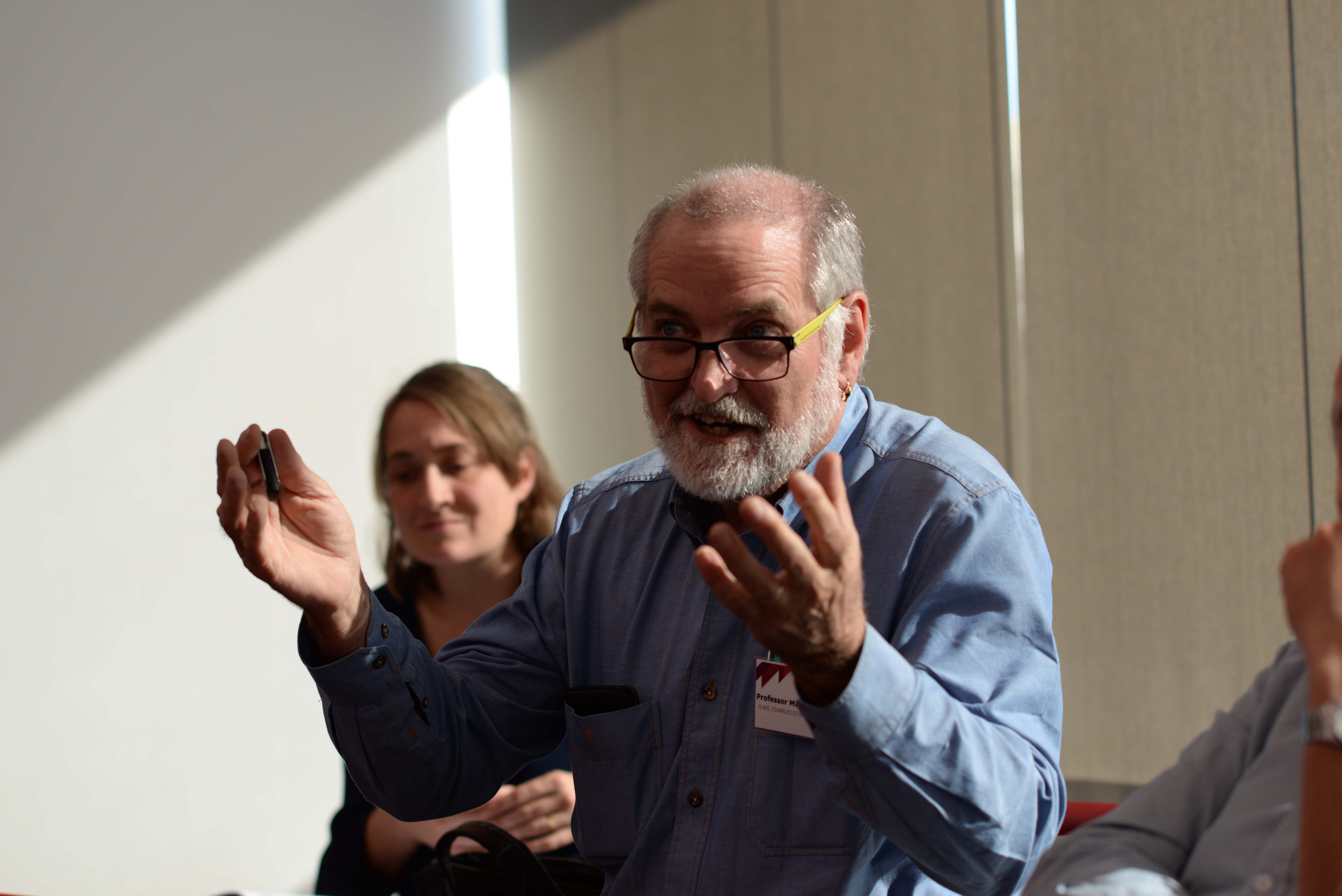
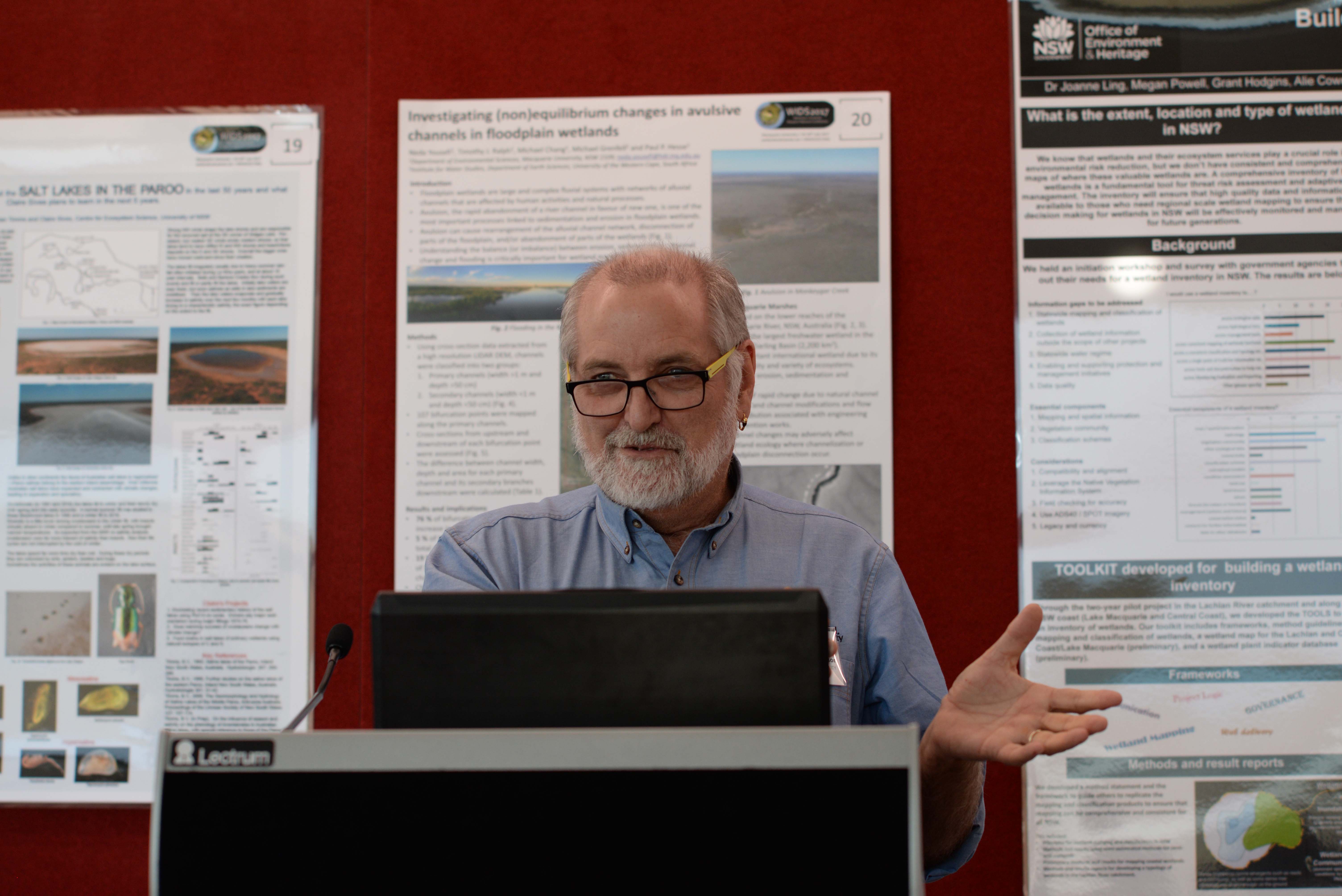
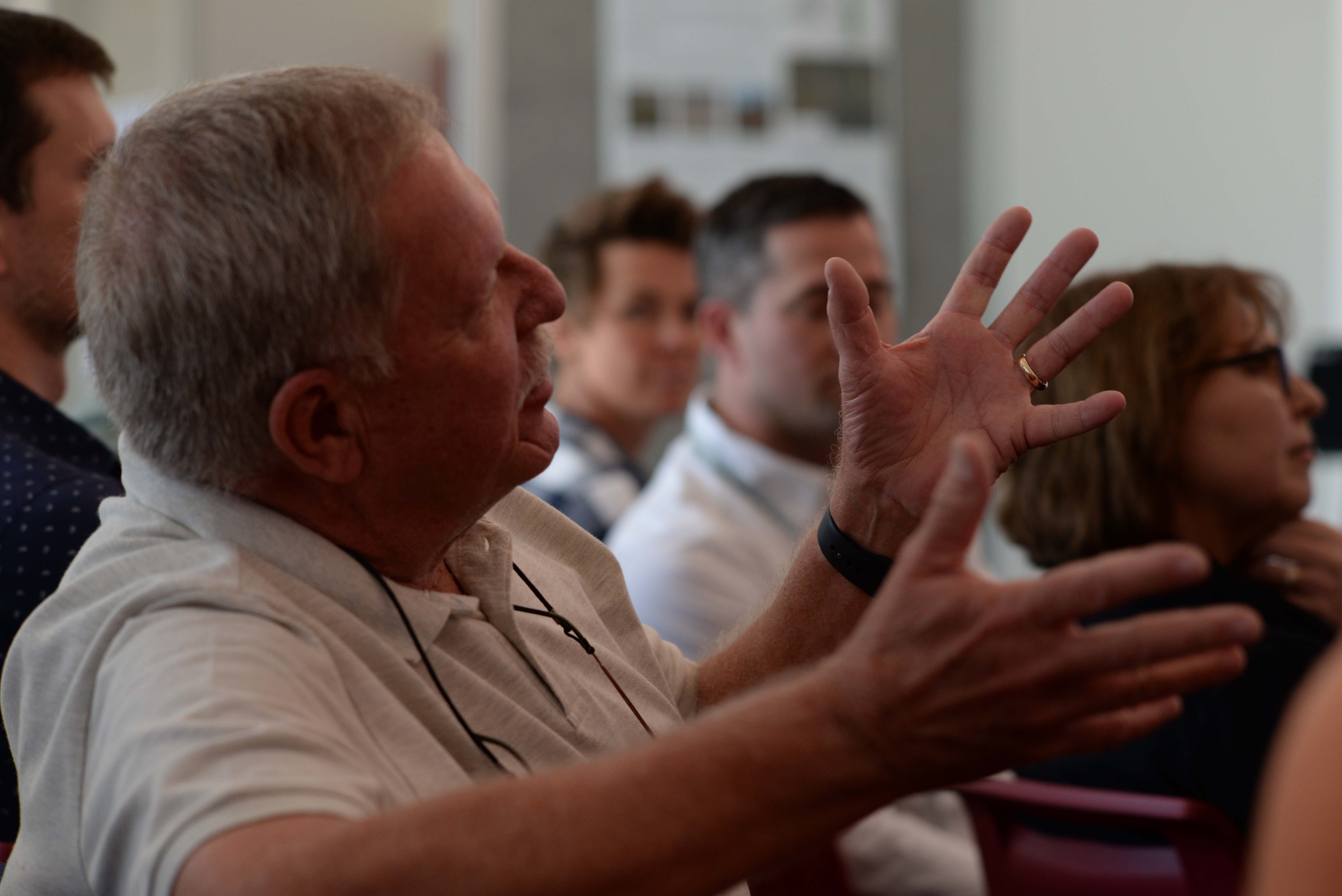
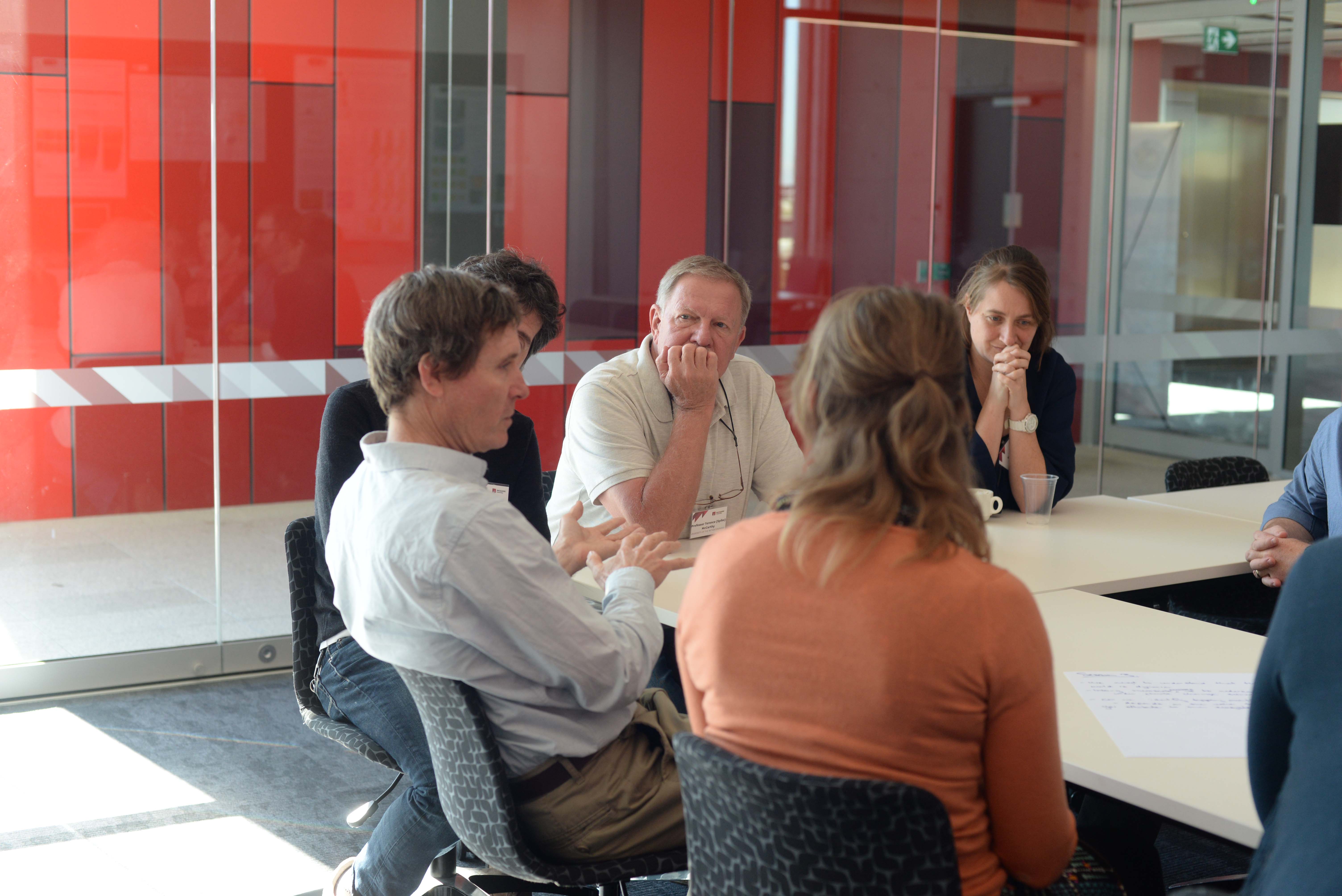
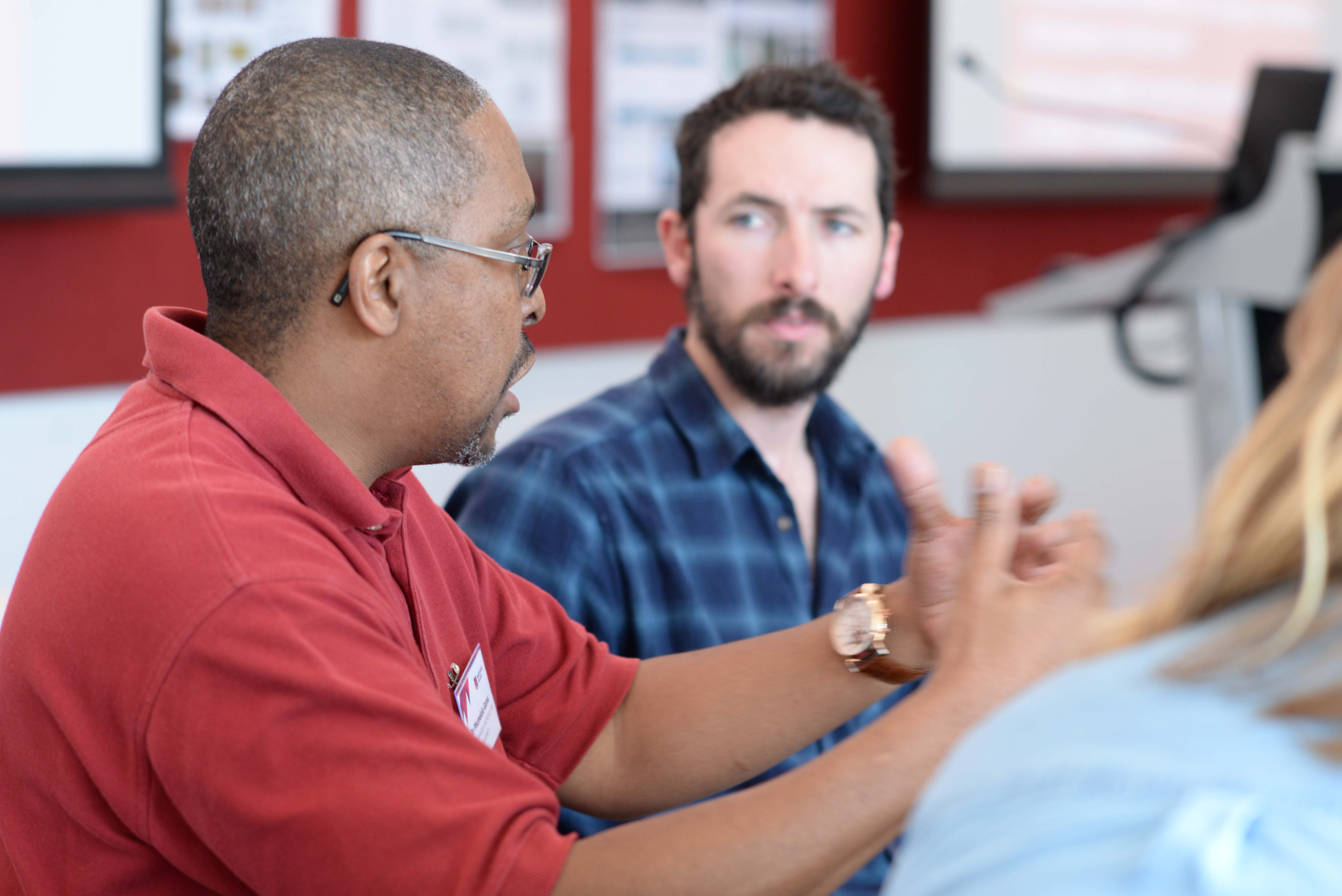
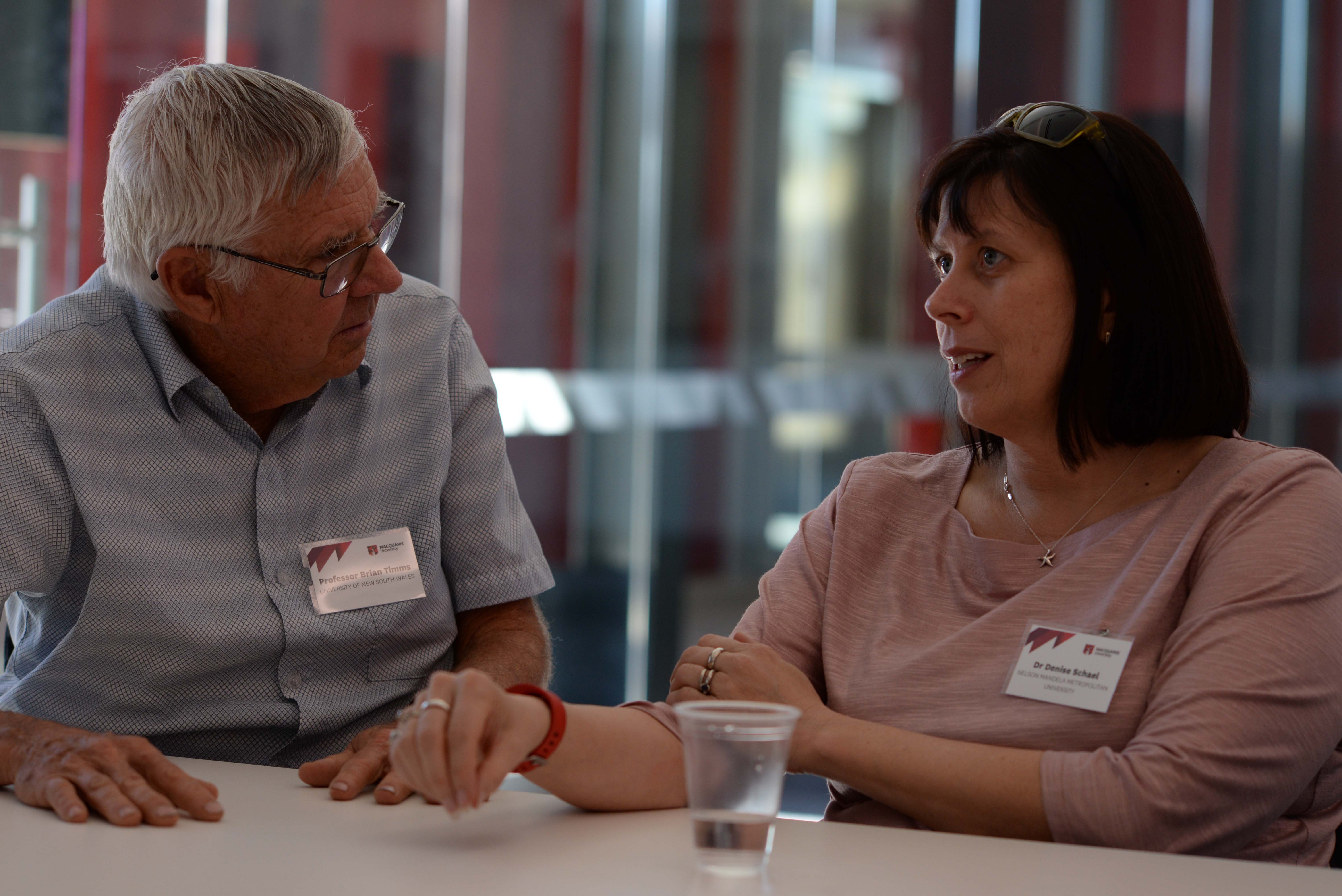

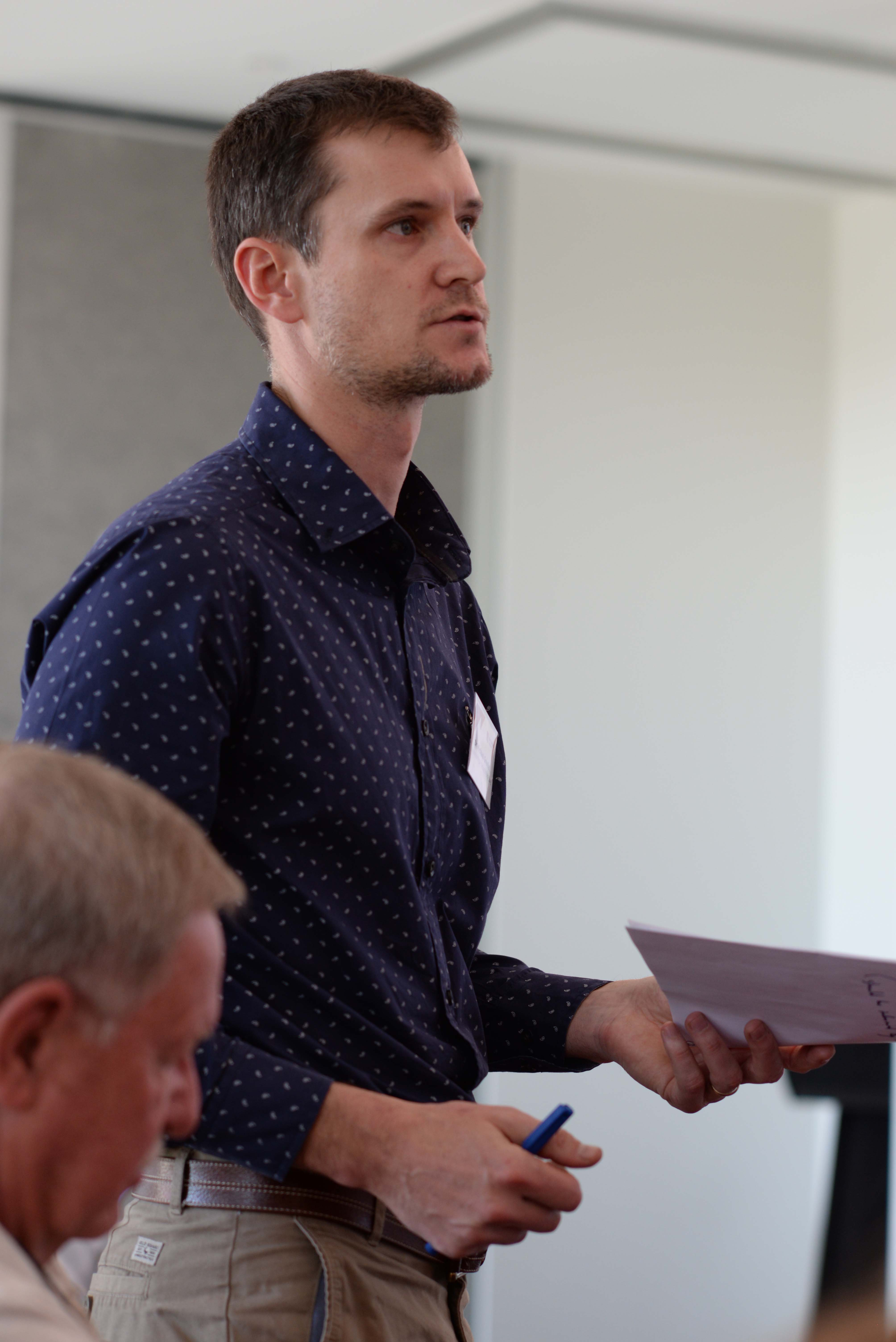
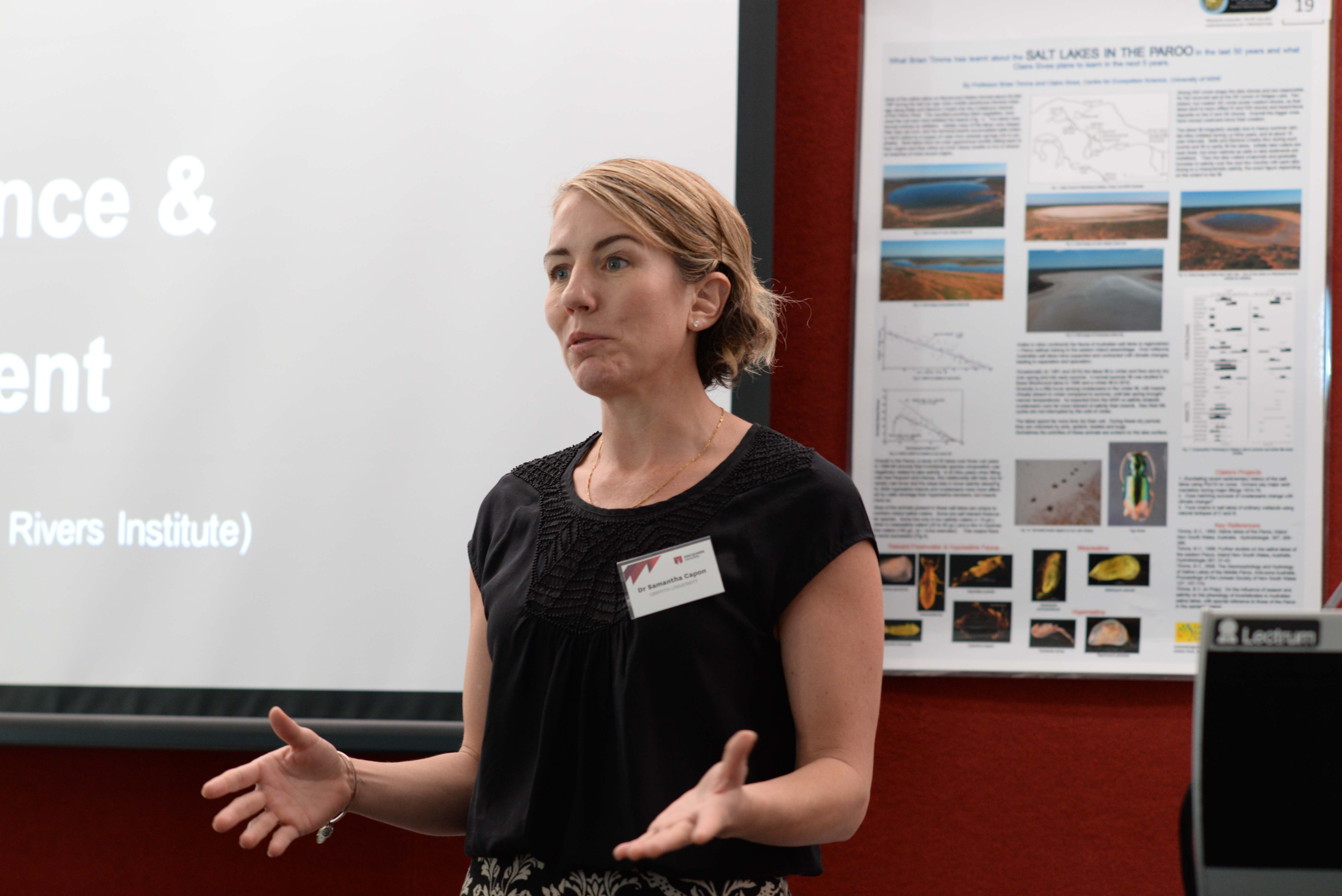
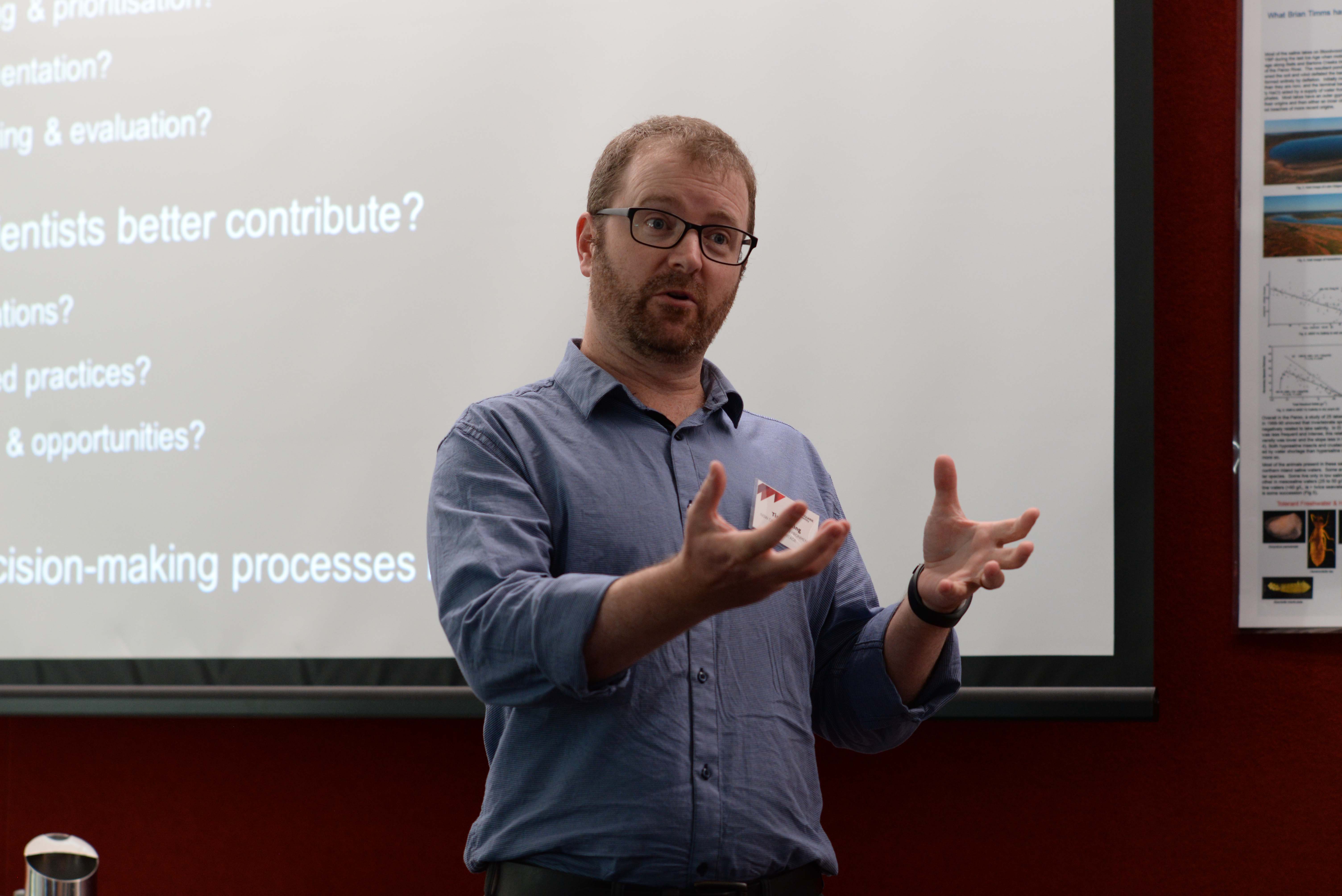
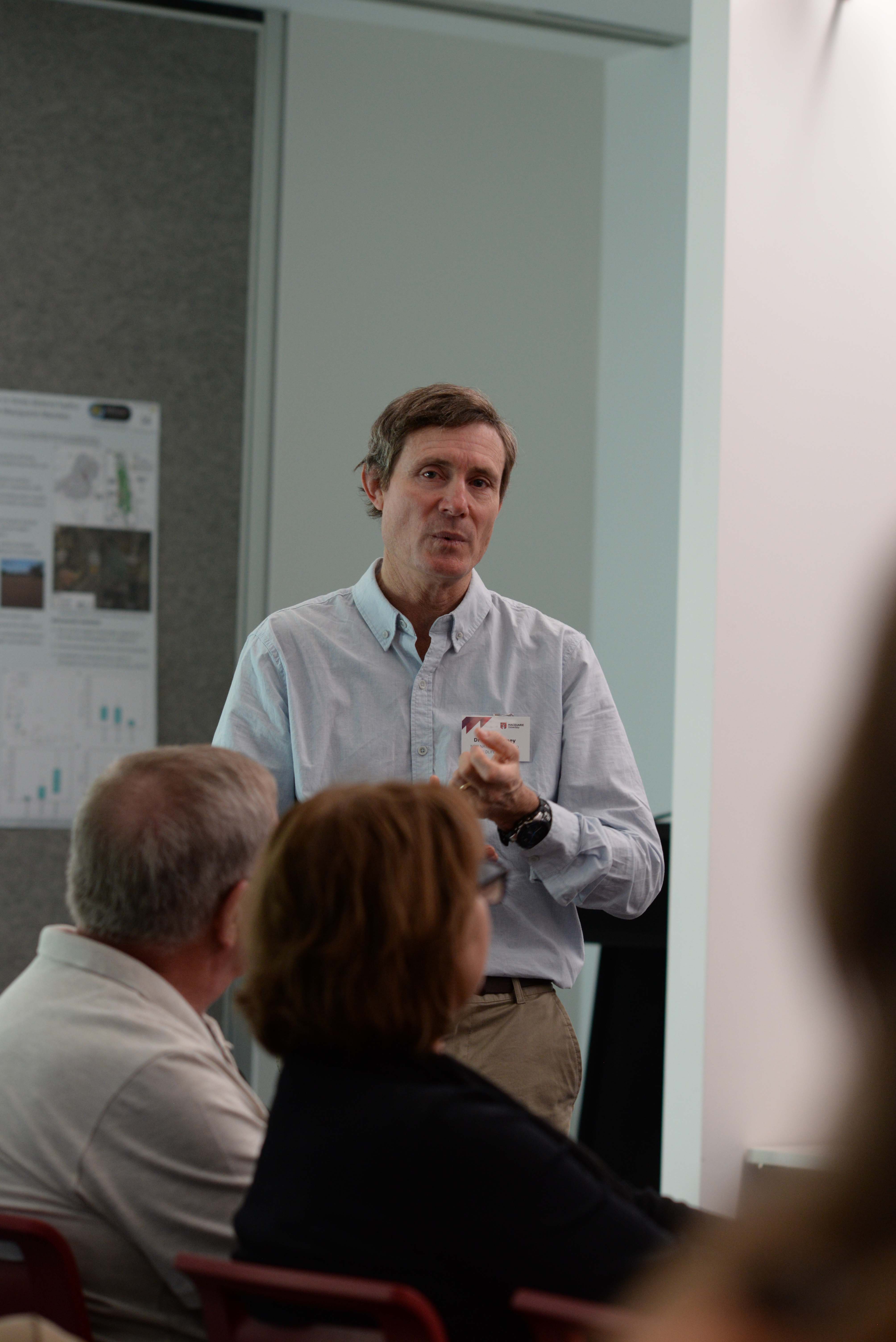 — WIDS2017 Day 1
— WIDS2017 Day 1 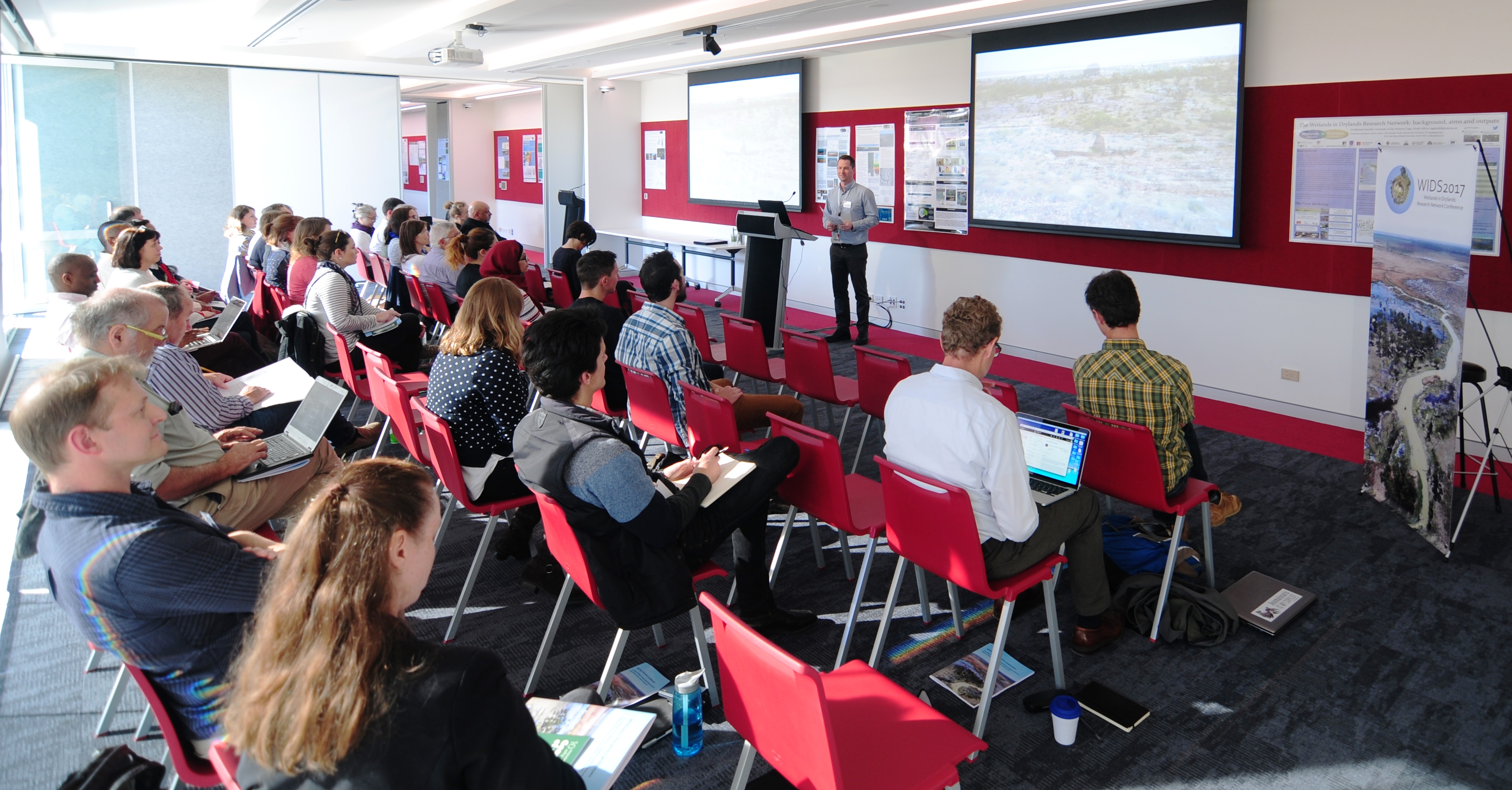 WIDS2017 is off to a cracking start at Macquarie University, Sydney, Australia. After a Acknowledgment of Country performed by Uncle Phil Duncan, Professor Lesley Hughes placed a climate change lens over the Wetlands in Drylands theme in her opening address to the conference.
WIDS2017 is off to a cracking start at Macquarie University, Sydney, Australia. After a Acknowledgment of Country performed by Uncle Phil Duncan, Professor Lesley Hughes placed a climate change lens over the Wetlands in Drylands theme in her opening address to the conference.
Uncle Phil Duncan – welcomes us to country #WIDS2017MQ #wetlands in #Drylands has started pic.twitter.com/SphVHh5XJq — Mirela Tulbure (@MirelaGTulbure) July 23, 2017
Keynotes by Professor Stephen Tooth, Dr Mirela Tulbure and Emeritus Professor ‘Spike’ McCarthy formed a basis for workshopping key opportunities and challenges in smaller groups.
Stephen Tooth discussed global challenges facing wetlands in drylands and encouraged delegates to consider the bigger picture. Mirela Tulbure presented on advances in basin-scale hydrological modeling and the opportunities provided by big data. Spike McCarthy gave insights into the complex geochemistry of the Okavango Delta, drawing on over 30 years of research in this dynamic environment.
In the afternoon, postgraduate students competed in a ruthless round of ‘Three-minute Thesis’ in which they briefly summarised their research. The session was supported by the Oceania Chapter of the Society of Wetlands Scientists. Zacc Larkin and Mackenzie Austin were the joint winners for their talks on avulsion in the Okavango Delta and fire mapping in wetlands, respectively.
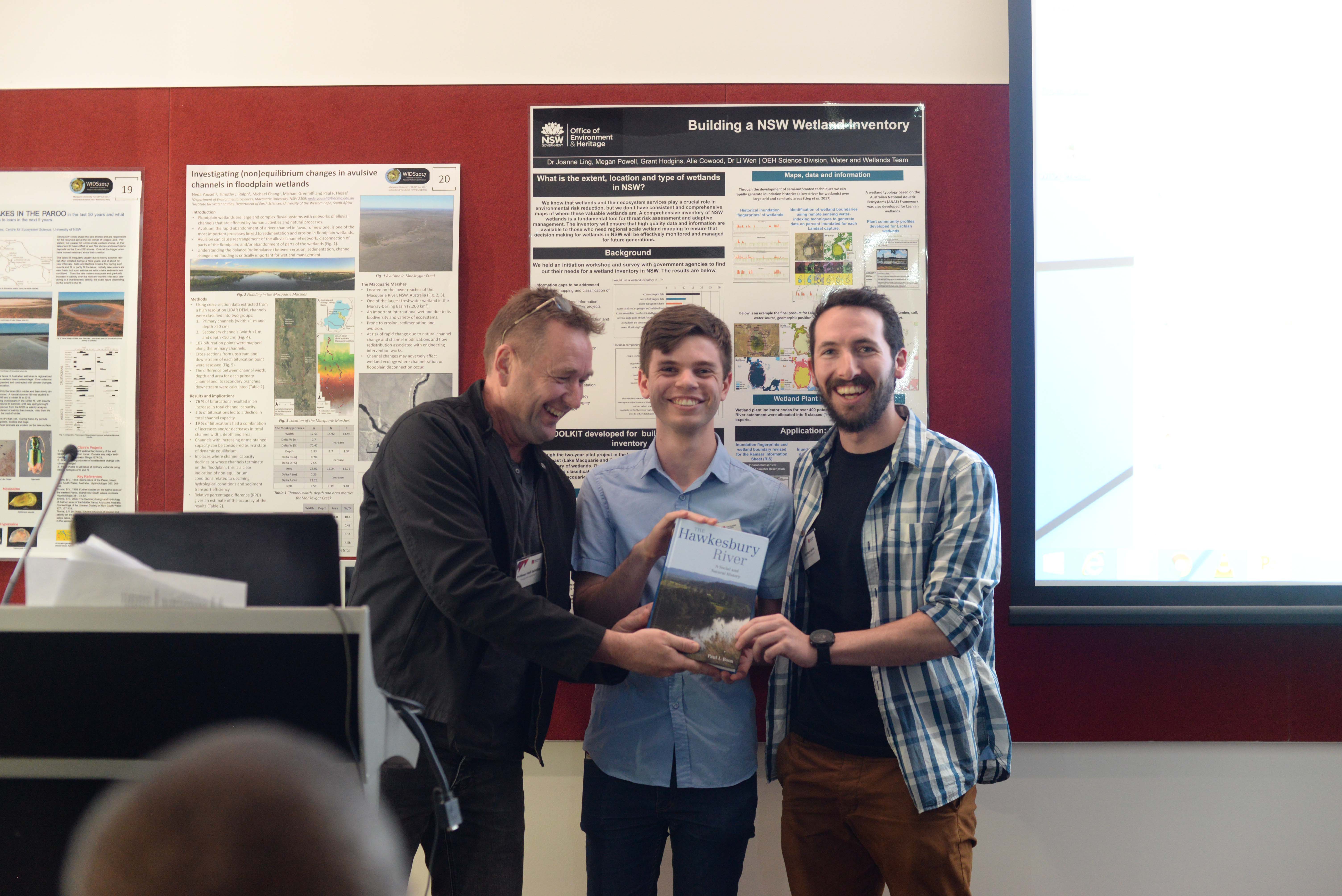 Neil Saintilan presents prize to winners of the 3 Minute Thesis Session Follow the #WIDS2017MQ hashtag on Twitter to keep up to date with the rest of the proceedings.
Neil Saintilan presents prize to winners of the 3 Minute Thesis Session Follow the #WIDS2017MQ hashtag on Twitter to keep up to date with the rest of the proceedings.
@timjralph opening the #WIDS2017MQ conference @EnvScMQ @MQSciEng #wetlandsindrylands pic.twitter.com/9UcvAyPx1l — Kirstie Fryirs (@Kirstie_F) July 23, 2017
—
WIDS2017 Second Circular: Wetlands in Drylands Research Network Conference, Macquarie University (Sydney, Australia), 24-26 July 2017
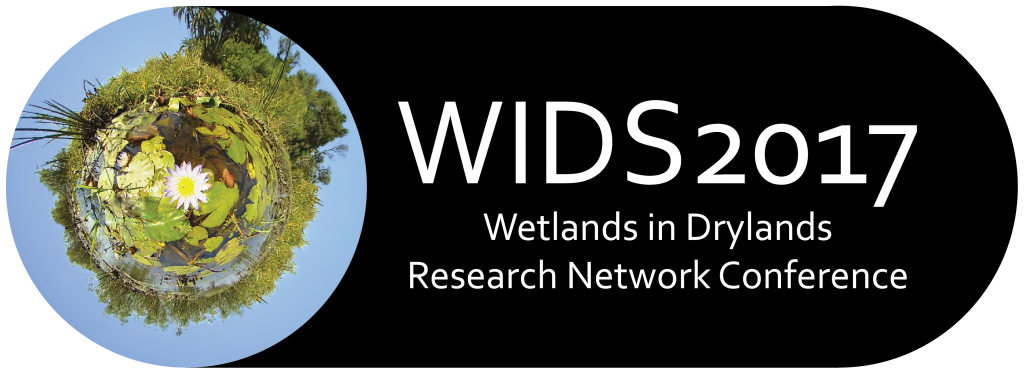
WIDS2017 is the second meeting of the WIDS Research Network, to be held at Macquarie University (Sydney, Australia) from 24-26 July 2017.
Participation by international scientists, practitioners, managers, and early career and postgraduate researchers is encouraged and highly valued.
The program will include seven core interactive sessions that will combine formal keynote presentations with panel and group discussions framed around the following topics:
- Hydro-geomorphological dynamics (e.g. inundation regimes, river channel change, landscape evolution)
- Ecological dynamics (e.g. aquatic ecosystem metabolism, vegetation succession, aquatic biota)
- Biogeochemical dynamics (e.g. nutrient cycling, carbon dynamics, fire regimes)
- Socio-cultural dynamics (e.g. changing perspectives on wetlands, adaptive and inclusive management approaches)
- Sensitivity and resilience (an integrative session)
- Linking science and management (an integrative session)
- Future outlooks
—
Another research paper on the Tshwane floodplain wetlands, northern South Africa
Another round of congratulations is owed to Zacc Larkin, a Macquarie University PhD student (see ‘Student Spotlight’ page), who has just had another paper based on part of his MRes thesis accepted for publication. The paper by Larkin and others is entitled ‘Timescales, mechanisms, and controls of incisional avulsions in floodplain wetlands: insights from the Tshwane River, semiarid South Africa’ and will be published in the international journal ‘Geomorphology’ (doi: 10.1016/j.geomorph.2017.01.021).
Building on the broad scale treatment of river channel and floodplain wetland characteristics in the Tshwane and Pienaars catchments (see the allied ‘Earth Surface Processes and Landforms’ paper highlighted in the news item below), this paper focuses on the avulsion history of a 4 km-long reach of the vertically aggrading lower Tshwane River. Aerial imagery, geomorphological and sedimentological data, and optically stimulated luminescence (OSL) dating is used to establish that three avulsions have occurred along the reach in the last 650 years. Avulsions occur through an incisional mechanism, whereby a headcutting channel on the floodplain extends upvalley during periods of overbank flow, ultimately diverting flow and sediment from the original channel, which is then abandoned. The last avulsion occurred between 1950 and 1972, and led to abandonment of one highly sinuous reach and formation of a new, straighter reach on the western floodplain margin. Recent aerial imagery (see below) also shows clearly that other sinuous reaches of the river are being primed for avulsion through a similar incisional mechanism. The strong implication is that individual avulsion events are driven by intrinsisic (autogenic) processes as a natural outcome of meander belt development, rather than necessarily being related to changing hydroclimates.
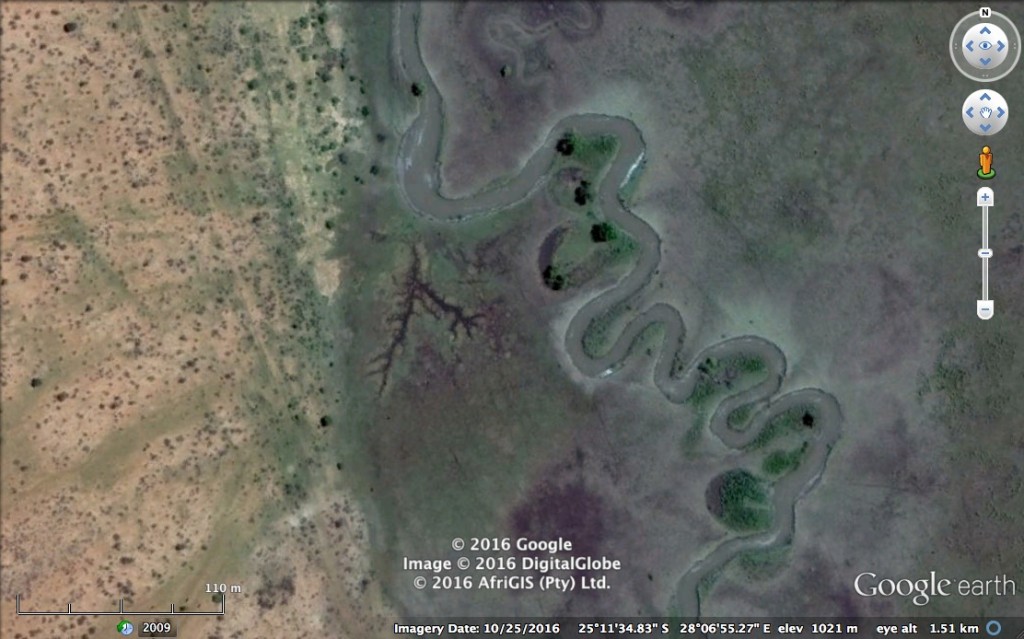
The findings from the Tshwane River support the assumption that avulsion frequency and sedimentation are broadly correlated, and demonstrate that incisional avulsions can occur even in settings with relatively rapid aggradation. Attempts to undertake global comparisons, however, reveal just how few OSL- or radiocarbon-constrained avulsion datasets exist, especially for wetlands in drylands. In South Africa, there is now a sample size of two, namely the Klip River (Tooth and others, 2007, 2009) and the Tshwane River (Larkin and others, 2017). Additional studies are badly needed so that we can build on this work and further clarify the timing, mechanisms, and controls of avulsion in a wider range of wetlands in drylands.
As a start, and if seeking out remote field sites is enticing, how about these examples of avulsive rivers in floodplain wetlands in the drylands of Argentine Patagonia?
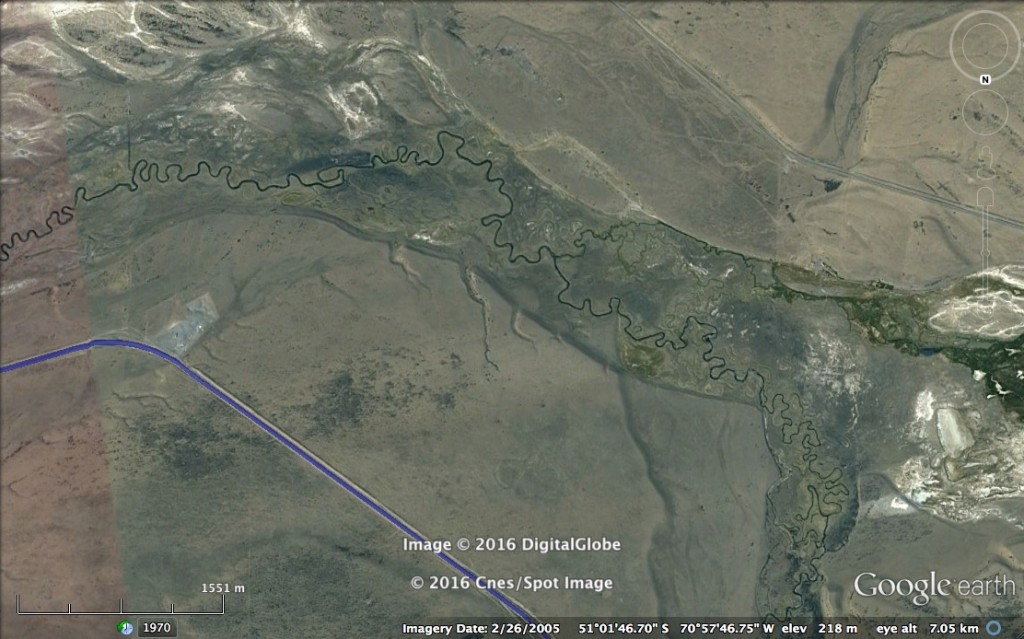 Stephen Tooth noticed these valleys during a flight from El Calafate to Ushuaia last spring. Google Earth imagery (oriented with south to the top to reflect the flight line) reveals that the meander bend, anabranch and avulsion dynamics are taking place within underfit valleys. In many places, these valleys bear the unmistakable hallmarks of former braided channel networks that were probably conveying major floods during the late Pleistocene deglaciation of this part of South America.
Stephen Tooth noticed these valleys during a flight from El Calafate to Ushuaia last spring. Google Earth imagery (oriented with south to the top to reflect the flight line) reveals that the meander bend, anabranch and avulsion dynamics are taking place within underfit valleys. In many places, these valleys bear the unmistakable hallmarks of former braided channel networks that were probably conveying major floods during the late Pleistocene deglaciation of this part of South America.
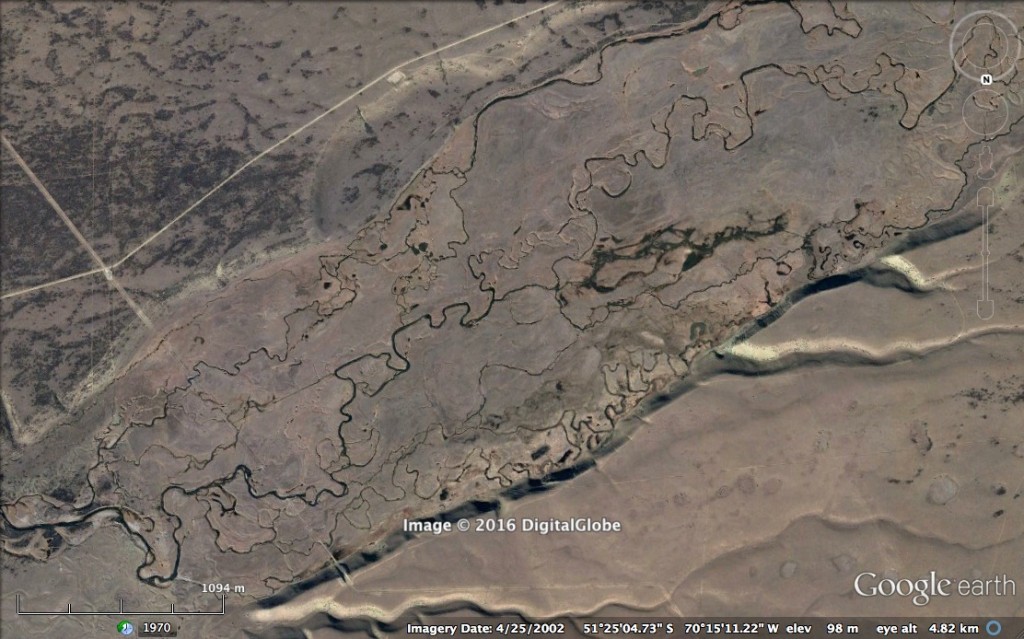 Does anyone fancy crowd sourcing a project to try and obtain some avulsion chronologies from these systems?!?
Does anyone fancy crowd sourcing a project to try and obtain some avulsion chronologies from these systems?!?
—
World Wetlands Day 2017, 2nd February 2017
Given the title of this Ramsar cartoon (‘Some Dry Facts About Wetlands’), how could we not feature this on a site dedicated to wetlands in drylands?
—
New research paper on the Tshwane-Pienaars floodplain wetlands, northern South Africa
Congratulations to Zacc Larkin, a Macquarie University PhD student (see ‘Student Spotlight’ page), who has just had a paper based on part of his MRes thesis accepted for publication. The paper by Larkin, Ralph, Tooth and McCarthy is entitled ‘The interplay between extrinsic and intrinsic controls in determining floodplain wetland characteristics in the South African drylands’ and will be published in the international journal ‘Earth Surface Processes and Landforms’ (doi: 10.1002/esp.4075).
Using analysis of aerial imagery, geological maps and field data, the study investigated floodplain wetland characteristics in the Tshwane and Pienaars catchments, northern South Africa. These impressive floodplain wetlands remain in near-pristine condition but have not been studied in detail previously.
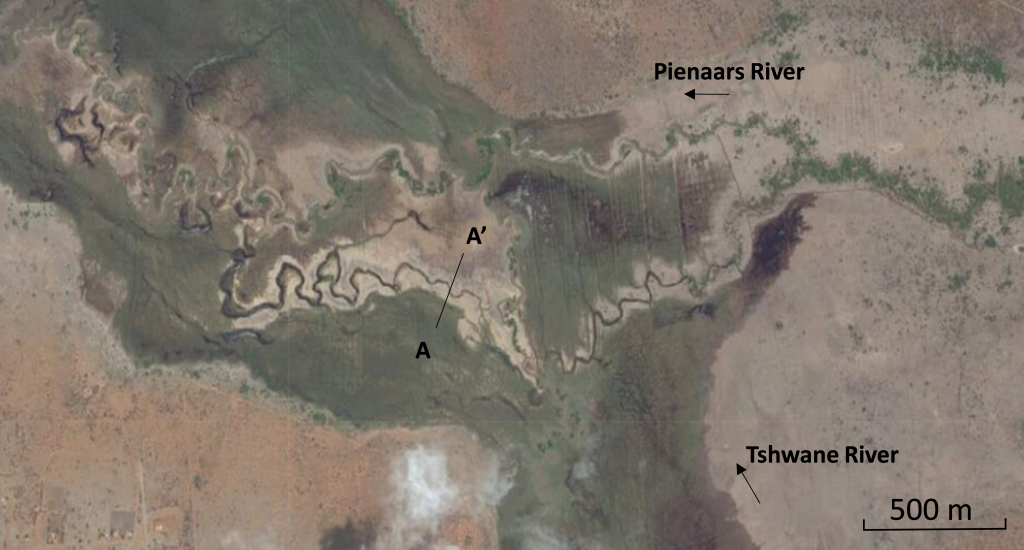
Original research results from the two rivers are combined with the findings from previous research to develop a new conceptual model that highlights the influence of variations in aridity on flow, sediment transport, and channel-floodplain morphology. Similar to the findings of Grenfell, Grenfell and Ellery (2014) in other parts of South Africa, the paper demonstrates how floodplain wetland characteristics vary along a subhumid to semiarid climatic gradient. Increasing aridity tends to be associated with a reduction in the ability of rivers to maintain through-going channels and an increase in the propensity for channel breakdown and floodout formation. The paper concludes by suggesting that improved understanding of the interplay between climate, hydrology and geomorphology may help to anticipate and manage pathways of floodplain wetland development under future drier, more variable climates, both in South African and other drylands.
—
First Circular: Wetlands in Drylands Research Network Conference, 24-25 July 2017
WIDS2017 is the second meeting of the Wetlands in Drylands (WIDS) Research Network, and will take place at Macquarie University in Sydney, Australia, from 24-26 July 2017. Follow the link below for further information.
—
Visit to Hohai University, Nanjing, 22nd-23rd September 2016
Following the running of a successful special session on ‘Wetlands in drylands’ at the INTECOL conference (see news item below), Stephen Tooth and Andrew Thomas visited Hohai University in Nanjing. Aberystwyth University and Hohai University have an articulation agreement to run a 2+2 degree scheme in Environmental Science, with the Chinese students studying the equivalent of Aberystwyth’s Year 1 curriculum over two years and then having the option of coming to Aberystwyth for Years 2 and 3 of the degree. Tooth and Thomas’s visit to Hohai was part of an attempt to facilitate this relationship, and while present, they gave talks on their research and teaching interests, which – as you might easily guess – revolve around wetlands and drylands. Near the start of Tooth’s talk, the assembled staff and students were asked to write down 3, 4 or 5 keywords (in English and Chinese) that they associate with wetlands and with drylands. Some of the responses are below (click image for enlargement), and provide insight into the common perceptions of these environments.
In time, Tooth plans to undertake similar exercises with staff and students in the UK and other academic contexts. This might provide some basis for assessing cross-cultural differences in perceptions of wetland and dryland environments. But what are the first 3 to 5 keywords that you would associate with wetlands in drylands?
—
10th INTECOL International Wetlands Conference, Changshu, China, 18-24th September 2016
Several members of the WiDs Network (Fred Ellery, Donovan Kotze, Zacc Larkin, Andrew Thomas, Stephen Tooth) are currently at the latest INTECOL meeting. All are giving talks, some co-authored with other Network members (Tim Ralph, Erwin Sieben). Many of the talks will be given in a special session convened by Fred Ellery, Stephen Tooth and Tim Ralph entitled: “Wetlands in drylands: enigmatic but neglected ecosystems that are essential for human wellbeing”.
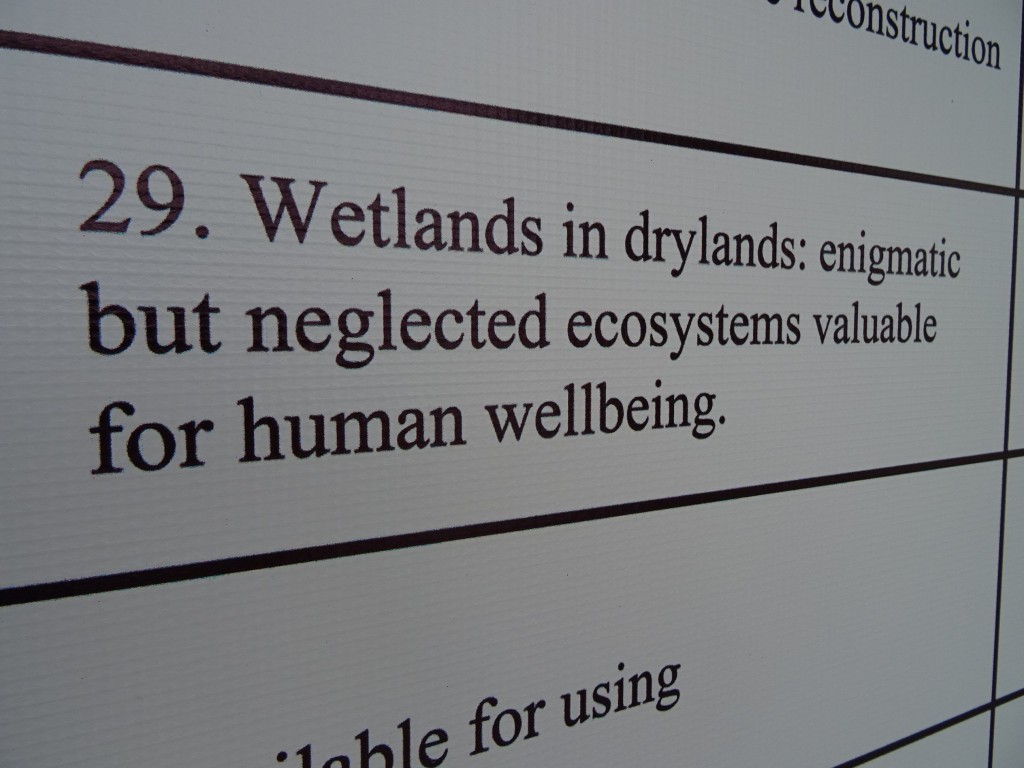 Along with a wide array of plenary keynote talks, symposia, workshops and poster sessions, there is an excellently presented wetlands exhibition that showcases the best of Chinese wetland management, protection, restoration and creation.
Along with a wide array of plenary keynote talks, symposia, workshops and poster sessions, there is an excellently presented wetlands exhibition that showcases the best of Chinese wetland management, protection, restoration and creation.
 Near the main conference hall, delegates have a chance to sign a draft of the Changshu Declaration. The intention is to formally adopt this declaration later in the conference.
Near the main conference hall, delegates have a chance to sign a draft of the Changshu Declaration. The intention is to formally adopt this declaration later in the conference.
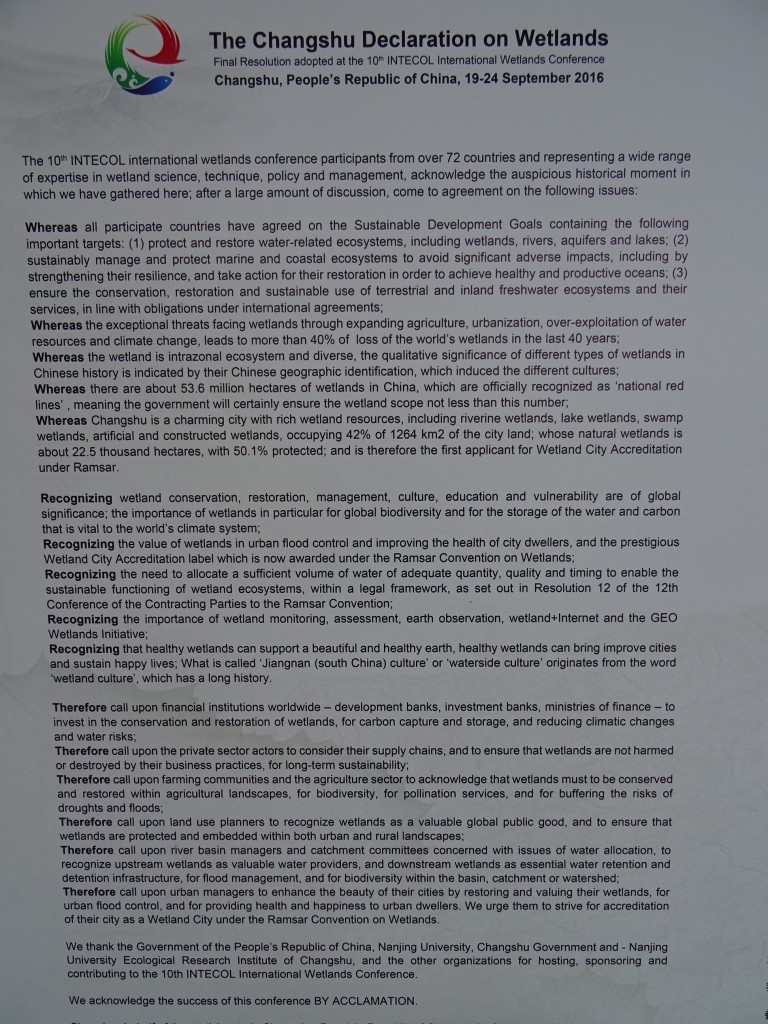 WiDs Network members have been happy to sign the Declaration (see below), but are also taking the opportunity to draw attention to our own Parys Declaration (see the ‘Downloads’ tab). The act of signing has provided amusement among some locals, leading to some photobombing.
WiDs Network members have been happy to sign the Declaration (see below), but are also taking the opportunity to draw attention to our own Parys Declaration (see the ‘Downloads’ tab). The act of signing has provided amusement among some locals, leading to some photobombing.
—
Channel dynamics in the Okavango Delta, 17-27th August 2016
 Several members of the WiDs Network are currently busy in the Okavango Delta, Botswana. Tim Ralph, Zacc Larkin, Marc Humphries and Stephen Tooth are collaborating with other colleagues from Macquarie University, University of the Witwatersrand, and the Okavango Research Institute on a project that is investigating channel and wetland dynamics in the Panhandle region of the Delta. Particular focus is on the changes to river flow, sediment transport and vegetation associated with an ongoing avulsion of the Okavango River near to Sepopa. Following up on work started by Spike McCarthy and colleagues in the mid 1990s, evidence suggests that an increasing proportion of flow and sediment transport is being diverted away from the named Okavango channel into the neighbouring Filipo channel to the east, potentially heralding a wholesale relocation of the channel. Other work will focus on collecting samples for optically stimulated luminescence dating from the abundant large palaeochannels in the Panhandle. Are these channels potentially the upvalley equivalents of the 7-4 ka age palaeochannels preserved near Xugana in the Fan region? Or are they older or younger? Providing an answer will form part of Zacc Larkin’s ongoing PhD thesis.
Several members of the WiDs Network are currently busy in the Okavango Delta, Botswana. Tim Ralph, Zacc Larkin, Marc Humphries and Stephen Tooth are collaborating with other colleagues from Macquarie University, University of the Witwatersrand, and the Okavango Research Institute on a project that is investigating channel and wetland dynamics in the Panhandle region of the Delta. Particular focus is on the changes to river flow, sediment transport and vegetation associated with an ongoing avulsion of the Okavango River near to Sepopa. Following up on work started by Spike McCarthy and colleagues in the mid 1990s, evidence suggests that an increasing proportion of flow and sediment transport is being diverted away from the named Okavango channel into the neighbouring Filipo channel to the east, potentially heralding a wholesale relocation of the channel. Other work will focus on collecting samples for optically stimulated luminescence dating from the abundant large palaeochannels in the Panhandle. Are these channels potentially the upvalley equivalents of the 7-4 ka age palaeochannels preserved near Xugana in the Fan region? Or are they older or younger? Providing an answer will form part of Zacc Larkin’s ongoing PhD thesis.

—
Making space for wetlands …. or not?
Two contrasting articles about wetlands in drylands have featured on websites over the last few months.
1) Research by Tim Ralph and colleagues into channel-floodplain dynamics in the Macquarie Marshes, Australia, has featured on the ‘Riverspace’ website. This website is funded by two non-profit organisations (the Australian River Restoration Centre and Murray-Darling Wetlands Working Group), both of which hope to inspire and support people to care for Australia’s rivers and wetlands. The work by Tim and colleagues draws attention to the long history of channel-floodplain change in Macquarie Marshes, and the fact that small changes to the landforms, or the processes that create landforms, can have a large impact on patterns of water movement and associated ecological responses. These ‘wandering wetlands’ are dynamic, and so conservation and management strategies need to be dynamic as well:
http://www.riverspace.com.au/item/keeping-watch-over-a-wandering-wetland/
2) The deMilked website highlights the work of photographer Johnny Miller and his project entitled “Unequal Scenes”. The Cape Town-based photographer used an Unmanned Aerial Vehicle (UAV, sometimes termed a ‘drone’) in areas around the city to provide a bird’s eye view on physical lines of social inequality. Although the project is intended as social commentary, some of the photographs and the footage from the UAV overflight at the foot of the webpage show just how pressurised are many of these peri-urban wetlands. Here, there is little or no scope to allow wandering wetlands, and the management challenges are quite different:
http://www.demilked.com/drone-photos-inequality-south-africa-johnny-miller/
—
Petition for creation of iconic outback Kidman National Park, central Australia
This petition was started by Rod Moffatt, and calls on the Australian Commonwealth and relevant State Governments to acquire the S Kidman & Co Ltd pastoral leases in the lower Channel Country and lower Lake Eyre basin in order to create a new and iconic outback national park that will rival the achievements of Uluru and Kakadu. Currently, cattle grazing is conducted in areas that are not ecologically sustainable, including internationally significant Ramsar wetlands, riparian corridors, and desert dunefields. At a time when many rivers and wetlands in drylands are under severe pressure, and even existing conservation measures are often poorly implemented (see the Parys Declaration under the ‘Downloads’ tab), creating this national park would help to buck the trend.
Further information and comments from supporters can be see at the petition website:
https://www.change.org/p/act-now-support-petition-to-create-iconic-outback-kidman-national-park
As of 20th July 2016, the petition had attracted 661 supporters. Another 339 is needed for the petition to reach 1000.
—
A Wetland in a Dryland in Iran
Stephen Tooth’s flight to the Linyanti-Chobe-Zambezi floodplain wetlands (see below) involved flying via the Middle East. The flight path from Birmingham to Dubai passed over the spectacular mountainous desert scenery of Turkey and Iran. One particular salt lake near Tabriz in northwest Iran provided good views of rivers terminating in a complex of distributaries, splays and floodouts on the edge of a large salina. Google Earth imagery tags this part of the world as Garegoshon Wetlands International. Nope, me neither. Never heard of them. Does anyone know anything about these wetlands?
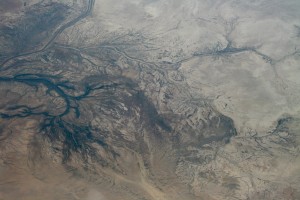
—
The Coupled Dynamics of Human-Dryland River Systems: Linkages and Feedbacks Between Human and Environmental Drivers of Water Quality and Human Health Pt II, 10-20 June 2016
Stephen Tooth has returned to the Linyanti-Chobe-Zambezi floodplain wetlands for follow-up fieldwork on this National Science Foundation-funded project (see earlier post). The annual flood has peaked and water levels have been falling since early May, which happens to coincide with the latest Google Earth imagery. The image below shows part of the Chobe River upstream of Kasane, and reveals a number of small channels that have served as conduits for water and probably small amounts of sediment draining from the floodplains back to the channel. I’m not sure if there is a technical term for these distinctive but likely short-lived, ephemeral features …. does anyone know of a term? If not, how about ‘reverse splays’ as an informal proposition?
—
10th INTECOL International Wetlands Conference, forthcoming Sept 2016
Several members of the WiDs Research Network will be attending the 10th INTECOL International Wetlands Conference in Changshu, China (http://temp.intecol-10iwc.com/EN/HelpCenter/HelpInfo.aspx?nid=14). Fred Ellery, Stephen Tooth and Tim Ralph are convening a special session entitled: “Wetlands in drylands: enigmatic but neglected ecosystems that are essential for human wellbeing”.
Abstracts have been submitted by Stephen Tooth, Tim Ralph, Donovan Kotze, Erwin Sieben and Andrew Thomas. Individually and collectively, these abstracts cover a diverse range of topics and perspectives germane to the analysis of wetlands in drylands and their ecosystem service delivery, and will help to raise the profile of the WiDs Research Network and its activities.
—
The Coupled Dynamics of Human-Dryland River Systems: Linkages and Feedbacks Between Human and Environmental Drivers of Water Quality and Human Health Pt I, 29 Feb-9 March 2016
Stephen Tooth has joined a team of researchers looking at the Linyanti-Chobe-Zambezi system, a vast area of floodplain wetlands located near the borders of Botswana, Namibia, Zimbabwe and Zambia. The project is funded by the National Science Foundation, USA, and led by Kathleen Alexander at Virginia Tech. A press release is at: http://www.vtnews.vt.edu/articles/2015/09/093015-cnre-nsfcnhgrant.html
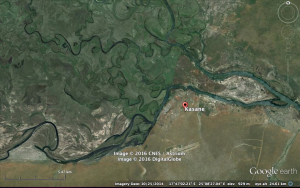
The project is investigating the underlying processes that link the environment, wildlife, domestic animals, and humans in wetlands in drylands, particularly those processes that drive the accumulation and movement of waterborne disease across the landscape. The project is focusing on three significant problems: 1) basic knowledge of the coupled dynamics of fluvial processes and water quality in drylands and the influence of anthropogenic and natural influences on pathogen pollution and health; 2) sociocultural and economic variables that influence waterborne disease dynamics and system feedbacks; and 3) appropriate tools to monitor indicators of system change and intra-annual forecasting ability.
Tooth’s role is to help outline how the complex interactions between hydrological, geomorphological, sedimentary, and ecological processes particular to floodplain wetlands in drylands have an influence on faecal microbial dynamics, water quality, and human waterborne disease risk.
—
South African National Wetlands Indaba, Rawsonville, Western Cape, 20-23 October 2015
The South African National Wetlands Indaba is an annual gathering of scientists, practitioners, consultants, government personnel, and members of NGOs, who share an interest in wetlands. The 2015 meeting was attended by more than 300 people representing more than 30 organisations. Session topics included ‘Urban and Constructed Wetlands’, ‘Wetland Biodiversity’, ‘Wetland Origins, Drivers and Dynamics’, ‘Wetland Plants, Climate and Climate Change’, ‘Wetland Mapping, Monitoring and Assessment’, and ‘Wetland Rehabilitation’.
The Wetlands in Drylands Research Network was well represented at the meeting, with network members and their students presenting 20 papers or posters (amounting to 25% of the scientific programme), including a keynote presentation by Fred Ellery on wetland geomorphology. Abstracts and presentation PDFs are available for download at:
http://indaba2015.wetlands.za.net/programme.htm
To access a presentation PDF, click on the hyperlinked presentation title. This will take you to the Abstract page. The last line of the Abstract is a link to “Download presentation”. The 2016 Indaba will take place at Swadini, Mpumalanga Province, in October.

